Processors chase value, viability

INNOVATIVE ideas such as companies processing stock for competitors are needed to improve the viability of the sheep industry, said the head of one of the country’s largest meat companies.
Alliance Group chief executive Willie Wiese said more value needs to be returned to sheep farmers to improve their viability, and if that can come from greater industry collaboration, then that should be looked at.
He has discussed the idea with other meat companies and said at least two are open to considering the idea.
Could we have a different processing arrangement, some relationship between meat companies?
“It is challenging initially, but something we need to talk about,” said Wiese.
It could mean an end to stock trucks passing competitors’ plants, which would reduce costs, provide animal welfare benefits and lower greenhouse gas emissions, he said.
The Meat Industry Association and five meat companies were asked for comment.
The MIA said it is a company issue, one company declined to comment and none of the others had replied by deadline.
Federated Farmers board member Toby Williams sees merit in the proposal and said following Cyclone Gabrielle last year, plants processed stock on behalf other companies, which shows it can be done.
Change is needed, he said.
“Sheep numbers are not growing, we all know that.
“The industry is effectively in crisis and there is nothing to arrest that slide, no innovation or collaboration.
“The wool industry is in disarray,” said Williams.
Even if two or three companies co-operated with processing it would be beneficial.
“We needed this 10 years ago but meat prices have been quite good so there wasn’t the need.”
Wiese said with sheep numbers forecast to continue falling, companies could face the choice between consolidation or rationalisation.
“Could we have a different processing arrangement, some relationship between meat companies?”
He is confident the sheep industry has a future but said



NZ’s elite cows draw overseas buyers
Australian buyers bought 10 lots of Silverstream Charolais genetics at its special female sale this month, near Christchurch. The top price of $16,000 was paid for Silverstream Suze M5, pictured, an eight-year-old cow.



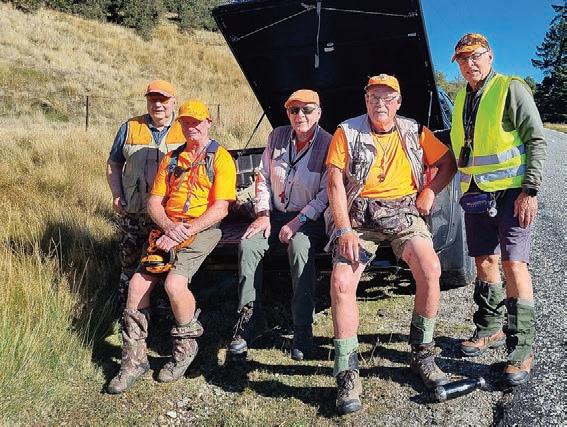
Deep in Central Otago there’s a group of hunters who reluctantly call themselves ‘the last of the summer wine’.
There are questions over SFF’s plate to pasture plan, says Allan Barber.

















VISIT TRU-TEST.COM PH 0800 243 282 Gift valued $799* T’s & C’s APPLY for Budget-Friendly Peace
Mind Tru-Test monitoring system accurately detects heats faster,and ensures silent heat detection in dairy systems. Easy installation, reusable tags, and a chance to win a fence monitoring kit* for advanced livestock management. 1
Explore the Precision of Tru-Test Heat & Health Tags
of
problem
NEWS 3 A hobby that’s reducing a pesky
Vol 22 No 14, April 15, 2024 View online at farmersweekly.co.nz $4.95 Incl GST
16
SHEEP & BEEF 18-22
Going the distance for Farmstrong
The Farmer’s Voice snapshot reveals a rural sector low on confidence. NEWS 3
Agri methane emissions remain a sticking point for NZ to meet targets. NEWS 6
SECTORFOCUS
OPINION 14
Neal Wallace NEWS Sheep and beef
Continued
Willie Wiese Alliance
page 3
EDITORIAL
Bryan Gibson | 06 323 1519
Managing Editor bryan.gibson@agrihq.co.nz
Craig Page | 03 470 2469
Deputy Editor craig.page@agrihq.co.nz
Claire Robertson Sub-Editor claire.robertson@agrihq.co.nz
Neal Wallace | 03 474 9240
Journalist neal.wallace@agrihq.co.nz
Gerald Piddock | 027 486 8346
Journalist gerald.piddock@agrihq.co.nz
Annette Scott | 021 908 400
Journalist annette.scott@agrihq.co.nz
Hugh Stringleman | 09 432 8594
Journalist hugh.stringleman@agrihq.co.nz
Richard Rennie | 027 475 4256
Journalist richard.rennie@agrihq.co.nz
Nigel Stirling | 021 136 5570
Journalist nigel.g.stirling@gmail.com
PRODUCTION
Lana Kieselbach | 027 739 4295 production@agrihq.co.nz
ADVERTISING MATERIAL Supply to: adcopy@agrihq.co.nz
SUBSCRIPTIONS 0800 85 25 80 subs@agrihq.co.nz
PRINTER Printed
SALES CONTACTS
Andy Whitson | 027 626 2269
Sales & Marketing Manager andy.whitson@agrihq.co.nz
Andrew Fraser | 027 706 7877
Auckland/Northland Partnership Manager andrew.fraser@agrihq.co.nz
Jody Anderson | 027 474 6094
Waikato/Bay of Plenty Partnership Manager jody.anderson@agrihq.co.nz
Palak Arora | 027 474 6095
Lower North Island Partnership Manager palak.arora@agrihq.co.nz
Omid Rafyee | 027 474 6091
South Island Partnership Manager omid.rafyee@agrihq.co.nz
Julie Gibson | 06 323 0765
Marketplace Partnership Manager classifieds@agrihq.co.nz
Andrea Mansfield | 027 602 4925
National Livestock Manager livestock@agrihq.co.nz
Real Estate | 0800 85 25 80 realestate@agrihq.co.nz
Word Only Advertising | 0800 85 25 80 Marketplace wordads@agrihq.co.nz

News in brief
Sale approval
Farmlands has been cleared by the Commerce Commission to buy the animal feeds company Seales Winslow.
After initially publishing some concerns with the proposed acquisition, the commission said it is unlikely to substantially lessen competition in any New Zealand market.
Therefore, it has granted clearance for Farmlands Co-operative to buy 100% of the shares of Seales Winslow from vendor Ballance Agri-Nutrients.
Biosecurity awards
Two New Zealanders who’ve used their skills to help fight the exotic caulerpa seaweed are this year’s Biosecurity Awards Supreme Winners.
Arana (Rana) Rewha and Viki Heta (Ngā Hāpu o Te Rāwhiti and Ngāti Kuta rāua Ko Patukeha) received the award for their efforts to prevent further spread of the destructive seaweed in Northland Te Tai Tokerau.
Targeted rates
Waikato Regional Council’s 10-year plan is out for consultation, proposing rate increases for rural landowners to fund rural compliance and biodiversity improvements.
The council’s draft plan proposes an increase in rates revenue from current ratepayers of 6% in 2024-2025, 8% in 20252026 and 3% in 2026-2027. Waikato
Federated Farmers president Keith Holmes said that the council is trying to be responsive to the economic situation facing farmers, but the reality is they cannot afford an increase.
Farmers recognised
Michael and Karen Toulmin have been named the Silver Fern Farms’ Hawke’s Bay Farmers of the Year.
The Toulmins farm Makuranui, a 210 hectare sheep and beef farm located in the Waiwhare District in northwestern Hawke’s Bay. Their operation has a large trading component alongside heifer grazing.


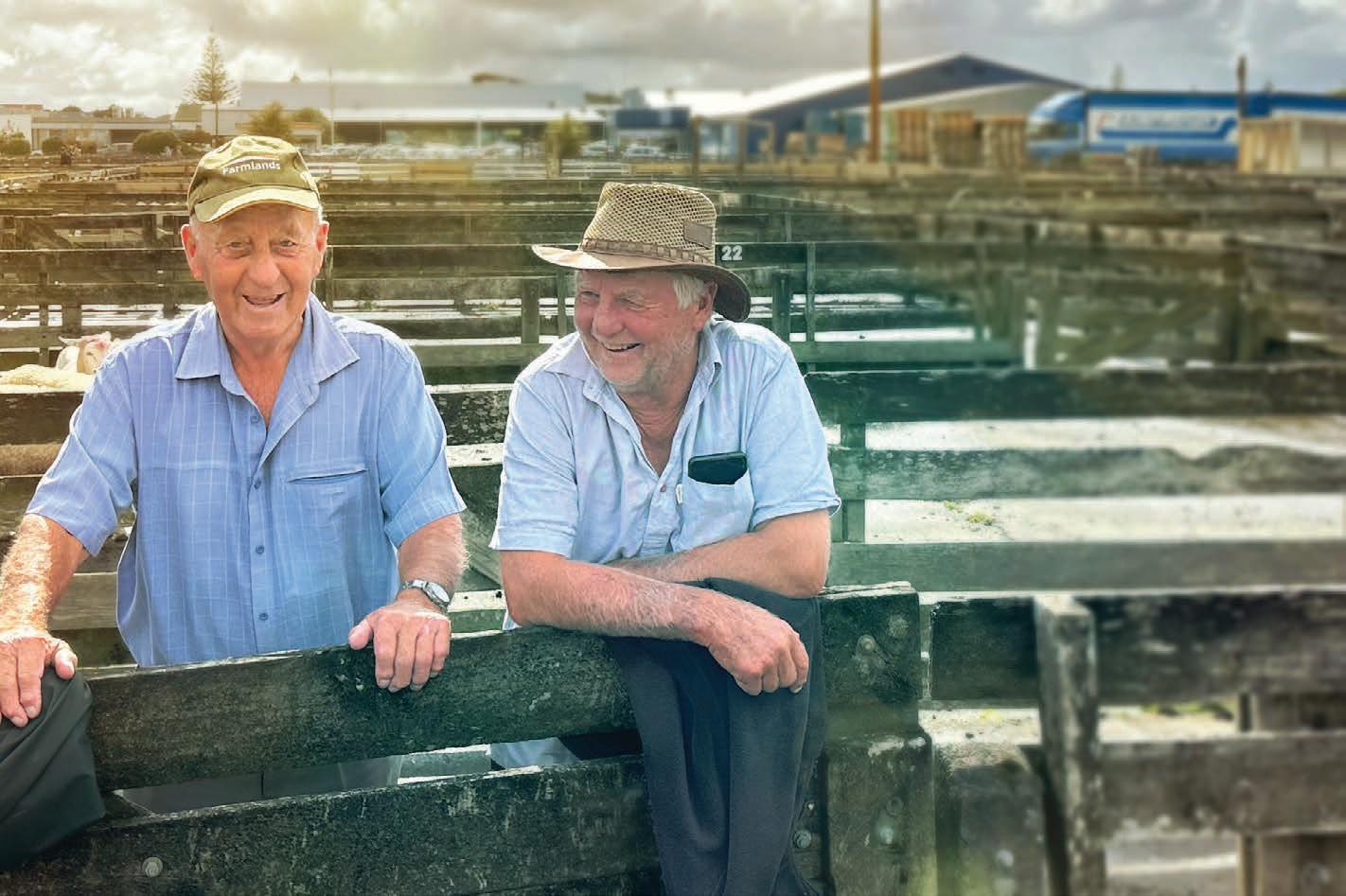

You can find out more about it here: www.agrihq.co.nz/thefarmersvoice To join in with The Farmer’s Voice go to: www.bit.ly/agrihq-tvc The Farmer’s Voice is a new community for New Zealand farmers to share their ideas about what it is like to be a farmer today. We’d like you to tell us what is important to you as a farmer. We’ll share what farmers have to say with everyone who takes part and we’ll let industry and government decision-makers know what is important to farmers. It is FREE to join in and you could win one of three $500 Prezzy Cards just for taking part. Join the conversation, have your say... 2 New Zealand’s most trusted source of agricultural news and information Contents Advertise Get in touch FLOW: Minister for Regional Development Shane Jones says more water storage is key to raising productivity and export earnings. STORY P5 News . . . . . . . . . . . . . . . . 1-11 Opinion . . . . . . . . . . . 12-15 People . . . . . . . . . . . . . . . . 16 Technology . . . . . . . . . . . . 17 Sector Focus . . . . . . . 18-22 Federated Farmers . 23-26 Real Estate . . . . . . . . 27-30 Marketplace . . . . . . . 31-32 Livestock . . . . . . . . . . 32-33 Markets . . . . . . . . . . . 34-39 Weather . . . . . . . . . . . . . . . 40
PUBLISHERS
and Cushla Williamson Phone: 027 323 9407 dean.williamson@agrihq.co.nz cushla.williamson@agrihq.co.nz Farmers Weekly is Published by AgriHQ PO Box 529, Feilding 4740, New Zealand Phone: 0800 85 25 80 Website: www.farmersweekly.co.nz ISSN 2463-6002 (Print) ISSN 2463-6010 (Online)
Dean
by Stuff Ltd
by Reach Media Ltd
Delivered
Continued from page 1
farmers face challenges now from forestry and alternative land use options.
“For sheepmeat to have a viable future, we need to find ways as a sector to be more efficient and bring value back to farmers.”
That requires a different approach and, in some cases, a NZ Inc view.
“Right now we have significant competition within the sheepmeat industry to solve, but we need to find better ways in the future to be competitive.”
He is not advocating an end to competition.
“It’s about having sustainable processing in NZ otherwise we won’t have anything to compete for.
“There are exciting opportunities but we have got to think differently instead of trying to solve tomorrow’s problems with yesterday’s solutions.”
Beef +Lamb New Zealand data shows sheep numbers have fallen from about 33 million in 2009-10 to 26 million in 2020-21 with ewe numbers declining from 22 million to 16 million over that same period.
Since 2017, forestry companies have bought and planted at least 175,000 hectares of farmland, resulting in a drop of 1 million stock units, which equates to the loss of $170 million in farm production and $245m in export receipts.
The Climate Change Commission this week forecast 500,000ha of new exotic forest plantings between now and 2050.
Wiese said in addition to sector efficiencies, the government needs to end the ability of fossil fuel industries to offset all their emissions by planting forestry. He acknowledges the difficulties facing sheep farmers in particular and said Alliance, in common with all meat companies, is looking for new ways to create value.
Sheepmeat will always be a niche product and Wiese said it will benefit from the continued growth in demand for protein, with the potential of commanding less volatile, premium prices if it can be positioned as a premium product.
“The opportunity is definitely there, it’s how do we value the supply channel to get those premium prices and how do we get this back to farmers,” he said.
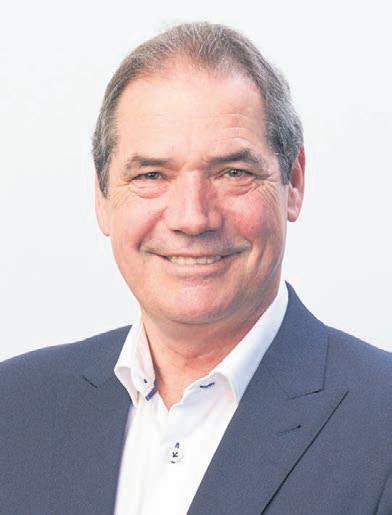
Farmer’s Voice speaks of crisis of confidence
Staff reporter PEOPLE Agriculture
THE first snapshot from AgriHQ’s The Farmer’s Voice has revealed a rural sector that loves its profession but is extremely low on confidence.
The results from 182 farmers across New Zealand are based on a short online survey. They show a sector struggling with low profitability, regulations and mental and physical health.
The farmers surveyed are a mix of gender, age, farm type and location. Asked to describe their overall feeling about being a farmer, 22% said they love it, 43% said it is mostly good and 17% said it is okay.
Only a small percentage had a profoundly negative feeling about being a farmer.
Asked if farming is getting better or worse, 45% said it is getting
worse and 16% said it is getting a lot worse. On the opposite end of the spectrum, 3% said it is getting much better and 16% said it is getting marginally better.
Despite loving or liking farming, six out of 10 surveyed believe farming is getting worse.
Those surveyed said profitability and regulations are the biggest issues affecting farming with 70% and 60% of farmers citing these two issues, respectively.
Compliance costs were next at 37%, followed by staffing issues and income and mental health at 20%.
Farmers were also asked how farming affects their health and wellbeing, with roughly one-third saying their confidence in the future of farming is in doubt: 11% said it is a significant problem and 20% said it is a problem.
There was an even spread of 21% of farmers each who said they were experiencing mental health and physical health problems or had a

OUTLOOK: Asked if farming is getting better or worse, 45% of respondents said it is getting worse and 16% said it is getting a lot worse. Only 3% said it is getting much better and 16% said it is getting marginally better.
The Farmer’s Voice was created by AgriHQ to facilitate better farming conversations.
partner who had health problems, and 14% of farmers have family members with health problems. When split between male and female, the results showed that women are more pessimistic about farming than men, with 57% of the men thinking it is getting worse compared to 67% of the women.
It has recruited as many farmers to join in as possible so that any farmer can contribute. It will be developed over time with new features and a series of projects that farmers can contribute to. These will vary from short, simple polls or discussion questions to more involved projects that will require more input.
MORE:
For more see: www.agrihq.co.nz/thefarmersvoice
NZ strong wool takes to world stage

Annette Scott MARKETS
Food and bre
WOOL industry leaders will be in Australia this week to showcase and promote New Zealand strong wool on the world stage.
The delegation is attending the International Wool Textile Organisation conference in Adelaide from April 15-18.
After years of strong wool being an afterthought in the international forum, NZ strong wool entity Wool Impact has pushed for a dedicated strong wool session.
Wool Impact chief executive Andy Caughey is one of a series of speakers who will highlight how demand for NZ strong wool is being bolstered through brand innovations that meet market requirements for healthy interior solutions.
He will also address how value for NZ strong wool is being built by value chains that close the gap between brand and grower.
Caughey said the conference is a key time for the international wool community to consider opportunities for wool with international speakers covering everything from global consumer trends, wool market intelligence, health and wellness and the environment to innovation, retail trends and education for future generations.
He said fine wool has traditionally dominated previous congresses because of its high profile, high value and link to fashion brands.
Joining Caughey on the world stage is guest speaker Bremworth chief executive Greg Smith with several other NZ brands, including Autex, Wise Wool and NZ Merino, also in support.
Smith will share the Bremworth story from a legacy manufacturing business to consumer-led international brand.
“These brands support our domestic market and all have very strong export aspirations so this is a great chance for them to be profiled in an international context.”
Caughey said companies discovering wool for the first time don’t know about NZ strong wool.
“We are using this conference platform to broadcast to the world, to showcase what we are doing as we have a lot happening to encourage international companies to choose NZ strong wool.”
Wool Impact believes it will be brands like Bremworth that tip the demand and value for NZ strong wool in favour of wool growers.
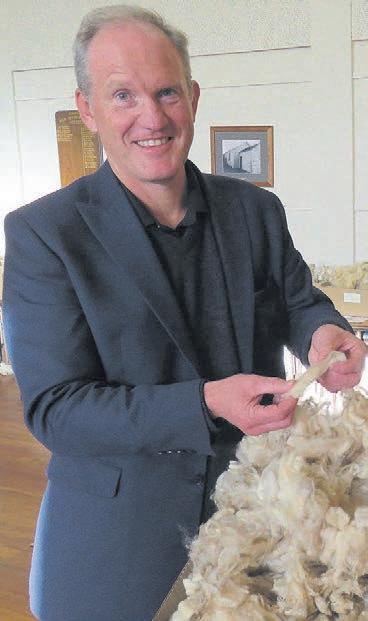
SPEAKER: Wool Impact chief executive Andy Caughey is one of a series of speakers who will highlight how demand for NZ strong wool is being bolstered.
Elite beef cows draw international buyers

AUSTRALIAN buyers from four states were successful bidders for 10 lots of Silverstream Charolais genetics at its special female sale this month at Greenpark, near Christchurch.
The top price of $16,000 paid for Silverstream Suze M5, an eightyear-old cow, came from Myona Charolais in New South Wales and Winkel Park Charolais in Victoria.
The top-priced heifer calf was Silverstream Chander U137, who
sold to Bardoo Charolais and Pasture Seeds, Western Australia, for $10,000.
The top priced two-year-old heifer was Silverstream Angelica T151, who made $14,000 and sold to Charnelle Charolais and Black Duck Charolais in Queensland.
Vendors Brent and Anna Fisher said they were delighted with the full clearance of older and younger females plus six packages of 10 semen straws. There were 50 lots in all.
Cows and heifers bought by Australian breeders will stay in New Zealand for their current
calving, followed by embryo transfers.
The volume purchaser was Rowen Sandford of Topaki Charolais, Hawke’s Bay.
Overseas buyers were also successful at the Atahua Angus female dispersal on the property at Kiwitea, Manawatū – two from Australia and one from Scotland.
In total 122 cows and heifers were sold for an average price of $3815. Top price was $18,000, paid by Kaharau and Turiroa Angus studs on the east coast, for lot 12, Atahua Kawa 630-19, a rising fiveyear-old cow.
She was followed by lot 38 Atahua Quest 725-20, which made $16,000 and lot 8, Atahua Kawa 525-18, for which Banquet Angus in South Australia paid $15,000.
Scottish breeder Wanda Hobbs, Wedderlie Angus, attended the Atahua sale and bought lot 39, Atahua Perdita 729-20 for $13,000 in conjunction with the Crawshaws at Kenhardt Angus, Hawke’s Bay. She also paid $7000 for lot 14, Atahua Kawa 652-19.
Lot 1, Atahua Alice 166-14 sold for $12,000 to Premier Angus in Australia.
3 FARMERS WEEKLY – farmersweekly.co.nz – April 15, 2024 News 3
GOOD THINKING: Alliance CEO Willie Wiese’s idea about greater co-operation in the sheepmeat industry was welcomed by Federated Farmers.
Hugh Stringleman MARKETS Genetics
Freshwater Farm Plan review welcomed
 Neal Wallace NEWS Regulation
Neal Wallace NEWS Regulation
APROPOSED review of what is required in Freshwater Farm Plans is being welcomed by Federated Farmers as a positive and pragmatic step.
“The current system is incredibly frustrating, with a lot of unnecessary cost, complexity and duplication. There are huge opportunities for the government to make improvements,” the federation’s freshwater spokesperson Colin Hurst said.
Associate Environment Minister Andrew Hoggard said the government wants to ensure that the cost of completing a farm plan, in both time and money, is matched by the level of risk. One option is to use propertyand catchment-specific farm plans to identify environmental
risks and plan on-farm actions to manage those risks.
“The current system is too costly and complex, and too broadly applied,” said Hoggard.
Waikato, Southland, the West Coast, Otago, and ManawatūWhanganui have started implementing plans.
The current system is too costly and complex, and too broadly applied.
Andrew Hoggard Associate Environment Minister
Hoggard said the review could include whether current requirements to complete a Freshwater Farm Plan could be paused while improvements are developed.
Agriculture Minister Todd McClay said decisions on what is required in plans will be
Westland Milk posts record
$55.9m profit

WESTLAND Milk Products has announced a record-breaking after-tax profit of $55.9 million for 2023, breaking its previous 2022 record of $38.9m.
The result is more than double its targeted $20m annual return and is a $120m rebound on 2021.
Westland chief executive Richard Wyeth said the performance was a result in executing the company’s strategy put in place in 2021.
That strategy, called Zero to 100, aimed at improving Westland’s profitability by $100m.
He said the company will maintain its push towards longterm profitability by continuing to divert more milk solids into higher value products in 2024.
Westland recently committed

to pay farmers a 10c premium above Fonterra’s milk price for the 2024-2025 and 2025-2026 seasons, extending and improving on payment terms made under the original Scheme of Arrangement when the company was purchased.
“We’re proud of this result but we know we still have plenty of room for improvement,” Wyeth said.
“We’re tracking well to deliver on our five-year commitment to build sustainable growth year on year. A sustainable financial base means we can continue to offer farmers very competitive terms for their milk.”
Wyeth said the purchase of Canary Foods in 2022 had also proven to be a good addition to Westland’s profitability.
“It certainly exceeded our expectations.”
Wyeth said revenue of $1.065
considered alongside the government’s overall approach to freshwater management, including stock exclusion and winter grazing.
Officials are looking at ways to integrate existing farm environment plans or industry assurance programmes into plans.
“This might include giving catchment groups more of a leadership role in developing and implementing improved freshwater outcomes,” said McClay.
Hurst said farmers do not want to see “another expensive ‘box ticking’ exercise” that ties them up in red tape and paperwork for very little environmental gain.
“At face value this is a really positive step forward for both farmers and the environment, but the devil is always going to be in the detail.”
He welcomed the introduction of a risk-based approach, where

the level of information required is determined by specific catchment and farming activity.
“It’s also really encouraging that they’re looking at how existing sector or council farm plans could be recognised or integrated, because over 10,000 farmers already have a plan in place.”
Hurst said this announcement
will leave many farmers in a state of limbo wondering if they should get a Freshwater Farm Plan under the current rules or wait for changes.
“The government needs to address this uncertainty by extending timelines in regions that already have Freshwater Farm Plan requirements in place.”
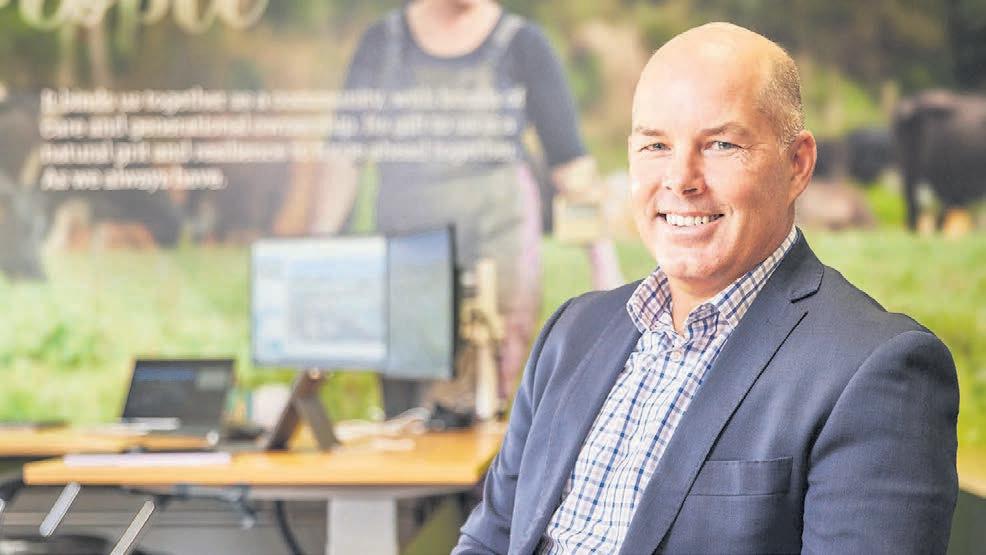
billion was slightly above last year’s result and very pleasing given the fall in global dairy prices.
“The advantage we have of course is the backing of one of the world’s largest dairy companies in Yili.
“Yili’s support has enabled us to invest heavily in infrastructure that will maximise revenue from high-margin products. But our ability to remain competitive on milk prices must rely on our ability to stand alone on financial performance.”
Westland’s diversification across multiple markets across the globe has also helped, he said.
“It’s a strength for us and we need to maintain that going forward because markets do come and go.”
A $70m investment in a new lactoferrin plant at the company’s Hokitika plant supported by Yili is expected to continue to reduce reliance on traditional highmargin revenue sources such as infant formula for China, as import demand in that sector continues to soften.
The plant is due for completion in the final quarter of 2024, and first production will take place in Quarter 3.
Commercial production is
PROUD: Westland
Richard Wyeth says while he is proud of the company’s 2023 result, he knows there is plenty of room for improvement.
expected by the final quarter this year.
Wyeth said a $40m investment in a new butter plant at Hokitika in 2022 had allowed Westland to expand strongly in the United States market.
Westgold butter is now stocked in more than 3000 grocery retail outlets in the US, including Walmart stores. Westland also produces Kirkland Signature New Zealand Grass-Fed Butter for Costco. Costco reported in its 2022/23 financial results that Kirkland butter sales increased more than 160% year on year and continue to show strong growth.


Keeping in shape mentally and physically helps you put the best into the farm, so the farm can give the best back to you.
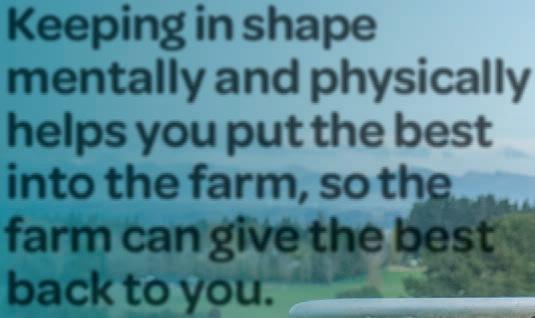




farmstrong.co.nz
To find out what works for you and ‘lock it in’, visit
Sam Whitelock Farmstrong Ambassador
4 FARMERS WEEKLY – farmersweekly.co.nz – April 15, 2024 News 4
PAUSE: Andrew Hoggard said the review could include whether current requirements to complete a Freshwater Farm Plan could be paused while improvements are developed.
Gerald Piddock NEWS Dairy
chief executive
Bring on the dam plans, says Shane Jones
 Neal Wallace NEWS Regulations
Neal Wallace NEWS Regulations
SHANE Jones hopes there will be more applications for water storage schemes seeking inclusion in the government’s fast-track consenting approval process.
Jones, the Minister for Regional Development, was responding to news that Irrigation NZ is promoting fast-track approval for four water storage schemes: Tuki Tuki in Hawke’s Bay, Falls Dam in Central Otago, Wairarapa revamp and Klondyke water storage in Mid Canterbury.
The final list of economic development projects to be included in the government’s fasttrack consenting scheme will be announced later this year. Jones said water storage is critical in dealing with volatile weather patterns and climate change.
“Water storage attracts a lot of criticism but I am not interested in climate cultists, I am only
interested in adaption and future proofing the primary sector,” he said in an interview.
The Fast-track Approvals Bill is designed to cut the red and green tape and make it easier and faster to build significant projects.
The members of the independent Fast-track Advisory Group are David Tapsell, Vaughan Wilkinson, David Hunt, Mark Davey and Murray Parrish.
I am not interested in climate cultists, I am only interested in adaption and future proofing the primary sector.
These will be referred to an Expert Panel, which will apply relevant consent and permit conditions before referring each project and its conditions back to the ministers.
Jones said unlike the Provincial Growth Fund, which was NZ First policy in the 2017-20 government, the party’s Regional Infrastructure Fund, which is current coalition government policy, will not have funding to underwrite these schemes.
“Our focus is simply on ensuring there is a way to expedite the required consents so it is not left to the bureaucratic process that is the Resource Management Act.”
Jones was scathing about how opponents of projects such as water storage have been able to stop or hinder developments.
They will assess the projects and recommend inclusion in the fast-track process to the ministers of infrastructure, regional development and transport, who will make the final decision.
“I think we should have a NZwide network of water storage.
“Where do we think we will get the extra export revenue we need from? It will come from productivity from the primary sector.”
FLOW: Minister for Regional Development
Shane Jones says more water storage is key to raising productivity and export earnings.

The backgrounds of members of the advisory group are: Tapsell is a commercial lawyer and company director, Mercer is a civil engineer with experience in delivering infrastructure projects, Wilkinson has held senior management positions
in the fishing industry and has experience in transport and logistics, Hunt is the former chief executive of Contact Energy and has several governance roles, Parrish was a senior manager at Oji Fibre Solutions and Davey is an experienced urban planner.
High hopes for cannabis company survival

THE founder of a pharmaceutical cannabis company is confident the operation continues to have a bright future despite being in administration.
Tauranga businessman Greg Misson was the founder of Eqalis, a medicinal cannabis company that merged with another medicinal cannabis company, Cannasouth, last June. But in late March Cannasouth was placed into voluntary administration. The companies merged to combine Cannasouth’s established dried cannabis technology with
Eqalis’s skills in extraction technology that enabled largescale, cost-efficient extraction of cannabinoid components THC and CBD.
However, the operation had burnt through the last of its cash reserves by March, prompting it to turn to voluntary administration late last month.
Administrators Blacklock Rose were appointed as joint administrators of the company.
“The company is down but definitely not out,” said Misson, who was also the founding managing director of Open Country Cheese.
A key focus of Eqalis had been to lower the extraction and manu-
facturing cost of cannabinoidbased medicines, a major barrier to patient uptake, along with a need for a wider evidence base to prescribing doctors.
The company’s tech includes a DNA test to identify a patient’s risk profile for developing psychosis in response to THC compounds used to treat glaucoma and muscle spasticity.
“I am confident that at this juncture the administrators are
The company is down but definitely not out.
doing a very good job of creating a more agile and leaner operation,” Misson said.
“We remain very excited for the products that have already been developed, and to be able to get them to people who need them affordably.”
There was concern among shareholders about the rate of cash burn Cannasouth was experiencing, with the call to administrators coinciding with the end of about $2.9 million in shareholder funds. Meantime, revenue earnings projections have been pushed out further to 2025.
In June last year when Eqalis and Cannasouth merged, Cannasouth CEO Mark Lucas acknowledged the
regulatory barriers in the sector are difficult and can be hard to clear.
“Getting compliance, building the team and getting to the start line has been a bit of a pain point, but we are there now,” he said.
The company has recently completed its first harvest of outdoor-grown medicinal cannabis in Canterbury and continues to run its indoor nursery site in Katikati, Bay of Plenty.
A statement to the NZX said the administrators would be undertaking a detailed review of the Cannasouth operations, focusing on identifying the profitable lines of products and services.





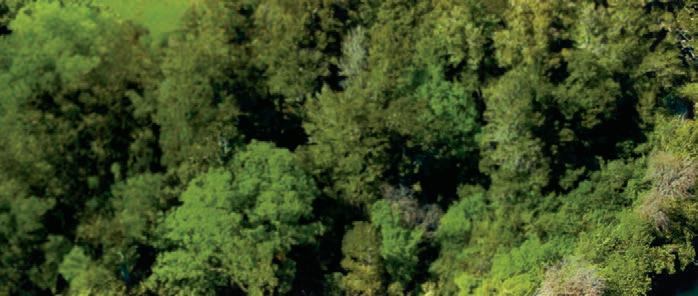





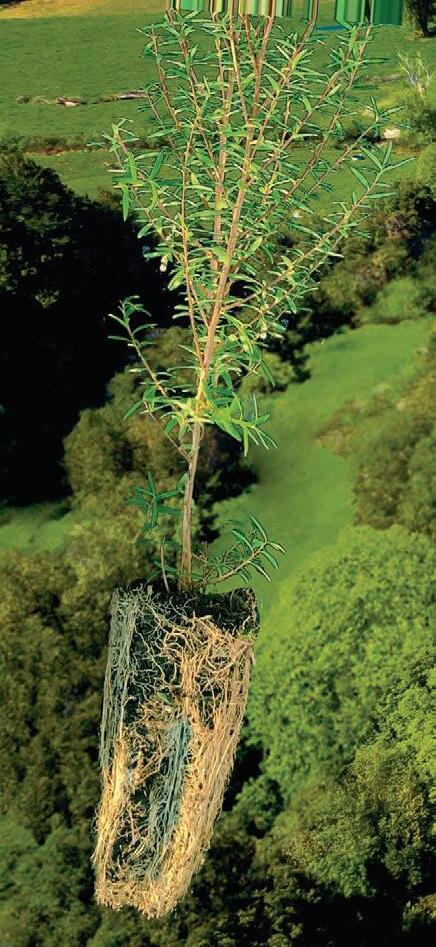
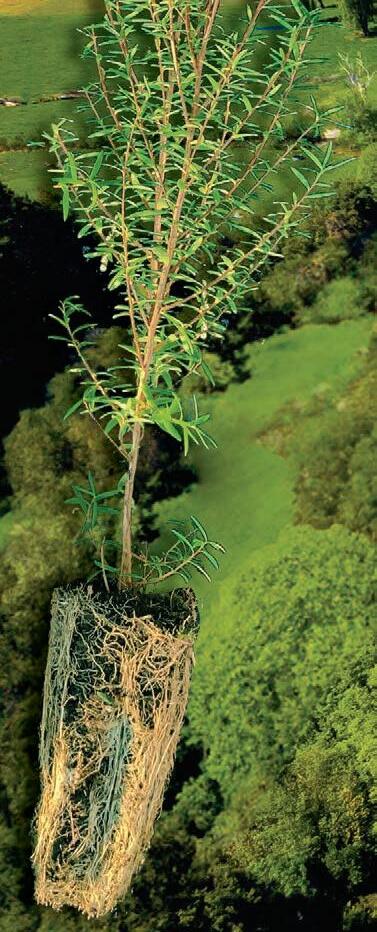






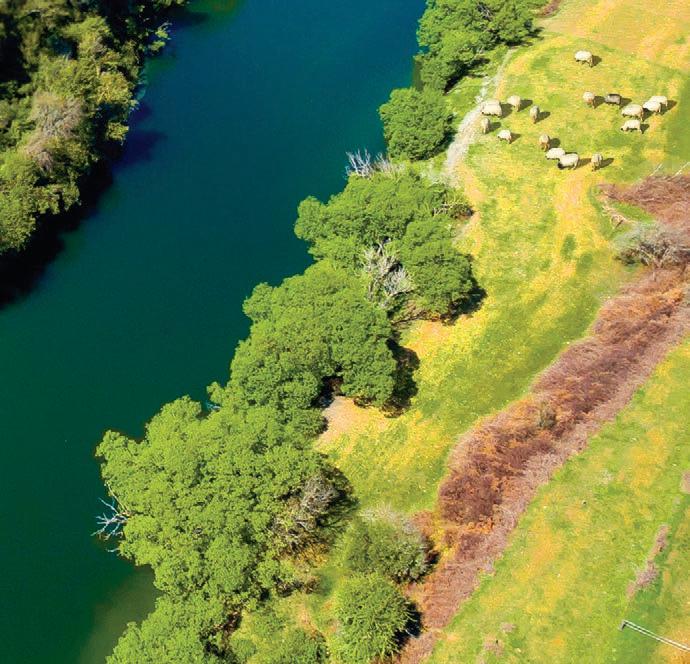

Spend $3000 on Nufarm products before 31st May* at PGG Wrightson and get 75 ma¯nuka seedlings. DOING ‘WRIGHT’ FOR WATERWAYS ONF208751NF *All approved purchases made between 1st March - 31st May 2024 will receive delivery of seedlings between 1st August - 30th September via PGG Wrightson. Seedlings available while stocks last. $3000 spend is GST Exclusive. 5 FARMERS WEEKLY – farmersweekly.co.nz – April 15, 2024 News 5
Richard Rennie NEWS Horticulture
Greg Misson Eqalis founder
Shane Jones Minister for Regional Development
CCC’s carbon budget wary on methane tech
 Richard Rennie TECHNOLOGY Emissions
Richard Rennie TECHNOLOGY Emissions
AGRICULTURAL methane emissions remain the sticking point for New Zealand to meet its Paris Accord targets, and it is unlikely technology will be arriving in time to help farmers pull those emissions down significantly.
The Climate Change Commission’s (CCC) draft advice to the government on how NZ meets its obligations for the fourth reporting period of 2036 to 2040 estimates NZ’s emissions will be a full 63% lower than in 2021.
This has been boosted by higherthan-expected forestry plantings in recent years, a fall in emissions from transport, and greater use of renewables for heating and processing.
Between 2021 and 2022 NZ’s emissions fell by almost 4%. The commission estimates by 2050 NZ’s emissions will have fallen by a full 37%. Agricultural methane emissions will also fall by 13%, but this is well below the minimum target range of 24-47% set in legislation.
However, this range could itself be up for revision. Separate to the commission’s work, the government has announced an independent review of methane emissions targets in the context of “no further warming” effects.
Meantime, the CCC’s advice to get methane emissions within the existing target does not place significant faith in the multimillion-dollar investments made into new methane inhibitor and vaccination technology.
While it has assumed urease inhibitors in fertiliser, effluent treatment systems and genetics will help, it cites an uncertain
future around methane mitigation tech.
It notes some inhibitors are used overseas, but that they are not suitable for NZ’s free range pastoral herds and flocks.
Overall, the commission estimates the tech is only capable of reducing agricultural emissions by 3% or 4 million tonnes of CO2 equivalent over the 2036-2040 period.
The scepticism will disappoint the red meat sector, limited in options for methane mitigation, and has the CCC falling back on more familiar approaches for the sector to enable it to make the target.
Overall, the commission estimates the tech is only capable of reducing agricultural emissions by 3% or 4 million tonnes of CO2 equivalent over the 20362040 period.
Under the EB4 (Emissions Budget) pathway modelled and based on recent land use trends, the CCC has budgeted for a 23% decline in dairying’s stocking rate and a 12% decline in sheep and beef stocking rates by 2050, compared to 2021.
That will accompany land use change, with an estimated loss of 2000 hectares of dairy land a year to horticulture, up on the past five-year average of about 1150ha a year.
While it anticipates dairy will hold the line in total output thanks to increased per cow production, meat production is expected to fall by 17% over that period, with farms being converted to native and exotic forestry. That amounts
to a loss of about 500,000ha between 2021 and 2050, to about 6.5 million hectares of drystock area.
For context, between 2012 and 2022 the sheep sector experienced a loss of 3 million breeding ewes, or 1.5% a year.
The intensive forestry plantings of the past three years have seen more land go into trees than the commission anticipated, lowering the amount needed for the 20362040 period.
After peaking at 65,000ha of exotic plantings last year, that rate drops to 30,000ha a year to the end of the decade. It is expected to continue declining through to 2050 to only 10,000ha a year by 2050, supplied by ongoing drystock farm conversions.
However, native plantings are expected to surge, almost doubling to about 25,000ha a year by 2029 and continuing at that level through to 2050, expected to come through increased marginal and erosion prone land plantings, and reversion.
If these shifts in land use and limited tech do come into play, the commission estimates agriculture will hit a 39% reduction in methane levels by 2050. This places it well within the 24-45% target range, and compares to only a 13% reduction using current practices alone.
But how much of the fourth period budget is taken up remains dependent upon the government’s view on methane’s role in warming.
Professor Robert McLachlan of Massey University said the CCC’s work falls into a contested space, given that the government has abandoned sections of the first reduction plan from 2022-2025, has yet to release its 2026-2030 plan and has still to announce its Emissions Trading Scheme plans.
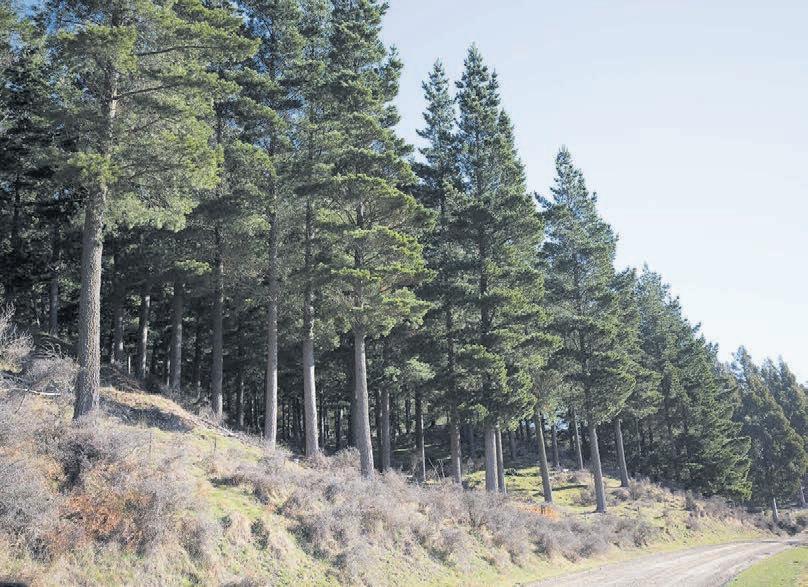
Exporters frown on GHG shipping proposal

Neal Wallace NEWS Emissions
ACCOUNTING for carbon emissions from shipping should be by international agreement rather than imposed regionally or by a country.
This is according to ExportNZ advocacy director Catherine Beard, who said imposing regional or localised emissions charges on shipping risks doubling up.
“That is why a global approach is preferable to regional, localised charges.
“If NZ looks at this policy it will amount to double dipping, double counting and double pay,” she said.
The Climate Change Commission draft advice on emissions budgets and targets from 2036-40 released this week scoped the idea of including air travel and shipping emissions in New Zealand’s inventory.
The European Union includes emissions from ships that use the ports of its member states.
Beard said Lincoln University research into the emissions during
shipping of NZ food exports found that due to the volume of product and the size of ships, our emissions footprint is lower than that of countries we export to.
Zespri executive officer for sustainability Rachel Depree said ships carry 99% of the country’s trade by volume and around 80% by value and shipping emissions remain a challenge to decarbonising the industry.
She said the kiwifruit industry’s total emissions are low at 2kg per kilogram of kiwifruit, of which shipping contributes 43%.
Fonterra’s director of sustainability, Charlotte Rutherford, said the co-operative already includes shipping emissions in its calculations.
“Distribution makes up only 1% of our total emissions, so it does not have a material impact on our overall profile.”
DairyNZ manager of corporate affairs Nick Robinson said the body does not support the inclusion of international shipping and aviation emissions in NZ’s domestic emissions reduction targets.

6 FARMERS WEEKLY – farmersweekly.co.nz – April 15, 2024 News 6 Win a Subscription 5 Shepherdess magazine subscriptions to be won* Never miss an issue. As a Shepherdess subscriber, you’ll get four beautiful, seasonal editions delivered to your letterbox each year. Valued from $59.80 / year Scan the QR code and enter to win! Proudly supported by *Terms & conditions apply
PACE: The intensive forestry plantings of the past three years have seen more land go into trees than the commission anticipated.

Human-driven erosion eating into sector

THE loss of soils through human-driven erosion on top of naturally high erosion rates has significant consequences for the productivity and resilience of the food and fibre sector.
There is also growing recognition that existing structural flood protections are inadequately prepared for increased pressures.
These are the key messages in Our Land 2024, a three-yearly update released by the Ministry for the Environment and Stats NZ that reports “our communities and economies are at risk if we do not protect our natural ecosystems and landscapes”.
Our Land 2024 brings together updated Stats NZ indicator data as well as insights from research literature, showing how the ways we use land have wide-ranging effects on diverse ecosystems and biodiversity with impacts on our economies, homes, resilience to disasters, cultural identity and public health.
MfE’s deputy secretary for strategy, stewardship and performance, Natasha Lewis, said ecosystems such as soil, indigenous forests, wetlands, flood plains and dunes are the foundational natural assets and infrastructure that underpin our economy, help to protect us against disasters and support public health.
These services include supporting our food sector, reducing soil erosion, draining catchments and protecting coastal areas against storm surges and sea level rise.
“We appreciate the benefits that built infrastructure provides, but many of us don’t think of, or value, natural ecosystems and landscapes in the same way,” Lewis said. “Soil is crucially important because it is the foundation for other natural infrastructure. It also plays a vital role in our economy.”
In the year ended June 2023, New Zealand’s food and fibre sector accounted for $55.3 billion in export revenues, which represented more
than 75% of the nation’s export goods.
Soil is a strategic asset.
“A lot of our GDP is in the top 15cm of the ground we walk on, but degrading or developing over our natural infrastructure increases the food and fibre sector’s susceptibility to soil erosion, pests, diseases and the effects of climate change and extreme weather.”
The Treasury has estimated that damage to the sector from Cyclone Gabrielle and the 2023 Auckland floods may total between $700m and $1.1bn in recovery costs.
A recently updated Stats NZ indicator in the report shows that 5% of our land is classified as highly erodible land and at risk of massmovement erosion.
A lot of our GDP is in the top 15cm of the ground we walk on, but degrading our natural infrastructure increases the food and fibre sector’s susceptibility to the effects of climate change.
Natasha Lewis Ministry for the Environment
Of this highly erodible land, 60% is in the North Island.
“Topsoil is a finite resource, but 182 million tonnes of eroded soil entered our waterways in 2022.”
Lewis said other threats to the primary food sector include loss of fertile land to urban expansion.
Deloitte estimated in 2018 that fruit and vegetable prices could rise by up to 58% across the country by 2043 if fertile land at Pukekohe is developed.
“This is important contextual information for decision makers who decide where development can occur.”
Other examples of natural infrastructure include urban green spaces that soak up stormwater, improve air quality and provide recreational areas that support our wellbeing.
The report highlights that many areas across NZ have significantly higher proportions of highly
erodible land at risk of mass movement.
Manawatū-Whanganui has the largest area, 17%, of highly erodible land in NZ and of all regions Gisborne has the highest proportion, 15%, of its area classified at risk of mass movement erosion.
The report also highlights that soil quality is not always within target ranges on land that supports NZ’s primary industries.
“The availability of highly productive land has decreased and should present trends persist it is highly likely that the availability of highly productive land will continue to decrease.
“Land-based industries will almost certainly experience increased economic risks due to degrading natural infrastructure.
“It is highly likely that the degrading state of our natural infrastructure will reduce the regulating and flood protection services provided to surrounding communities.”
Meanwhile the area of exotic land cover has expanded, mostly with conversion from exotic grassland to exotic forest.
Development on floodplains has exposed communities and built infrastructure to flood and erosion risks and led to the need for engineered flood protection systems.
Urban and agricultural development is also occurring alongside braided rivers, constraining their channel margins.
Extreme rainfall associated with climate change is also likely to place increased pressure on these systems over time.
While measures that restrict the natural movement of river systems such as engineered channels and stopbanks are designed to protect communities, they also alter river systems’ natural capacity to provide flood and erosion benefits.
“Climate change is expected to increase risks to communities in flood-prone areas and there is growing recognition that existing structural flood protections are inadequately prepared for these pressures.”


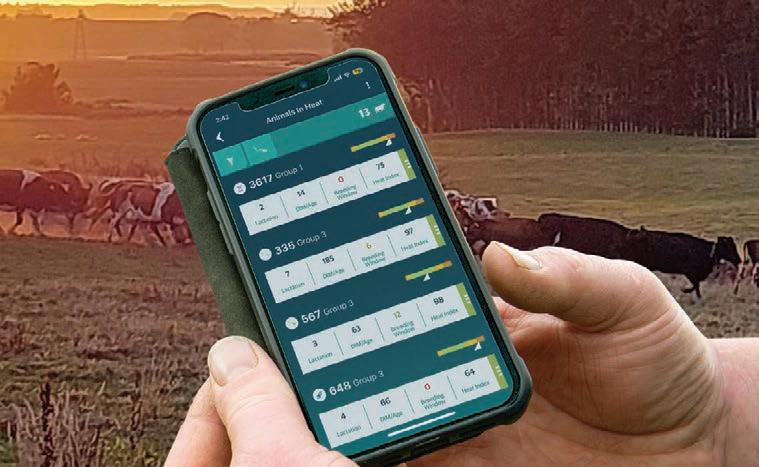




“SenseHub® Dairy collars provide valuable risk protection for our business by removing the reliance on a single individual for cow selection during AI. This really reduces the workload with mating, and frees up time and resources for other things. Our advice to anyone considering starting their SenseHub journey is: don’t hesitate— dive
right
revolutionise
Contact us today about getting collars on your herd www.sensehub.co.nz Copyright © 2024 Merck & Co., Inc., Rahway, NJ, USA and its affiliates. All rights reserved. NZ-NON-240300041. ® Registered trademarks. “Our
– Tracy and Johnny O’Sullivan, Otago, 411 cows This product is not intended to diagnose, treat, cure, or prevent any disease in animals. For the diagnosis, treatment, cure, or prevention of disease in animals, you should consult your veterinarian. The accuracy of the data collected and presented through this product is not intended to match that of medical devices or scientific measurement devices. 7 News 7
in! It truly has the potential to
your life and your farm operations.”
workload has significantly reduced.”
RISK: Climate change is expected to increase risks to communities in ood-prone areas and there is growing recognition that structural ood protections are inadequate.
Annette Scott NEWS Land
Green fuel option lies in trees
 Richard Rennie NEWS Forestry
Richard Rennie NEWS Forestry
BY MID-2026 forestsourced wood pellets are due to start flowing from a new project in Bay of Plenty that brings the promise of a clean energy source and valueadded timber opportunity.
Australian listed company Foresta has gone public about its move to build a torrefied black wood pellet plant at Kawerau, alongside a plant to extract high value chemicals from pine timber.
Managing director Ray Mountfort said the plant will initially produce 65,000 tonnes of pellets a year, supplying South Island energy resource company Tailored Energy & Resources. The company supplies industrial customers with boiler and heating fuels and includes the likes of Synlait as clients.
Black or torrefied wood pellets are wooden pellets heated to 200-300degC without oxygen and have proven to be a successful “drop in” fuel to replace coal, with recent success proven in a trial at Genesis Energy’s Huntly power plant.
“While Fonterra and Genesis are large users of coal, they are still only a quarter of the market,
so there is plenty of opportunity beyond them out there,” Mountfort said.
The plant’s construction and commissioning – which are subject to resource consent being granted – represent a rocky 14-year arc through the innovative technology’s development for Mountfort.
Back in 2011 he established the technology to take forest waste including tree stumps and turn it into turpentines, rosins (resin chemicals) and ink compounds. But a boardroom shakedown after United States company American Pine and Rosin Derivatives bought into the company had him exited from the company.
The company later went into liquidation, and Mountfort continued his work on timber chemicals in Queensland.
He then bought into listed forest processing company Foresta and moved the operation to New Zealand.
Foresta has signed a 30-year lease agreement on a 9.6 hectare site at Kawerau with local Putauaki Trust, with the pellet plant to be bought in from Europe while the chemical extraction plant is also being constructed.
He acknowledges the path to his latest venture has been a tough one.
“There have been some lessons
along the way, and we have picked good partners and have a good board.”
Foresta chair Henry Cheng was previously chair of Australian resource company Formosa Resources.
Mountfort said the Kawerau site is only Stage 1 of a wider production plan that has nine regions flagged nationally with potential timber resources and pellet customers.
Annual initial production of 65,000t of pellets would require about 200,000t of logs or about 330ha of forestry supply a year.
Mountfort said the company does not intend to source material from forestry waste or slash sources.
“It is something we would rather stay away from, it’s really someone else’s mess.”
He said instead farmers could be a valuable market source for timber, particularly “old man pine” that is dense in resin chemicals.
For wood lot owners, he maintains Foresta can extract 10-20% more timber off a block, given their use of the resin-dense stumps and tops for the chemical production.
“From the site in Kawerau we have identified 2000 pine forest owners within 100km.”
While initially not competing with NZ’s raw log trade, Mountfort

said as processing volumes ramp up that becomes inevitable.
“For that reason, we have priced our supply cost on the average of all grades of log values for the past five years. New Zealand exports about 22 million tonnes at an average value of $111/tonne.”
He said most pellet operators have to put raw material price near $50/tonne, but the ability to draw off and process high value chemicals and resins means Foresta can tolerate a higher cost threshold while also helping
Nurturing the next generation of Directors is key to Farmlands’ success
Astrong, farmer-owned co-op is the best way for farmers and growers to be sure they can access the rural supplies they need, at prices focused on supporting on-farm profitability.
Farmlands‘ Board is largely made up of elected Directors who understand what it means to own an agriculture business in Aotearoa. Maintaining a strong pipeline of Shareholder Directors with sector experience is critical to Farmlands’ future, says Rob Hewett, Farmlands’ Chair since 2019. “We need a talent pool of well-qualified people with ability to govern in the best interests of the company,” he said.
Years ago Rob, recognised in 2023 as New Zealand Deloitte Top 200 Chairperson of the Year, made a deliberate decision to put as much business through co-operatives as he could, because he saw how important their continuing existence was to the rural sector‘s influence, relevance and on-farm profitability. “As a supplies co-op, owned and governed by its members, Farmlands has one collective goal – to deliver the best possible pricing to New Zealand farmers and growers, full stop, to
support on-farm and orchard productivity and profitability.”
Rob notes that the fiduciary duties of governing a company of the size and complexity of Farmlands are large – and increasing.
“Farmlands has a vested interest in and is very committed to playing its part in growing rural sector governance capabilities among our shareholders.”
The co-op supports programmes like ‘To The Core’ and runs its own Board Observer programme. The co-op’s most recently-elected Board member, South Otago dairy and beef farmer Will Clarke, (a To The Core graduate and prior Farmlands Board Observer) is proof of the effectiveness of Farmlands’ approach.
“It’s pleasing to see our programmes make a difference. They help to add a bit of certainty to the process, by exposing participants to the issues the co-op is facing so that they’re better equipped to get off to a good start when they join the Board,” says Rob.
He says that these programmes are just one way to gain some governance skills and experience.
“Our Director election process is all about
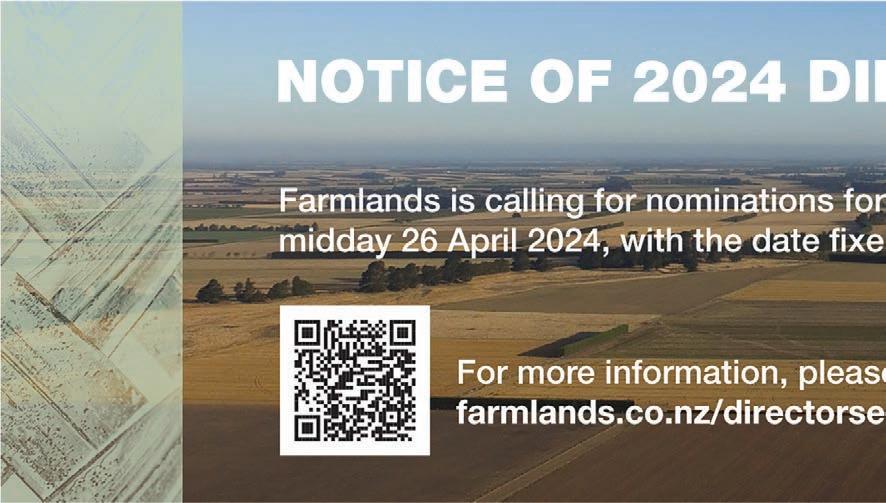
unearthing a range of expertise and experience from across our shareholder base. We want to hear from capable candidates who know what farmers and growers need today, and who understand emerging opportunities and technology.”
There’s never been a more interesting time to be on the Farmlands’ Board as the co-op focuses on its core mission: to be the first-choice input supplier for New Zealand farmers and growers. Farmlands is undergoing a large-scale programme of change that’s dedicated to the delivery of more value and support to customers, with ongoing work to improve the co-op’s supply chain, and to develop a suite of digital tools to help customers get what they need from the co-op.
absorb a low value, volatile export product by turning it into higher value outputs.
Brian Cox, chair of Bioenergy Association of NZ, welcomed the arrival of a company capable of “closing the loop” and processing lower grade pine into a higher value product.
“This is exactly the type of project we need, and it is great they are putting a stake in the ground, and it is likely to generate considerably more interest in this particular sector.”


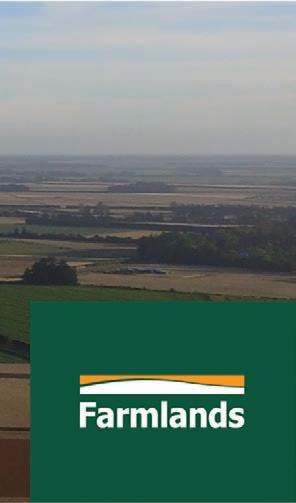
To learn more about becoming a Farmlands Shareholder Director, visit: farmlands.co.nz/ directorselections2024.html.
can request a nomination pack by calling the election helpline on 0800 666 047 or emailing iro@electionz.com. Nominations close at midday on Friday 26 April 2024. ADVERTISEMENT LK0118318©
Rob Hewett, Farmlands’ Chair.
You
8 FARMERS WEEKLY – farmersweekly.co.nz – April 15, 2024 News 8
COMMITTED: Foresta managing director Ray Mountfort says his company has agged multiple sites that could take a wood pellet-forest chemical extraction plant.
Dam gives kiss of life to the drought zone
 Richard Rennie
Water
Richard Rennie
Water
GROWERS, farmers and residents of the Tasman-Nelson region are grateful for the just-in-time flow of water from the nearly commissioned Waimea Dam project.
Over 20 years after the dam was first conceived, the first flow to augment the drought-depleted Waimea and Lee rivers arrived in early March, only days before the region was classified as being in a drought.
The irony of the declaration and the dam’s timing is not lost on Waimea Irrigators chair and founder, dairy farmer Murray King. King has weathered many storms of controversy to see the project finally delivering its life-giving force.
We will not be milking cows for much longer, it is likely much of the farm will end up being put into pip fruit.
Murray King Waimea Irrigators
Only two years ago he vented his frustration and anger to Farmers Weekly about a project whose initial costings had ballooned from $75 million to over $200m and was well behind on its final construction.
Delays and costs had tainted the early vision held by him and other enthusiastic volunteers, while also leaving the region’s council with an uncomfortable bill.
However, today the prospect of moderating a severe drought situation with benefits that extend well beyond growing grass and crops has King more sanguine about the tumultuous and expensive project today.
“Yes, no doubt, not an inkling of
doubt, it has been worth it.
“The drought we are in now is as bad as the one in 2001, which was what prompted this project.
We have not come close to average rainfall for the past six months, and for the calendar year we are sitting on only 30% of our normal rainfall.”
He said real time aquifer and river flow data speaks volumes about the early impact the dam’s flow is having on the region, compared to what a typical drought year would otherwise bring.
“The Waimea flow rate sits on 1.4cum/second above the minimum flow of .8cum/s. Our aquifer is also in really good shape.”
Tasman District Council data shows that while typically low for summer, the Waimea ground water aquifer is holding up well against 50 years of data in a region where soil moisture has fallen off a cliff to be under 20%.
King said the benefits of the dam’s early controlled flow have played well for apple growers who needed some late irrigation to finish fruit prior to harvesting.
“But it has also meant residents in Richmond are not on water restrictions.”
By late February droughtstricken Richmond residents had moved to Phase E, when water can only be used for drinking, sanitation and stock watering. The augmented release of dam water meant by April 3 no restrictions were in place.
Meantime local industry is also benefiting in a region where water limitations can severely impede processing.
“Industries like Nelson Pine and Alliance would normally be facing limitations, and that means fewer shifts and less work.”
Nelson Pine, which employs 275 staff, experienced significant reductions during the 2018-19 drought.
Top of the South Rural Support Trust chair Richard Kempthorne

said the augmented flow had significantly eased stress levels for vegetable growers on the Waimea Plains.
King said there are already moves afoot to hasten the development of more high value horticultural land in the region as a result of water surety. That includes on his own farm, where milking cows no longer offers the best return.
“We will not be milking cows for much longer, it is likely much of the farm will end up being put into pip fruit,” he said.
Interest from other rural communities also battling with drought risks has grown, along with ministerial interest.
King said there have been some valuable lessons offered by Waimea, but he also ruefully noted “no one ever learns them” when it comes to irrigation project development.
“There are those elements of

time, experience, capability and fear of failure that all come into effect with irrigation projects.
“If you were guaranteed you would not lose all your dollars in the feasibility stage, you would put more dollars up front. In our case, like many others we did not spend
enough early on. We should have had more expertise earlier on.”
But he said Waimea Water is now in good heart, with a solid board and a good depth of professionals around it.
Official dam commissioning is expected in coming weeks.
Parasite warning to dog owners
Biosecurity New Zealand’s chief veterinary officer, Dr Mary van Andel.
DOG owners are being urged to ensure their pets are up to date with their flea and tick treatment, after the parasite Babesia gibsoni was detected in a dog in the Canterbury region.
Biosecurity New Zealand said Babesia gibsoni is widespread around the rest of the world, including Australia, but this is the first case discovered in a New Zealand-bred dog.
It can cause the disease babesiosis, which is not present in New Zealand. Most dogs will experience only mild symptoms, if any, but the disease can be severe in some cases.
“The parasite is often transmitted by ticks, so we are encouraging dog owners to make sure their dogs are up to date with their flea and tick treatment,” said
“Along with ticks, the parasite can also be spread through dog bites, blood transfusion and through the placenta from an infected mother to her pups. In countries where Babesia gibsoni is widespread, the focus is on preventing infection by treating dogs with tick treatments or combined with flea treatments, and limiting fighting behaviour.”
Van Andel said dog owners shouldn’t be alarmed. At this stage there was just one case in the country and they are working to determine whether this is an isolated case and where it came from.
Overseas, the parasite is often found in a select group of dog breeds – pit bull terriers, Staffordshire bull terriers and greyhounds are the most commonly affected breeds.
KEEP OUR SHEEP SWEET DURING DUCK HUNTING
Dose all dogs with Praziquantel at least 48 hours before arriving at the Maimai to prevent sheep measles.




Dogs without symptoms or that have recovered from infection often reach a balance where their immune system suppresses the parasite. However, this means they may still spread the parasite and may develop disease if they become immune compromised. Biosecurity NZ is working closely with the owners of the infected dog to identify other dogs she has been in contact with so they can be tested.
The affected dog was euthanised at its owners’ request due to it being extremely unwell.
Van Andel said vets are asked to contact Biosecurity NZ if they come across suspected cases of Babesia gibsoni. If dog owners are concerned about their pets’ health, their first port of call should be their veterinarian.
Further information about Babesia gibsoni can be found on the Ministry for Primary Industries website.


0800 222 011 www.sheepmeasles.co.nz @sheepmeasles @sheepmeaslesnz
Find out more SheepMeasles 9 FARMERS WEEKLY – farmersweekly.co.nz – April 15, 2024 News 9
COWS TO APPLES: Murray King said the natural evolution of having greater water surety from the Waimea dam project was land use change to higher earning crops.
NEWS
Staff
reporter NEWS Parasite
NZ Post cuts back its rural parcel service
NZ POST will no longer deliver newspapers and parcels to rural addresses on Saturdays. It says those deliveries are no longer commercially viable. Monday to Friday deliveries will continue as usual.
NZ Post chief operating officer Brendon Main said that right now, Saturday services to rural areas are limited to subscription newspapers and some parcels.
“We deliver very low volumes of items on these days and it costs us more to deliver on Saturdays than we earn from the products we deliver.
“From June 29, NZ Post will no longer deliver newspapers and parcels on Saturdays in the majority of rural New Zealand, with the exception of 17 rural delivery runs that will be phased out by June 2025.
“These 17 delivery runs are in Canterbury and Waikato and are being kept in place to give our business customers more time to put alternative arrangements in place for their customers.
“It is important to note that there will be no changes to rural mail delivery as we do not currently deliver mail on Saturdays to any address. Rural mail delivery will still take place Monday to Friday, and we will still be fulfilling our obligations under the Deed of Understanding, which is an agreement we have with government that includes how often we deliver mail.
“We acknowledge the effect that ceasing Saturday deliveries may have on Kiwis who live at a rural address. This is not a decision that we have made lightly and we empathise with those who could be impacted by this change,” Main said.
Impacted rural customers can expect to receive a written notification about the change

from NZ Post. Rural customers who currently have newspapers delivered on Saturdays are advised to contact their newspaper subscription service.
This change will also affect rural customers who are PO Box holders and currently receive deliveries through the NZ Post Box Lobby service on Saturdays. PO Box holders who are impacted by this change will receive a letter from NZ Post.
NZ Post has consulted with rural delivery partners and said it considered the impact to business customers before confirming this change.
LETTERS: Deliveries of mail from Monday to Friday will not be a ected by the change, NZ Post says.
PGG Wrightson honours industry stalwart
 Annette Scott PEOPLE Food and bre
Annette Scott PEOPLE Food and bre
PGG Wrightson general manager wool and industry stalwart Grant Edwards, who died recently, spent 40 years in the wool and livestock industry.
“We need to make some hard decisions about our future and the services we offer as we evolve to meet the needs of New Zealanders.
“We are continuing to invest in growing an unmatched delivery business, while managing a transition to a commercially sustainable mail delivery service as we move toward a single network for mail and courier delivery as announced on March 26 2024.
“These are not always easy decisions to make, and we again acknowledge the impact on rural communities,” Main said.
Farmer cops huge fine for cheating staff
A HIGH-profile Southland dairy farming business and its owner, Invercargill imam Reza AbdulJabbar, have been ordered to pay $215,000 by the Employment Relations Authority for exploiting three Indonesian migrant workers. Of this amount, Rural Practice Ltd was ordered to pay $145,000, and Abdul-Jabbar must pay $70,000.
Two of the three workers will each receive $10,000 of the penalties amount.
The business and Abdul-Jabbar were found to have breached numerous minimum employment standards by not paying workers the minimum wage or holiday and leave pay, unlawfully deducting money from their wages, forcing the workers to pay premiums and not keeping accurate wage or time records.
In an earlier decision in February, the Employment Relations Authority (ERA) ordered Rural Practice and Abdul-Jabbar to pay the workers $52,056 in arrears in holiday pay, plus interest. They also voluntarily paid $64,387 to the workers for holiday pay and unlawful deductions during the hearing process.
Abdul-Jabbar, who is a shareholder in companies owning property in Queenstown and Southland, is imam of the Invercargill mosque. He was also the religious adviser and mentor of at least one of the workers.
Silvia Abdul-Jabber, who was a co-owner of Rural Practice Ltd, died in September 2022 while the case was being heard and the Labour Inspectorate withdrew its claim for penalties against her. The three workers came from Indonesia to work for Rural Practice Ltd on its Invercargill dairy farm between December 2017 and February 2022.
In December 2020 one of the workers contacted the Ministry of Business, Innovation and Employment to complain he had not been paid the salary recorded
in his employment agreement or given the number of days off he was owed each fortnight.
He also complained that his employer had taken possession of his passport and ID and kept them even though he asked for them back.
A Labour Inspectorate investigation found that each employee had been given two versions of their individual employment agreements – one stating a higher salary, which the employer provided to Immigration New Zealand (INZ) during work
visa applications, and the other, provided to the Labour Inspector, stating a lower amount. None of the employees were paid the wages due to them.
It was also found that amounts had been deducted from one of the workers’ wages, purportedly to pay for the services of a recruitment company in Indonesia.
During the Labour Inspector’s investigation, it was found that payslips for the workers had been manipulated.
In a tribute honouring Edwards, PGG Wrightson said he was a friend to many within PGW and a very resolute member of the PGW family.
“His departure is a loss for those who had the pleasure of working with him in the wool and livestock industries over the past 40 years.”
Having graduated from Lincoln University with a Bachelor of Agricultural Science, majoring in wool science, Edwards started his career as a junior stock agent at Reid Farmers in his home province Otago, at Ranfurly in 1983.
After several years he joined the wool business where he became wool manager, based in Dunedin.
Following the merger with Pyne Gould Guinness Ltd, Edwards became general manager wool, a post he held until the merger with Wrightson Ltd in 2005, when he was appointed general manager regions for PGW. He held that post until 2016.
Since 2017 he had been leading PGW’s wool business as general manager wool.
EXPLOITATION:
Dairy farm business owner
Reza AbdulJabbar – who is imam of the Invercargill mosque – and his company have been ordered to pay $215,000 for exploiting three Indonesian migrant workers.

In one case there were two sets of payslips for the same period – one set with the hourly rate of pay inflated to satisfy INZ visa requirements and the other set with a lower rate of pay and correspondingly more hours worked, provided to the Labour Inspector.
Labour Inspectorate head of compliance and enforcement Simon Humphries said it was unforgiveable that business owners would knowingly and deliberately exploit vulnerable workers they had brought to NZ.
Authority member Alastair Dumbleton said the manipulation of the workers’ payslips was an indication that Rural Practice Ltd through its directors had actively contrived to mislead statutory officials of INZ and the Labour Inspector.
He said the breaches happened because of “an attitude held by Mr Abdul-Jabbar of disrespect for employment and immigration statutory rules and regulations – ‘officialdom and bureaucracy’ –and also an attitude of indifference to the sanctity of contract.”
Edwards’ strength was navigating politics to ensure outcomes were good for the business and good for the wool industry,” PGW said.
Highly regarded by his peers, he was a member and often the chair of various industry bodies.
“He could slice through what was meaningful to wool growers and had an exceptional understanding of how the wool business operated through difficult times.
“The PGW Wool team feel positive about the foundation that Edwards has left for the business to build on and the team is keen to continue his legacy.
“What made Edwards special was his attention to detail and keen duty of care for his staff. He always cared for his team, was firm in his conviction and believed in sticking to our knitting.”
As a stalwart of wool, his passion for the wool industry was unwavering and his leadership and influence will leave a lasting impact,” PGW said.
His catchphrase was “Once you have a passion for wool, it never leaves.”
10 FARMERS WEEKLY – farmersweekly.co.nz – April 15, 2024 News 10
Staff reporter NEWS Communication Staff reporter NEWS Employment
Back down to zero for M Bovis infections

NEW Zealand’s only known farm with Mycoplasma bovisinfected cattle has been cleared to resume normal farming activities.
The Selwyn dairy farm takes the number of active confirmed properties back down to zero, and the total number of cleared active confirmed properties since 2017 to 282.
The M bovis programme first reached zero active properties in August 2023.
Given the source of infection for this property has not been established, finding more cases in the coming season is expected, OSPRI general manager disease control planning and integration Simon Andrew said.
Six years into the 10-year eradication plan, the eradication effort is moving into a phase that will centre on ongoing surveillance.
Due to the nature of the disease and its ability to remain clinically undetected, Andrew said, several years of data with no new cases of


infection need to be collected to provide confidence that M bovis is no longer present on NZ farms.
Going forward, the national surveillance for beef and drystock and bulk tank milk (BTM) testing remain important tools in detecting suspected infected properties.
“Past programme data tell us we are likely to see more BTM detect results over autumn and spring.”
Andrew urged farmers “to be a mate and update NAIT”.
Be a mate and update NAIT ... with calf sales picking up and moving day not far away, it’s important to record all movements.
“The data captured in NAIT plays an important part in helping the M bovis programme trace infection.
“With calf sales picking up and moving day not far away, it’s important to record all movements.”
Meanwhile, imported semen




has been identified as a way that M bovis may have entered NZ and the M bovis programme partners have implemented a testing project for bovine semen imported into the country before May 2022.
This comes after a farm, in late 2022, confirmed infection with a new strain of M bovis not previously found in NZ.
The Ministry for Primary Industries (MPI) believes semen was the most likely infection pathway as other pathways were ruled out early in the investigation.
Under a Notice of Direction issued by the MPI under the Biosecurity Act, anyone who has bovine semen that was imported into NZ before May 2022 must supply two straws of semen for testing from all eligible batches they hold, including semen on behalf of clients.
There is one exception – no straws need to be supplied if the semen has been treated with antibiotics in compliance with the Certified Semen Services (CSS) as research has shown the CSS protocol is more effective at preventing M bovis than other antibiotic treatments for semen.

Farmers with eligible imported semen in storage will be required by June 2024 to either approve the submission of straws for testing or opt to destroy unused straws. Imports after that date are not included because in May 2022 a new Bovine Germplasm Import Health Standard (IHS) took effect. The new IHS provides improved risk management. The MPI assesses the M bovis introduction risk of imported bovine semen as low due to required antibiotic treatments, and with the strengthened IHS in place, the risk is now even lower.
“However, no risk is not the same as zero risk,” prompting the M bovis eradication programme to apply the same, or similar level of assurance provided by the new IHS to all imported semen in NZ. More than $600 million has been spent and 282 infected properties across the country now cleared. While active confirmed properties are currently at zero, there are 35 properties under active surveillance and two under notice of direction. A total of 2960 claims have been processed totalling $283.1m, with 13 claims in progress.










ABOVE THE REST…
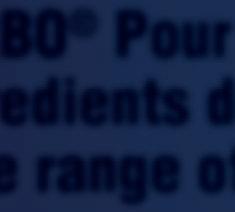






























When you choose TURBO* Pour On, you’re not only getting the ultimate solution for parasite control you’re also receiving a cutting-edge tool to enhance your work productivity. The Metabo SSE 18 LTX BL Compact Cordless Sabre Saw is a valuable tool for farm operations, offering convenience, versatility, efficiency, precision, and safety.





























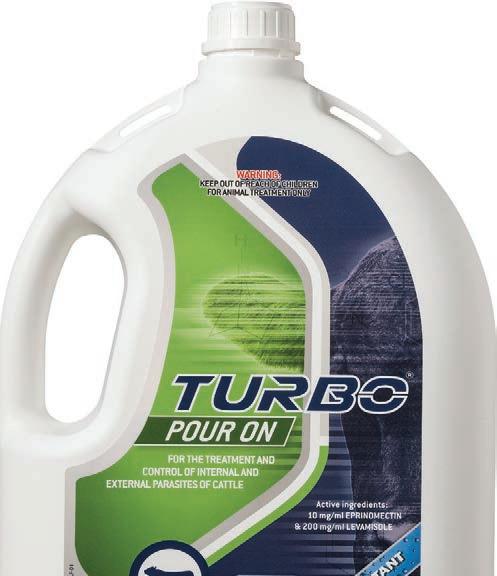














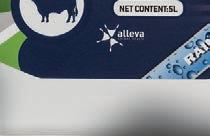
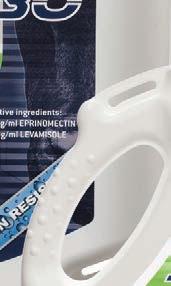







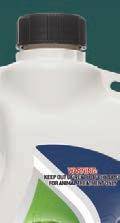



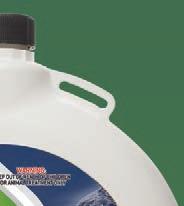






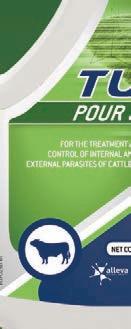















CUT
ALLEVA.CO.NZ | PROUDLY NZ OWNED TURBO® is registered trademark of Alleva Animal Health Ltd. TURBO Pour On (A011722) is registered pursuant to the ACVM Act 1997. See www.foodsafety.govt.nz for registration conditions. *Promotional items received may differ from advertised images and available while stocks last. Offer applies to TURBO Pour On 7.5L promotion packs only. NZ OWNED TURBO® Pour On is formulated with advanced ingredients designed to effectively control a wide
PURCHASE 7.5Ls OF TURBO POUR ON AND RECEIVE A METABO SSE 18 LTX BL COMPACT CORDLESS SABRE SAW*. AAH-TUPO-2024-001 11 FARMERS WEEKLY – farmersweekly.co.nz – April 15, 2024
11
range of parasites.
News
MORE TO COME: The source of infection for the property has not been established, so nding more cases in the coming season is expected, OSPRI general manager disease control planning and integration Simon Andrew says.
Annette Scott NEWS Disease
Simon Andrew OSPRI

From the Editor
 Bryan Gibson Managing editor
Bryan Gibson Managing editor
THE government’s decision to form an independent panel of experts to review New Zealand’s methane targets is an interesting one.
For a start, the Climate Change Commission is a group of independent experts that has been advising the government since being formed in 2019 with multi-party support.
The key phrase in the government’s announcement last weekend is that targets will be reviewed so there is “no additional warming”.
This essentially puts a line in the sand forgiving farming for historical emissions, and approves of that level of warming into the future.
In the global picture of farm emissions, New Zealanders are among the most efficient producers in the world, so that strategy holds some currency.
But the commission, which released its latest advice to the government last week, believes that currency might be running out.
“The majority of mitigations which are theoretically possible to reduce GHGs have been developed for systems which are designed for high levels of supplementary feeding of livestock or systems where animals are farmed in close contact in housed systems. These are either not relevant to, or require significant changes to them to make them suitable for the New Zealand farming system, which is predominantly pasture based in the open,” that advice reads.
That means our competitors have a wind in their sails that we do not – yet.
There’s fantastic research being undertaken on our unique farming systems and it was great to see more of our biggest players sign up to AgriZero last week.
We’re going to need all of the investment we can muster to overcome the challenge.
But, science aside, as many have said over the past week or so the big decision on methane targets is a political and social one, not a scientific one.
Our government is tasked with meeting its global obligations in a way that’s fair to every New Zealander trying to make a living.
If methane targets are reduced, some other Kiwi industry needs to pick up the tab.
The question is – what is the fairest way to decarbonise while still keeping the lights on?
And, with market forces driving change in our farming world already, one might wonder why this piece of work is necessary when processors and customers are setting the bar for our food producers.
Letters of the week
Ever watchful against ‘woke’
Jason Barrier Waikato
IN HIS attempted debunking of the phrase in “Go woke, go broke?” (April 4), Phil Weir argues that our worrying about “wokeness” is a “diversion” because it is not currently impacting on our balance sheets.
He correctly points out that markets, interest rates and fertiliser costs are much more immediate financial concerns for farmers.
However, in his viewing this issue of “woke” (overbearing and poorly designed) regulation solely through the narrow lens of today’s cashflow, Weir perhaps misses the salient point.
The real reason that wokeness is not yet ravaging our balance sheets and cashflows in the present is because farmers have fought tooth and nail against it in the past.
Take for example the initial Waikato Plan Change 1, which proposed a new set of farming rules – with a price tag of $627,000 of up-front capital expenditure for a 323 hectare hill country block, plus a 36% increase in annual farm working costs per effective hectare (independently assessed by Baker Ag).
Clearly this level of environmental compliance was beyond reasonable, and so sheep and beef farmers across the region had to stand up and fight it.
Similarly, the Titanic disaster of He Waka Eke Noa was kicked for touch last year because sheep and beef farmers could see the writing on the wall.
With Beef + Lamb NZ now forecasting an average profit before tax of $62,600 per farm, how many of us would have enjoyed writing a blank cheque for an undefined carbon tax from this year onwards, in perpetuity?
I would also hazard a guess that the woke “ban on live exports” has impacted significantly on a good number of farmer balance sheets over the past 12 months.
Notwithstanding the superficial nature of the term “woke”, I am sure Weir would agree
Fonterra, for example, proposes reducing the emissions intensity of its products by 30% by 2030 and reckons just 7% of that will rely on new technology.
It’s in the business of making money for its shareholders, not of winning elections, so one would imagine the numbers stack up.
Emissions are a human problem and it will take all of us to meet the moment.
Surely it’s time to move on from “not us, them” to “how can we all help?”.

12 Editorial
Best letter WINS a quality hiking knife Send your letter to the Editor at Farmers Weekly P.0. Box 529, Feilding or email us at farmers.weekly@agrihq.co.nz FARMERS WEEKLY – farmersweekly.co.nz – April 15, 2024 Opinion 12
Doing right by the climate and each other farmersweekly.co.nz/premium Get the news delivered daily to your email inbox. TODAY Subscribe to Farmers Weekly Continued next page If methane targets are reduced, some other Kiwi industry needs to pick up the tab.
In my view ...
Team Ag should cut its teeth on rural ROI
Roger Bray Bray
Mid Canterbury beekeeper and food producer
ISEE some are wondering where to with Groundswell, and perhaps a life for the leaders after a few years of toil.
Seems there are moves to promote a new organisation –Team Ag.
Don’t we all need to think seriously about why the likes of Groundswell and other groups started up?
Once groups that formed have met their goals what happens next – should they be disbanded, put into a holding pattern or be repurposed?
Quite a quandary here and especially if the organisation is to remain in a holding pattern – how does it maintain support when it may be doing very little if the threats it responded to are gone?
There have been suggestions of unity and some sort of amalgamation with Federated Farmers – surely that was the problem at the outset? Feds support for and partnership with the He Waka Eke Noa crowd that was proposing to introduce a carbon tax on farming?
The levy organisations likewise jumping into an (unhealthy) partnership with the government to shaft the very people they claimed to represent and be working for?
Why would anyone that aligned themselves to the Groundswell movement contemplate returning or amalgamating with an
Letters of the week
Continued from previous page
upon reflection that sheep and beef farmers do need to remain vigilant and resist costly and poorly thought-out “woke” regulation. Such regulation is already costing us, and will cost us a lot more if we seek to trivialize it as “wasting time” instead of standing up and fighting against it.
Pāmu on the block
Dave Stanton Wellspring farm,
Geraldine
TOP agricultural accountant Pita Alexander is right on the money proposing that Pāmu Farms should be sold.
Not only has the New Zealand taxpayer received a pathetic, miserable return on its $2 billion investment in what could be
organisation that once tried to shaft them?
Have those organisations shown they care for their membership?
For them it’s just bums on seats that pay a hierarchy to dine at the top table while they go through the motions of “representation” without actually hearing the concerns of those they are supposed to represent.
Seems to me Team Ag needs to consider the situation and take a position.
Surely Team Ag should be there to ensure the rural people receive adequate return for the effort and investment they make?
As producers of food our slice of the action fluctuates wildly and mostly for dubious reasons. We are locked into a system where others dictate our production costs and our selling price of goods.
Surely Team Ag should be there to ensure the rural people receive adequate return for the effort and investment they make?
We are all faced with a wellknown supply/demand situation that may have worked in feudal times when peasant farmers provided food for other peasants, but in today’s world things just don’t gel.
If farmers cannot produce goods at a price that is acceptable to the supermarkets then they (the supermarkets) will source product elsewhere, even overseas.
privately run farms, but we taxpayers are currently paying 5-6 % interest on the NZ Government current account foreign debt, costing us $110m per annum that we could pay back.
That is not to mention the discounts and premiums extracted from playing off fertiliser and meat company co-operatives.
We are the only country in the world where private enterprise farmers subsidise the government’s agricultural business.
Sell each farm separately, offering farm staff the opportunity to invest in a farm at fair market value based on three separate appraisals.
We would all be better off because of it.
Bill we can’t afford
Jenny Easton Nelson
THE Fast Track Approvals Bill is an undemocratic and ill thought-out piece of legislation.
The supply chain has become the determining factor on who makes a profit or indeed who survives.
As a community, farmers used to promote “we feed the world”. That changed as we realised selling goods to poorer countries would not sustain our way of life so we started to promote “we feed the affluent people of the world”.
Now it seems the people in our own country are no longer affluent enough to be able to afford to eat much of the produce that is produced locally at a price that keeps the producer in business.
Isn’t this something Team Ag should be involved in to seek solutions?
Our meat industry is showing signs of decline. Consumers are being put off by high prices, leading to sluggish sales. As the stocks of meat reach “use by” dates, a decision has to be made – turn it into fertiliser, pet food or donate it to the food banks to keep consumers used to a carnivorous diet.
The meat companies’ margin is eroded and this further reflects on the prices suppliers receive for their livestock.
A downward cycle is happening; it cannot sustain either the meat companies or the farmers. Seems the people who have a choke hold on the supply chain (supermarkets) are the only ones that can maintain their margin.
As the “system” spirals downward there is a need for investment into mental health, a real growth industry as people struggle with an engineered
We should be deeply concerned that the expert panels “must not give public or limited notification of a consent application or notice of requirement”.
Nor are they required to invite comments from the public or from relevant local groups. Thus, locals will potentially be excluded from the assessment process of development and infrastructure projects that will have significant impacts on their local environment and area.
The Bill may be a breach of our fair-trade agreements with the United Kingdom and European Union that require the government to uphold environmental standards.
This Bill is undemocratic and completely unacceptable.
The voting public of Aotearoa New Zealand care deeply about the unique landscapes, biodiversity and marine environments that make up this nation. They are also extremely concerned about the ramifications of climate change on our current and future way of life.
We need our rural and urban communities to be resilient and have trust that the authorities will
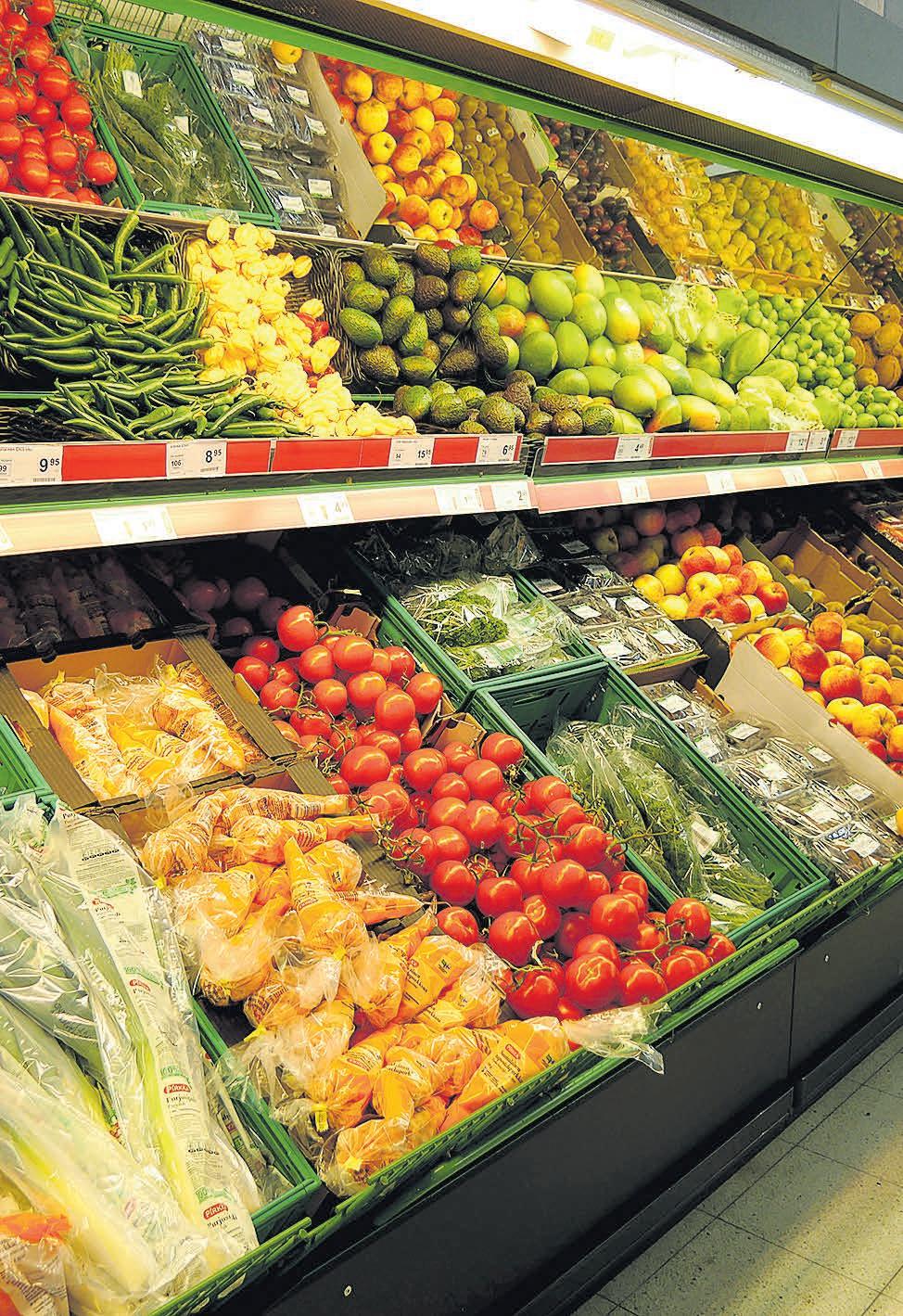
BUYER’S CHOICE: If farmers cannot produce goods at a price that is acceptable to the supermarkets then supermarkets will source product elsewhere, even overseas, says Roger Bray.
system that totally favours those that distribute food products to consumers.
I have few answers and suggest there is little sign things will show improvement going forward. Our country is in a financial bind where we can’t borrow our way to prosperity.
I think we need Team Ag or Groundswell to stick around and start promoting a better food distribution system than we have at present.
How about Groundswell
engage with us and respect our democratic rights.
Lets stop this Bill and reinstate the previous covid-19 fast track process, where the environment and climate were considered, and the process time was reduced to three or four months.
Layers are stifling wool
Donald Cornwall Te Anau
THIRTY-odd years ago I left the industry of growing wool. Back then we were complaining about the $4-5 a kilo we were getting. We have recently had the opportunity to purchase a sheep and beef property in Te Anau basin, and 30 years down the track the strong wool industry is in dire straits.
In my opinion, for what it’s worth, the problem is not with the product itself, but with the many layers of industry that have built massive wealth at the expense of farmers.
promoting Buy Kiwi produce? It won’t provide revenue to purchase oil-based fuels or necessary overseas goods but surely we should not have to compete against imported food?
It sure makes me a bit cross when I walk into Countdown and see Australian grain in breakfast cereals, imported fruit and vegetables when perhaps New Zealanders should be eating NZproduced seasonal food when it is plentiful.
Could there be a plan?
A long time ago, someone shore a sheep, knitted themselves a jersey and thought, Wow, I could sell this. And here we are.
It’s like the power source for the farm is an old 1940s Lister engine that has been tweaked and modified to keep it up to date by an ever-growing workforce of people who pay themselves grotesque amounts money to convince us we need to keep it going.
The wool industry must be supporting thousands of jobs requiring millions of dollars. Bremworth carpets alone employs approximately 460 people, and the farmer is subsidising the lot of them.
Money is being dragged out of our rural communities and making corporations rich.
My solution is that all strong wool growers should say enough is enough and dig a hole and bury their wool clip for a couple of years and see just how important wool is to this world.
Say goodbye to the old Lister engine, replace it with a computer and an email address, and only reply to someone prepared to pay us $10 a kilo.
13 In My View
is a
FARMERS WEEKLY – farmersweekly.co.nz – April 15, 2024 Opinion 13
Firearms laws of a pretty poor calibre
Alternative view

GUN licensing and the firearms registry are back in the news. I’m pleased they are.
The previous government’s firearms legislation was unworkable and rammed through Parliament. Hopefully we can now have a reasoned debate.
Where I become confused is the role of the police in the discussion.
In my view it is far from credible.
Late last year there was a statement from Te Tari Pureke, AKA the Firearms Safety Authority. Remember how we were told that the Firearms Safety Authority was removed from the police and supposedly independent from them?
They’re not, they’re nothing more than a business unit of the police with the Firearms Safety Authority statement coming from the police media centre.
The police statement effusively told me that in September 2023 there were 10,044 licence holders who had joined the firearms registry, bringing 47,162 firearms with them.
We read that “licensed firearm owners across Aotearoa have been responding positively to the registry”. The statement then goes on to tell me how the country will be safer with a registry as it will “disrupt the flow of firearms to criminals”. I don’t believe either statement.
Sadly, that flow of stolen firearms to criminals is a mantra from the police, all be it misguided. For example, a few weeks ago police union boss Chris Cahill told me that there were tens of thousands of illegal firearms in our communities with most of them stolen from licensed individuals or dealer’s premises.
That was countered by the Coalition of Licensed Firearm Owners, who received data under the Official Information Act that said that of the 6500 firearms seized by police over the past three years only 123 were legally imported or manufactured in NZ. That tells me 98% were illegally imported so why do we need an arms registry? The facts don’t stack up. In addition, the firearms offences under the new law have increased.
Why then are the police and their union peddling misinformation?
But back to the Firearms Safety Authority statements lauding the 10,000 gun owners who joined the registry.
There are around 300,000 gun owners in NZ. Ten thousand licence holders is just over 3% of that total. And if I buy a firearm or shift house I am required by law to register my firearms. I wonder how many of the 10,000 volunteered and how many were required by law to join the register? I’d suggest the vast majority were there because the law said they had to be.
Again, why the police obfuscation?
It gets better with, the Firearms Safety Authority telling me that in a recent poll 71% of Kiwis supported the register with only 14% opposed. Unbelievably the poll was carried out for Gun Control NZ. I don’t believe the figures are remotely accurate, especially when the poll told me that 53% of us feel safer now the register is active. Statistics disagree.
Most of my contemporaries purchased a whole-of-life licence years back and when the government changed the law they gave it the twofingered salute.
It seems to me that the Firearms Safety Authority is desperate to maintain its gravy train. I’d humbly suggest that 71% of Kiwi’s wouldn’t know what a gun register was.
Here’s the problem. Most of my contemporaries don’t have a gun licence. They purchased a wholeof-life licence years back and when the then government changed the law they gave it the two-fingered salute.
It is inevitable the same situation will happen with the register. I know those who have their firearms and all the ammunition they need to see them out. Telling them they’re breaking the law is a waste of time encouraging the response “What are they going to do about it?”
And why are the police using taxpayer money to try to distort the democratic process? It does them no credit.
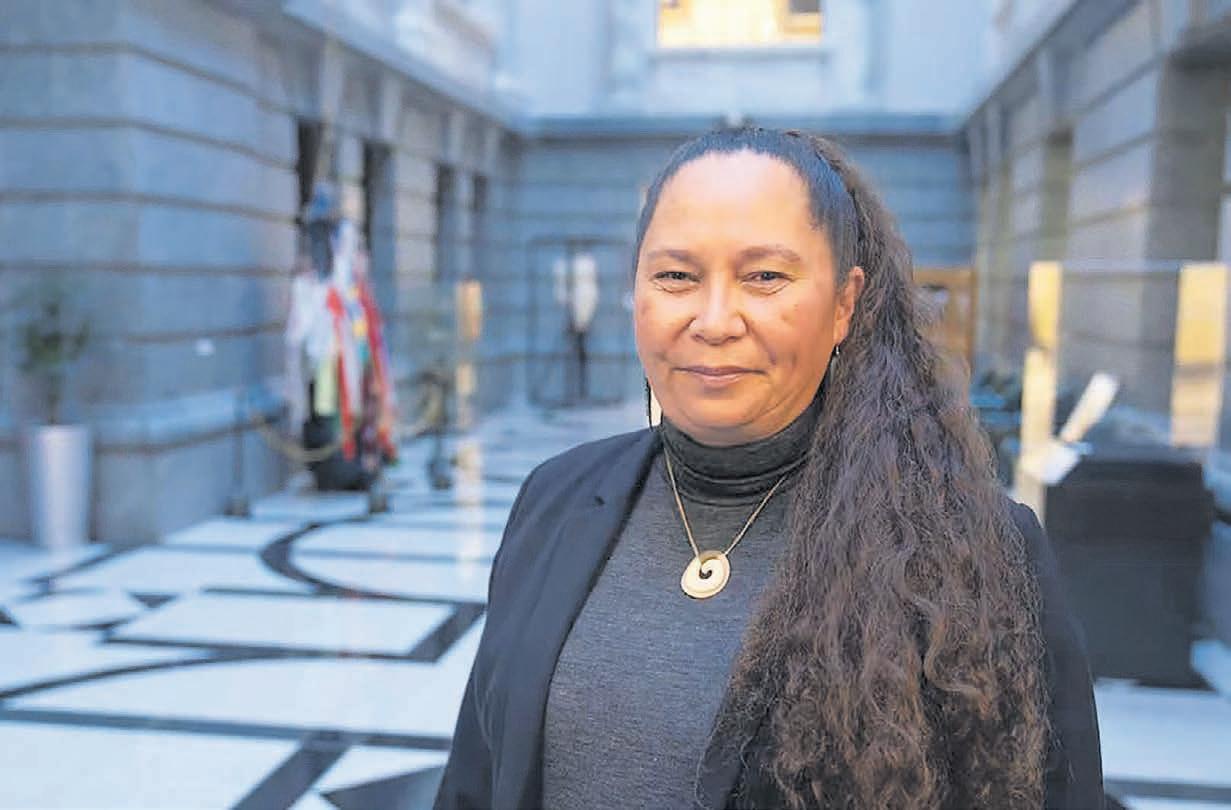
Firearms Safety Authority. She wants to scrap the registry and have instant licence disqualification for gang membership. Finally, she wants overseas offences recognised in the vetting process.
She has already removed responsibility for the Arms Act from police to justice. That will restore much needed credibility into the arms licensing process. Without the McKee reforms the shambles will remain.
I am supportive of the police. In Wairarapa they do an excellent job. I just don’t think a quasi-police organisation running a completely ineffective register is in either the police’s or the country’s best interests.
Is SFF’s strategy vision or just a pipe dream?
Meaty matters

Allan Barber
Meat industry commentator: allan@barberstrategic.co.nz, http:// allanbarber.wordpress.com
It also becomes farcical with Cahill accusing the minister responsible for gun law, Nicole McKee, of misleading statements.
I’d humbly suggest he should know. He added that semiautomatic weapons were used in the Christchurch mosque attack. If the police hadn’t given the shooter a gun licence by their sloppy procedures, he wouldn’t have had any weapons.
The good news is that McKee knows exactly what she is talking about, which is unusual in a politician.
The coalition agreement says the entire shambles will be reviewed and I support that.
McKee wants to create a separate, fully independent
ANEGATIVE swing of nearly $500 million in revenue and $300m in pre-tax profit in consecutive financial years confirms the extreme potential for volatility of the meat industry between good and bad seasons.
It also raises a question mark over Silver Fern Farms’ plate to pasture strategy and the inevitable costs associated with trying to buck the trend associated with a commodity industry.
There will be two diametrically opposing views of the correct answer to this conundrum.
Either it is the only course of action that offers hope of eventually escaping the commodity trap or it is pure
indulgence when the marketplace is more concerned with price than costly “nice to haves” like carbon zero beef.
As with all such black and white issues, only time will tell which strategy is correct and, long term, only one will be the winner.
In the short term the winners appear to be those meat companies that focus on efficiency and control of overheads, particularly in respect of livestock procurement prices and staffing
The word is all the main companies with the exception of Alliance and SFF were profitable during their most recent trading year.
Beef was clearly less badly hit than sheepmeat, which goes some way towards explaining why Alliance was so badly affected, although there were other contributing factors to its pre-tax loss of $97.9m, including the impact of the timing of its September year end on inventory valuation, overstaffing for a drought that never arrived, and the cost of its new computer system.
SFF chair Rob Hewitt also cites mitigating factors for the disappointing turnaround from the previous year’s record profit. These factors were to a great extent the loss of production facilities as a result of Cyclone Gabrielle, with the main North
Island beef plants Pacific and Dargaville being closed for several weeks, and the large investment in IT.
Insurance receipts for the cyclone production losses will compensate to some extent in the 2024 accounts, while a number of IT contractors will no longer be required, saving staff costs.
Time will show whether these factors will be enough to achieve the necessary performance improvement, although Hewitt says the company intends to be back in the black this year.
Plate to pasture’ does not appeal to some processors as a guaranteed path to profitability.
Every cost in the business is under scrutiny and some staff have already been let go.
In answer to a query about the number of people employed in various offices, both overseas and in New Zealand, Hewitt defended the essential nature of these overheads in delivering the company’s market-focused strategy.
He is adamant this is ultimately the only possible way to capture value in competition with global giants like JBS.
14 Opinion FARMERS WEEKLY – farmersweekly.co.nz – April 15, 2024 Opinion 14
Alan Emerson Semi-retired Wairarapa farmer and businessman: dath.emerson@gmail.com
TAKING AIM: The minister responsible for gun law, Nicole McKee, knows what she’s about, says Alan Emerson.
Continued next page
When woke booms, and when it busts
Eating the elephant

David Eade
David Eade is a Whanganui sheep and beef farmer with a finance background, specialising in investments within the primary sector. eating.the.elephant.nz@gmail.com
In this series, the lads go woke
SITTING on a hill, sharing a quick cup of tea and chat with Buster, a loyal heading dog, is a world away from my previous place of work in San Francisco.
Swapping the high-rise building equipped with five restaurants, two cafes, a games room and a gym for the allure of green pastures, now tinged with a strong hint of brown, I reflect on the lessons learnt from
Continued from previous page
“Plate to pasture” does not appeal to some processors as a guaranteed path to profitability, as they point to a lack of tangible reward for the majority of the carcase, even in cases where there is a premium for some cuts.
Hewitt maintains SFF can obtain a higher price for half the prime beef carcase meeting certain defined specifications, which justifies the payment of a procurement premium to suppliers who can meet these specifications. He believes P2P casts a halo over the whole product offering, resulting in a slightly better price for commodity product than would otherwise be achieved.
I suspect sceptics would not agree.
Unfortunately this year has not started well for meat companies and suppliers, with January prompting farmers to hold onto stock to add weight before sending them for processing.
Now the dry has arrived in many regions, there is a queue at the works, but in the South Island lambs in particular will either have to be sold store in the face of limited demand or killed at lower weights.
Meat processors traditionally do well during a drought, but this
working in an environment that many would consider “woke”.
Coming in green from New Zealand, I was exposed to many new acronyms, a major one being DEI – diversity, equity and inclusion, which seeks to promote fair treatment and full participation of all people. The cultural fabric of many startup businesses revolves around these fundamental principles.
The culture generated in these young companies is by no means perfect. A natural tension exists between achieving returns for shareholders and personal soul searching.
To an outsider, it might look as though people are being paid to explore challenging ideals to drive candid conversation rather than focusing on what would be considered “normal” productive means.
I initially found the conversations around these topics to be sticky and hard to fully participate in for the fear of unknowingly causing offence. I would see them as barriers to productivity.
Yet, some of my biggest personal growth came from finding comfort in these thorny conversations. In many instances, the elaborate facilities and freedom to champion person causes weren’t bankrolled by surplus profits, but rather by
year the markets for sheepmeat are depressed. Hewitt says the volumes through the plant by May substantially determine how good the year is, which means the bad
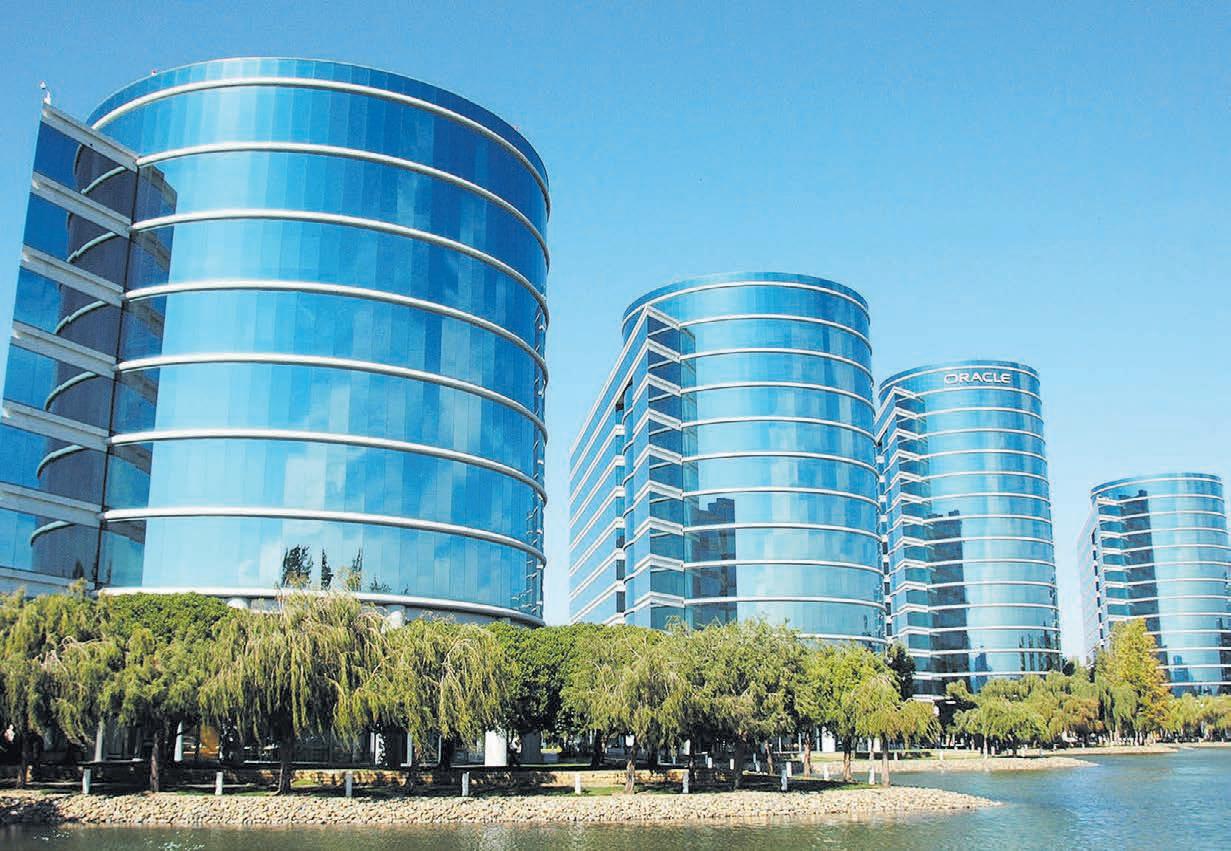
Some of the greatest individual and societal results have been achieved during crisis.
venture capitalists, who, in good times, are happy to take shortterm losses for the hope of large future returns.
The looming question is whether these luxuries remain ingrained in culture fabric as financial constraints tighten.
Small shifts are beginning to appear as financial pressure mounts. A “back to basics” focus is starting to make a comeback, an example of this being Elon
start doesn’t bode particularly well for 2024, although a good June would also help.
SFF’s recapitalisation in 2016, which saw Shanghai Maling’s

Musk’s approach to laying off 80% of Twitter’s workforce following his acquisition, including the vast majority, if not all, roles focused on improving DEI.
I maintain that human beings thrive under a certain amount of pressure, remaining grounded and focused. Without pressure, we tend to over-engineer solutions by adding layers of unneeded complexity.
Some of the greatest individual and societal results have been achieved during crisis when a rational approach to decision making is required. We react based on our collective moral compass, rather than stewing all possible alternatives before stalling on reaching a decision.
purchase of 50% of the company effectively wipe out its core debt and reduce interest charges, has encouraged it to pursue its longterm vision of persuading retailers and restaurants to convince consumers to experience NZ grassfed beef and lamb as a superior eating experience.
This mirrors the work of Beef + Lamb NZ in the development of the Taste Pure Nature programme in key markets in California and China.
This strategy is totally at variance with the traditional view of the meat industry as a predominantly business-tobusiness transaction based on price, relationships and quality of product and service with the final retailer or food service outlet being responsible for the product sale to the end customer.
To follow the longer term visionary approach requires patience, unwavering faith in the strategy and deep pockets to be in the position to cope with the inevitable volatility of what is still a commodity industry.
As we have seen from both Alliance and SFF, one or two good years are no guarantee the good times can continue for ever. The jury is out on whether being entirely market led is an achievable vision or a pipe dream.
I view the many things now labelled “woke” as causes individuals champion when afforded the luxury of free time. It is important that we hold on to some of the progressive strides we have taken, but we do need to apply a level of rationality to the conversation.
The current pressures we face might naturally determine what “woke” elements we keep, and what we do away with.
Pausing for a moment to observe sheep grow serves as a reminder of life’s simple pleasures. At running the risk of over-complicating things, I shared the last of my sandwich with Buster and got back to the task at hand – performing in a sector under mounting pressure.
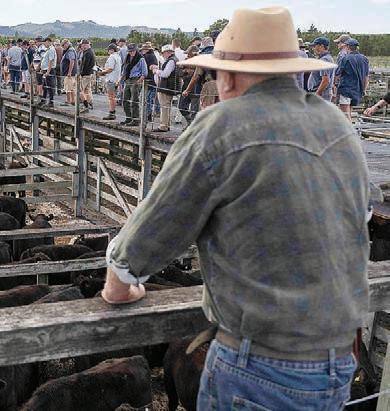
Do you know someone who deserves a story in Farmers Weekly?
Why not write it yourself?
We’re keen to hear local stories about the innovators, inspirations and characters that keep our communities ticking over.
Farmers tell the best stories and we want to hear yours.
yourstory@agrihq.co.nz
15 FARMERS WEEKLY – farmersweekly.co.nz – April 15, 2024 Opinion 15
TREAD LIGHTLY: Working in San Francisco, David Eade at first found conversations around diversity, equity and inclusion to be hard to have for fear of unknowingly causing offence. Photo: Wikimedia Commons
EATING EXPERIENCE: SFF’s long-term vision is to persuade retailers and restaurants to convince consumers of the superiority of NZ grass-fed beef and lamb.
Ready to go the distance for Farmstrong
GLENN Sutton will treat himself to four 20- to 30-minute power naps over the five days in which he will run 617km non-stop later this month.
The Dunedin joiner leaves Milford Sound tomorrow and will follow a roundabout route to arrive back in Dunedin five days later. In between, Sutton will battle mental and physical fatigue and see-sawing emotions, and survive on less than a combined total of two hours sleep – the first shut-eye not expected until 36 hours after he starts.
“The longer you stop, the longer it will take,” he says.
As well as relishing the personal challenge, Sutton is raising money for Farmstrong in recognition of a dairy farming family friend who took his own life a year ago.
Sutton says he wants to support an agency that supports rural people with mental health issues, an issue that is also bolstered by Emersons Brewery, a principle sponsor.
Such daunting challenges are not new for Sutton.
He has completed the 217km Badwater Ultramarathon in Death

Valley in the United States and three years ago ran 570km from Milford Sound to Mt Cook to support the Dunedin Hospice, a run he says tested his limits.
On that run, he passed out 40km from the finish, no longer able to resist the need for sleep. After a 30-minute nap he continued his ultramarathon.
ALL OVER THE MAP: The 617km course Glenn Sutton proposes to run.

“This time I want to see if I can go a bit further,” he says in an understated way.
“A lot of people can’t do these things. I’m up to the challenge to see if it is possible.”
His route starts at Milford Sound and follows the road towards Te Anau for about 34km before
I don’t know if I can do this, but you don’t know if you don’t try.
Glenn Sutton Dunedin
diverting onto the Routeburn Track, which will take him to Glenorchy at the head of Lake Wakatipu.
From there he heads to Queenstown, Wanaka, Tarras, Omarama, Duntroon, Danseys Pass, Naseby, Middlemarch and then to Dunedin, finishing at Emersons Brewery.
His support crew of seven will be crucial to achieving this challenge.
They will run with him, supply food and sustenance and provide a massage if it is needed, but importantly boost his spirits when they are low, and there will be times when they are, he says.
“Just being there, giving me a massage when it is needed or a positive talking to. There is always someone on a high and it may not be me.”
He expects the five days to pass quickly in what will be a series of milestone targets.
During the night he will look
forward to dawn, or the goal of reaching a landmark such as a bridge, anticipating a friend joining him to run a leg or a drink or food break.
Hallucinations could be a challenge – they are usually a sign he has not been eating or drinking enough.
Sutton will not eat anything special, describing his diet as real, wholesome food such as fruit cake and sandwiches.
He stays away from energy gels and chocolate, which tend to make him unwell.
In preparation for this ultramarathon, Sutton has since Christmas had three runs covering 200km and 300km distances.
“I have come off them not broken, injury-free and healthy,” he says.
Despite that, Sutton doesn’t underestimate the size of this challenge.
“I don’t know if I can do this, but you don’t know if you don’t try.”
Storey of sustainability features 25,000 native trees
Staff reporter PEOPLE Sustainability
TE AWAMUTU dairy farmers Doug, Penny, Josh and Bayley Storey have planted more than 25,000 native trees on the family farm, adding to a generations-old native forest. The forest includes kahikatea, tōtara, rimu, pōkākā and mataī and was fenced off 30 years ago to protect it. Doug said the farm has been in the family for six generations, and his parents John and Susan are also involved in the farm’s environmental work.
“We embarked on the sustainability journey because we want to connect even closer to the land and enhance the natural beauty of the farm,” Doug said. “We want to keep eeling in the river and for future generations to play in the forest like we did.”
With help from native planting specialists Koroneiki Developments and volunteers, the Storeys have planted 2.5km alongside the section of the Mangapiko Stream running through their farm, and plan to plant another 1km. They planted around a wetland, which helps attract native birds and other wildlife.
The family have retired four hectares of land from farming to carry out more planting and have a pest management plan in place to help increase the bird population.
Doug is one of 400 environmentally focused farmers in the Dairy Environment Leaders network, created by farmers, DairyNZ and the NZ Farm Environment Trust in 2007. The network aims to empower leadership and create opportunities to support and share on-farm actions to reduce environmental footprint.
Doug’s son Josh and daughterin-law Bayley help run the family farm and are passionate about sustainability and encouraging other young people into dairy farming.
“As farmers, we want to do our best to protect the land and enhance native wildlife, and love seeing tūī, kererū and other native birds on the farm,” Josh said.
The Storeys are involved in a Waipā district community project creating an ecological corridor linking two mountains – Mt
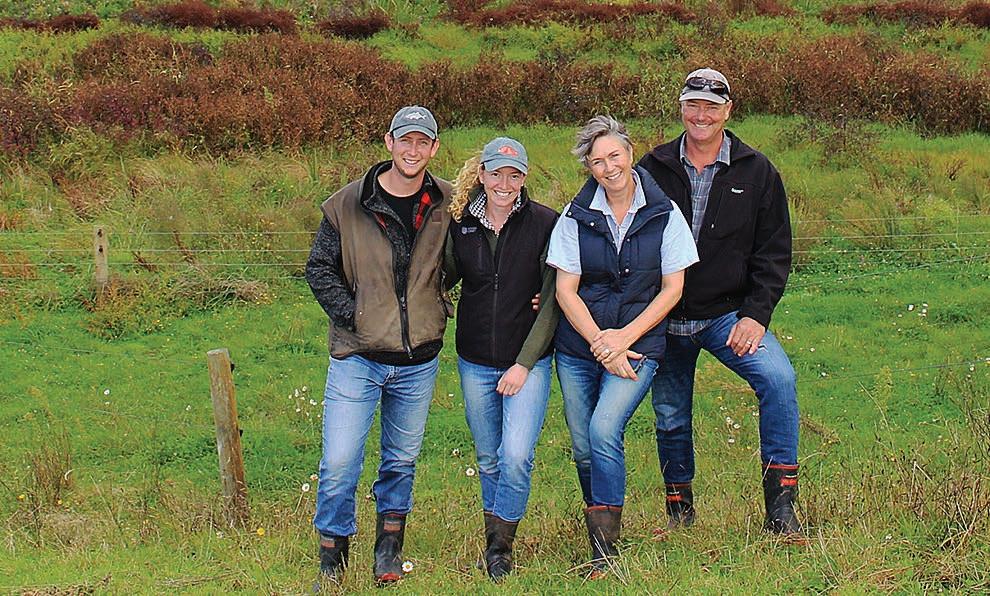
Pirongia and Maungatautari. A key goal is to create great habitat for wildlife, including native birds and bats.
The Taiea te Taiao ecological corridor project sees farmers, iwi, community groups and organisations including Nestlé, Open Country, Fonterra and industry good organisation DairyNZ working together. The work includes a range of environmental work across farms and other properties.
The Storey farm is a stepping stone for birds and bats to rest
and feed as they travel along the corridor.
“It’s a fantastic project and we’re excited to be helping boost biodiversity,” Josh said.
On the family farm and throughout the corridor, bat monitoring is underway and tuna/freshwater eels are being monitored using mātauranga Māori methods.
On the Storey farm, ecologist Britta Deichmann, has catalogued all the native trees, which Josh said will be a great record for future generations.

16 People FARMERS WEEKLY – farmersweekly.co.nz – April 15, 2024 People 16
LONG ROAD AHEAD: Dunedin athlete Glenn Sutton will run 617km to raise money for Farmstrong.
Dunedin athlete Glenn Sutton takes on a daunting 617km run for a cause close to his heart. Neal Wallace reports.
PASSIONATE: Dairy farmers Josh, Bayley, Penny and Doug Storey are passionate about environmental initiatives on their farm and in their community.
PLANTING: Josh and Bayley Storey are planting more native trees to add to the generations-old native forest on their family farm.
Technology
Sheep dosing promises methane cut
Australian scientists are testing methods of getting stock to take their mitigation medicine, as Richard Rennie reports from New South Wales.
WATER dosing, pellets and feed additives are all options Australian researchers are considering when exploring ways to deliver methane mitigators to sheep.
Dr Julius van der Werf, head of animal genetics and production at the University of New England in Armidale, New South Wales, is co-ordinating four research groups across Australia.
In Armidale they are trialling combinations of methane mitigators fed at varying frequencies and quantities to sheep.
In a controlled environment with respiration chambers, they have recorded up to 88% reduction in methane from sheep when fed Asparagopsis, or red seaweed extract.
“We found feeding it twice a day gave a better, more consistent suppression [of methane]. When it was administered every two days, that dropped to only 50% reduction in methane emissions,” Van der Werf says.
In a grazing environment they have been using GreenFeeds chambers to administer a feedbased mitigator and to measure emissions. Methane reduction was lower in a paddock system, likely because not all sheep gain access to their full dose of feed additive.
Groups in Western Australia have been trialling another compound, Agolin. This product is based on essential oil compounds and delivered reductions of 30%.
The two compounds have significantly different cost profiles, with Agolin about 1cent a day, versus Asparagopsis at 15c a day.
“In light of the cost and reduction differences, our current proposal is to combine them or ‘stack’ the compounds,” Van der Werf says.
It was Australian researchers
at CSIRO who discovered the potential value of the Asparagopsis red seaweed, now developed through Future Feed.
The company says the biggest challenge facing it is ramping up production to a level that will bring down the cost and make it more widely available.
While the reductions in methane emissions during the trials are encouraging, Van der Werf cautioned that commercial farm operations are likely to deliver significantly lower results.
“Despite that 80% in pens, we realistically think it will be nearer to 10-20% reduction at an industry-wide level, with lower levels of mitigation on the farm and considering adoption will not be complete.”
While not as significant, it is enough to make mitigators another tool to consider in the toolbox, he says. That will be alongside Australia’s rapidly advancing low-methane genetics programme, and research into alternate feed types.
Options for administration on farm could include dispensing it through the water system, pelletising it, or turning it into a stock lick.
“The best options are the ones where farmers are not having to invest a lot into infrastructure to deliver it.”
Australia’s targets for livestock methane reduction currently are not as enshrined as NZ’s 10% by 2030, and the Federal government is still to set definite reduction levels.
Van der Werf says at present the main pressure points for reduction will come through supply chain and market demands.
He expects that within only two years early adopting farmers will be able to reach for a methane mitigator for sheep.
“And we expect it will be reasonably common to use it in five years.”
Work is also continuing to move the focus on Bovaer, the DSM mitigator, to be trialled on sheep.
Van der Werf also helped
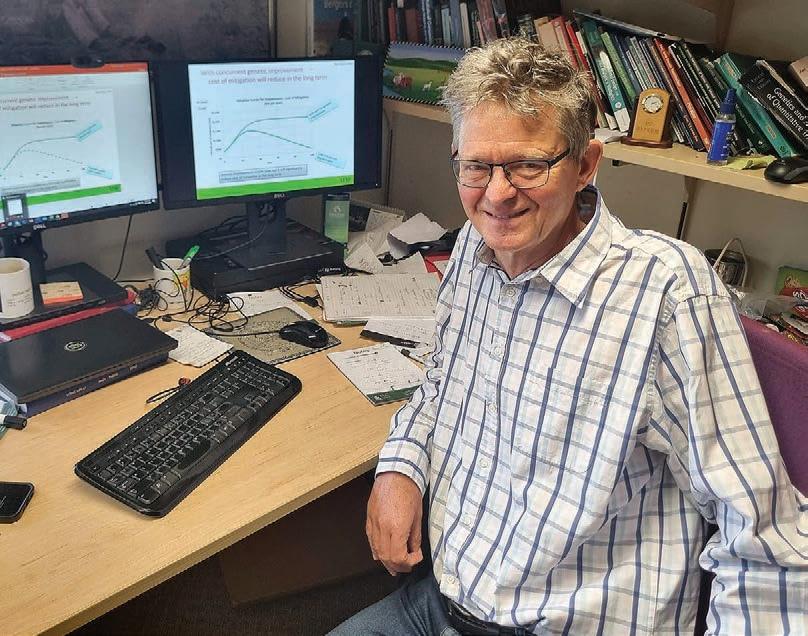
establish genomic selection in Australia’s sheep-breeding programmes and is working hard to apply that technology to achieve sustainable breeding goals, and to bring Australia’s lowemissions sheep genetic data into the national programme.


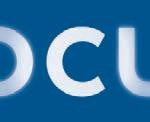
Essentially following NZ’s lead, his team are identifying lowemitting sires using methane measurement chambers, with growing demand from breeders to have their flock assessed.

Reducing methane intensity, or the amount of methane emitted per lamb produced, is the key metric they are working to.
“Increasing productivity goes a long way to reduce methane intensity. If you go from one lamb per ewe to two, you would only need half the ewes to produce the same amount of lamb.
“A balanced breeding programme might allow for some increase of the flock’s methane production by about 1%, but per kg lamb produced, it actually drops by more than 3% per year.”
He expects to have EBVs (estimated breeding values) for methane out by next year, based off testing of almost 10,000 sheep.
“Genetics will play a significant role in reduction of methane.
“If you did not develop the genetics, it would cost the sector about AU$500 million [$540m] a year, relying only upon feed additives.”
Consumers are becoming more aware of the nutritional value of meat, but they’re also interested in understanding how that meat is produced. “ Carolina Realini AgResearch Senior Scientist Red meat and the wellness sector LISTEN NOW Join Farmers Weekly managing editor Bryan Gibson for our weekly podcast covering the big issues in the food and fibre sector. It’s rich farming news for time-poor farmers. 17 Tech FARMERS WEEKLY – farmersweekly.co.nz – April 15, 2024
17
MITIGATOR: Professor Julius van der Werf of the University of New England and his team are having success in achieving methane mitigation from sheep, using dietary additives.
DISCOVERY: Australian researchers at CSIRO discovered the potential value of the Asparagopsis red seaweed as a methane mitigator.
Sector Focus Sheep & Beef
A hobby that’s reducing a pesky problem

DEEP in one of Aotearoa’s most picturesque hunting spots, Central Otago, there’s a group of shooters who reluctantly call themselves “the last of the summer wine”.
Not because of Central Otago’s unrivalled pinot noir, or even because they’ve shared a few reds after many successful hunts. But because, like an aged wine, these gentlemen are on the “seasoned” side of their hunting careers, and highly valuable.
The volunteer rabbit shooters range between 60 and 84, the majority of them over 70 and climbing hills better than they did in their 40s, they reckon. All the while, they’re reducing a problematic rabbit population by over 2000 a year between just a few men.
The group came together about 15 years ago when founding member Ken Copland, who was venturing out most weekends with just his dog, asked his mate Russell Duff along for a shoot.
“We were recently retired and it was an opportunity to get out on a Sunday and get some exercise and do some good for the rural community,” Duff said.
Since that invite, the hunters have grabbed their guns almost every weekend without fail. “It keeps us mentally and physically fit. When you’ve had a great day out there in the hills, aside from the camaraderie, you get a real buzz from the whole exercise.”
Before retiring, the men had jobs ranging from insurance to the travel industry and working as an electrician. The one thing
they have in common is that somewhere along the way they caught the hunting bug.
“From an early age I had a rifle and I did a lot of hunting in South Otago. Then I had kids and worked in Dunedin and didn’t get much time to hunt,” said Duff, who hails from Balclutha.
Member Mike Prendergast, who was a supermarket owner before retirement, was also a New Zealand bore shooter representative for eight years.
“My father was always into it. He was a wonderful shot, shooting clay birds and of course a keen duck shooter.
“As a boy I would always go out with him and I had a single-shot gun. I loved it from the start.”
Their hobby, as it turns out, isn’t purely for selfish reasons.
Shooting benefits the rural community through culling not just rabbits, but wild pigs, deer, goats, geese, ducks and wallabies.
Central Otago has a problematic rabbit population. The plague of rabbits has destroyed thousands of grape vines, chewed through fence
posts and orchard trees, and cost landowners thousands of dollars.
The Otago Regional Council have not kept up with the problem. Pest management hasn’t been covered by rates since 2015, and as the Rabbit Board established in the 1940s had been pulled in the 2010s, the responsibility shifted to landowners to poison, shoot or trap pests.
Many property owners can’t afford the time or costs involved.
A “slab” of bullets costs $250, which equates to about $1 a shot. So, while some pay greens fees, the retirees are shooting away approximately $50 a day to keep the plague at bay.
“Now and again the farmers might make a contribution to it but we certainly don’t seek it and it is more of a goodwill thing to do the pest clearance in return for access,” Duff said.
A daily shoot can kill about 150200 rabbits. The group have shot over 1200 rabbits since January.
“The population has certainly waxed and waned over the years. What we are doing could never
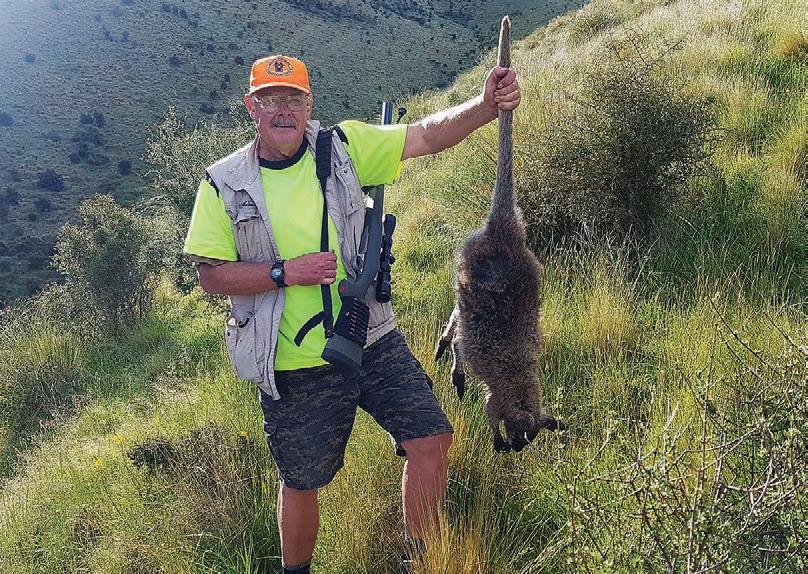

keep up. But we have about 10-12 properties that we will shoot in rotation throughout the year,” he said.
The sport takes them as far as the Waitaki Valley, to West Otago and Southland. On Waitangi weekend they shot 2000 feral geese in Maniototo.
Prendergast conceded that the away trips include a little more luxury nowadays.
“Now that we are getting older, we do like a bit of comfort. We stay in some really good huts and facilities, because you’ve got to look after yourself a bit more,
“The tenting days are over.”
Neither man wanted to say who of the wider group has the best eye, but Prendergast has a secret advantage.
“I had laser eye surgery a few years ago, so I am in full speed.
“It is difficult to say because we are all pretty much on the same page even though we are shooting wings and four legs. We all like to
think we are pretty good.”
His humility couldn’t hide an 18-pointer trophy stag shot in the Cardrona Valley, which sits at the Canterbury gun club as it’s too big for his own wall.
“I always said to my wife I wanted to put it over the bed ... She wasn’t too keen, in fact she has told me not to bring anything home, she is over the duck dinners.”
He has another deer head in his garage.
“That was an interesting hunt. With the patience I waited, he was about 300m away from me, but I shot him clean as a whistle.” The hunt isn’t about the prize, for these men.
“We all love it. From my point of view, I don’t play golf or do a lot of other things. I love getting out in the hills as it keeps me fit and it keeps me involved socially with the guys.”
And at 74, he plans on doing it “as long as I can”.


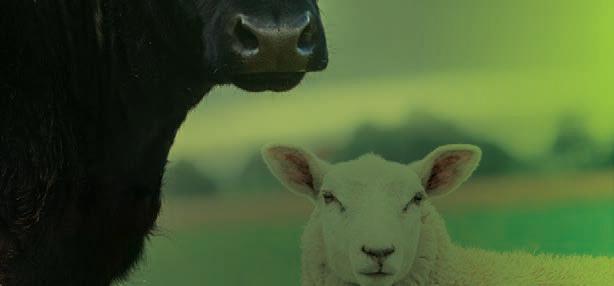

Hear from an impressive lineup of presenters focused on innovative solutions, business diversification, agricultural research, and global trends.
Keynote speakers include Julia Jones and Gemma McCaw with concurrent Pick ‘n’ Mix sessions throughout the day.
Tickets cost $65.00. Limited space, so get yours now at beeflambnz.com/aginnovation2024
BEEF + LAMB NEW ZEALAND AGINNOVATION CONFERENCE 2024
MAY 2024, PALMERSTON NORTH
15
18 Sector Focus
Olivia Caldwell PEOPLE Hunting
VINTAGE: From left, Jim Musin, Brendon Voyce, Mike Prendergast, Russell Duff and Max Dickson.
A GOOD YEAR: Russell Duff shows off his handiwork.
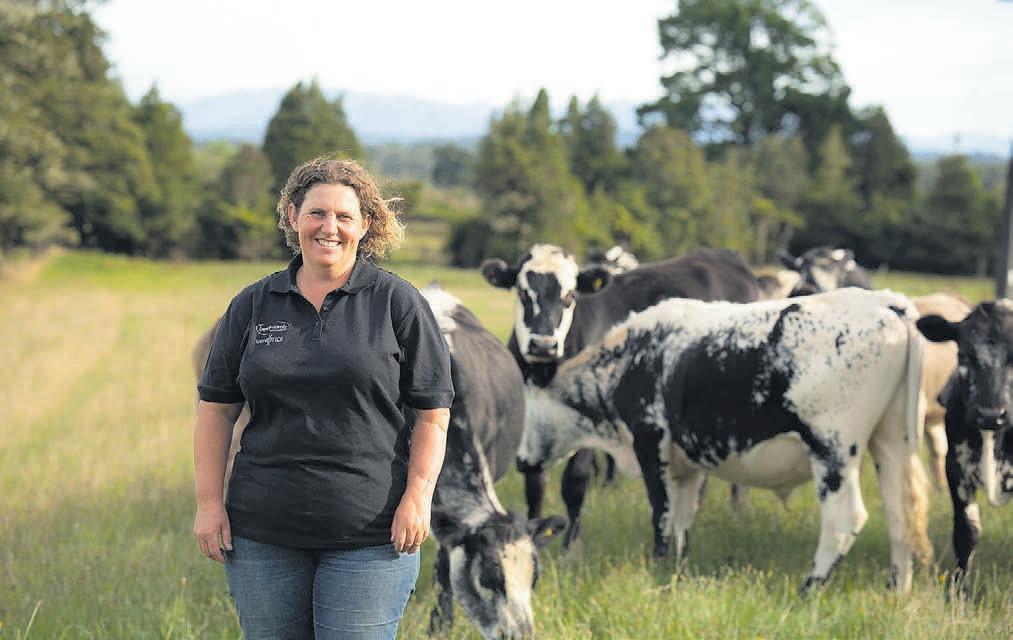
IMPROVING: Sonya Shaw, project lead for commercial herds at Informing NZ Beef, says they hope to get even more farmers involved in the programme.
Better beef genetics is the common goal
 Neal Wallace TECHNOLOGY Genetics
Neal Wallace TECHNOLOGY Genetics
APROJECT to increase the use of high-quality genetics in the beef industry has increased its foothold among commercial beef farmers.
There are now 37 farmers in the sevenyear Informing New Zealand Beef (INZB) programme, which aims to increase the use of high-quality genetics in the beef industry.
The programme’s four main components are developing NZ-specific breeding indexes, building across breed genetic evaluation and data infrastructure, running a beef progeny test and linking in data from commercial herds.
Sonya Shaw, the INZB project lead, commercial herds, said they still hope to increase the number of participating farmers who need to be interested in beef genetics, recording data and using that data. She said participating farmers provide
the programme with accurate pedigree recording, assessments of bull teams’ performances, ensure accurate information for heifer replacement selection and work with their bull breeders to make more rapid genetic progress.
They can also benchmark their herd against others in the programme.
The seven-year INZB partnership, supported by Beef + Lamb NZ, the NZ Meat Board and the Ministry for Primary Industries’ Sustainable Food and Fibre Futures fund, aims to boost the sector’s profits by $460 million over the next 25 years.
“The INZB programme is helping commercial farmers understand the value of better genetics and offer them the opportunity to easily select the right genetics for their system to drive greater profitability on their farms,” Shaw said.
“Being part of the programme also allows for more accurate heifer selection in herds, which will have a lasting impact on the commercial herds’ progress towards their own goals.”
Quarantine drenching the key for autumn stock
Staff reporter TECHNOLOGY Disease
FARMERS buying in stock this autumn are being reminded of the importance of quarantine drenching to prevent importing drench-resistant worms onto their property.
Beef + Lamb New Zealand’s Wormwise programme manager, Ginny Dodunski, said bought-in lambs and calves pose the biggest risk when it comes to importing drenchresistant worms, but replacement ewes, if they have an unknown drench-resistance status, should also undergo a quarantine protocol.
For sheep, the gold standard quarantine drench is a combination of Zolvix or Startect and a Benzimidazole (BZ) /Levamisole drench (given separately but at the same time).
For calves or R1 cattle, Zolvix is the only novel drench registered for cattle and should be given at the same time as BZ/ levamisole combination. The Wormwise website details “compromise” options to these “gold standards” and also outlines
what drenches are not suitable for quarantine.
Dodunski said the quarantine drench protocol is just as important as the product used.
It is important to remember that drenches kill only adult worms and larvae; they do not kill eggs.
This means eggs will continue to pass out of new stock until all the worms laying them are dead. This can take up to three days.
After drenching, stock ideally should be held in a bare yard or on grating, with feed and water, for 24-48 hours. Eggs that pass out of the animal and hatch into larvae have no moisture or blades of grass to live on, so they die.
Dodunski said the alternative is for newly arrived stock to be run into a specific quarantine paddock for 24-48 hours. This paddock cannot then be grazed by the same stock class for several months.
For example, adult cattle should be the only stock to graze a lamb quarantine paddock for six months.
Quarantine-drenched stock should never be run straight onto new grass or other low contamination areas.


















19 Sheep & Beef 19
Good neighbours make good defences

HAVING 35 neighbours could be an issue for some farmers, but for the Moore family it provides alternative grazing opportunities – and became the impetus to breed sheep with a tolerance to internal parasites.
Peter and Cathy Moore, their son Reuben and his wife Morgan, farm Moutere Downs, a 460 hectareeffective sheep and beef farm north of Nelson that includes 15ha of bush under a QEII covenant. They lease an additional 200ha.
The family recently hosted a field day in conjunction with this year’s Beef+Lamb NZ annual meeting.
Moutere Downs is an intergenerational farm running 2600 commercial Romney-Poll Dorset ewes and 800 hoggets, which are also lambed.
This is alongside 300-ewe Romney and 100-ewe Poll Dorset studs.
The Romney stud was started by Peter’s father, Ray, in 1978. Peter started the Poll Dorset stud in 2001.
Moutere Downs is surrounded by 35 vineyards, hop gardens and lifestyle blocks, which provide cheap or minimal-cost grazing after the crops have been harvested.
Each autumn they can access fruit residue once the juice is extracted – grape marc from vineyards and apple pumice from a cider producer – for stock feed.
Peter Moore said the pulp is mixed and fed with baleage, which sheep devour.
These supplements and offfarm grazing enables them to build up covers ahead of winter in an all-grass wintering system – in autumns that are not as exceptionally dry as this one. But the neighbourhood also came with challenges – and finding solutions brought new opportunities for the Moores. The lack of sheep-handling facilities on neighbouring blocks they grazed prevented routine drenching, and that became
the catalyst for breeding wormtolerance in their sheep.
“Today it looks like we were clever but we didn’t have it in our minds to breed worm-tolerant sheep at the time,” said Peter. Worm-resistant sheep genetics were sourced in 1999 from Gordon Levet, a long time breeder of worm-resistant sheep.
Those initial rams were significantly smaller than the large Southland-bred rams they had previously bought.
Peter’s father was not impressed.
“It was like what a lot of sons have done before over the years that have changed a breed or breeding philosophy.
“But they performed and they grew and they provided tolerance to worms.”
Later, when the Levet stud was dispersed, they bought ewes, which were included in the Moore stud flock.
They made gains in breeding for worm tolerance from the first generation they bred, with the worm burden halved.
Today ewes have not been drenched since 2002 although they do provide a ovine multiple mineral drench to compensate for low mineral levels in the soil.
It was like what a lot of sons have done before over the years ... but they performed and they grew and they provided tolerance to worms.
Peter Moore Nelson
Ram lambs are drenched in February. The aim is to supply rams that require only two drenches in their life – one post-weaning and a second for biosecurity reasons when they leave the farm.
Fifteen years after embarking on breeding for worm tolerance, the Moores turned their attention to breeding for tolerance to facial eczema.
The focus is now shifting to low methane emitting sheep, something Moore said is important

to his ram-buying clients.
Last year they DNA-tested 150 hoggets and measured emissions through a special trailer to identify a breeding base.
Moore said it takes 20 to 30 years to make significant gains in breeding for a particular trait, but such are the financial and climatic challenges this financial year, the programme has been put on hold.
He said productive traits will always be a breeding priority over methane emissions.
“It’s a nice-to-have or politically correct trait, but unless it can produce more money at the end of the day, it is not going to be a priority.”
Crucial to their breeding programmes has been using nProve, a genetic tool that enhances genetic selection decisions.
Scanning percentages among commercial ewes are 145-155% but survivability is high at 135% with lambing starting from the end of July.
Around tailing the ewes and lambs are rotated in mobs of 200300 and typically they will get two or three pre-weaning drafts.
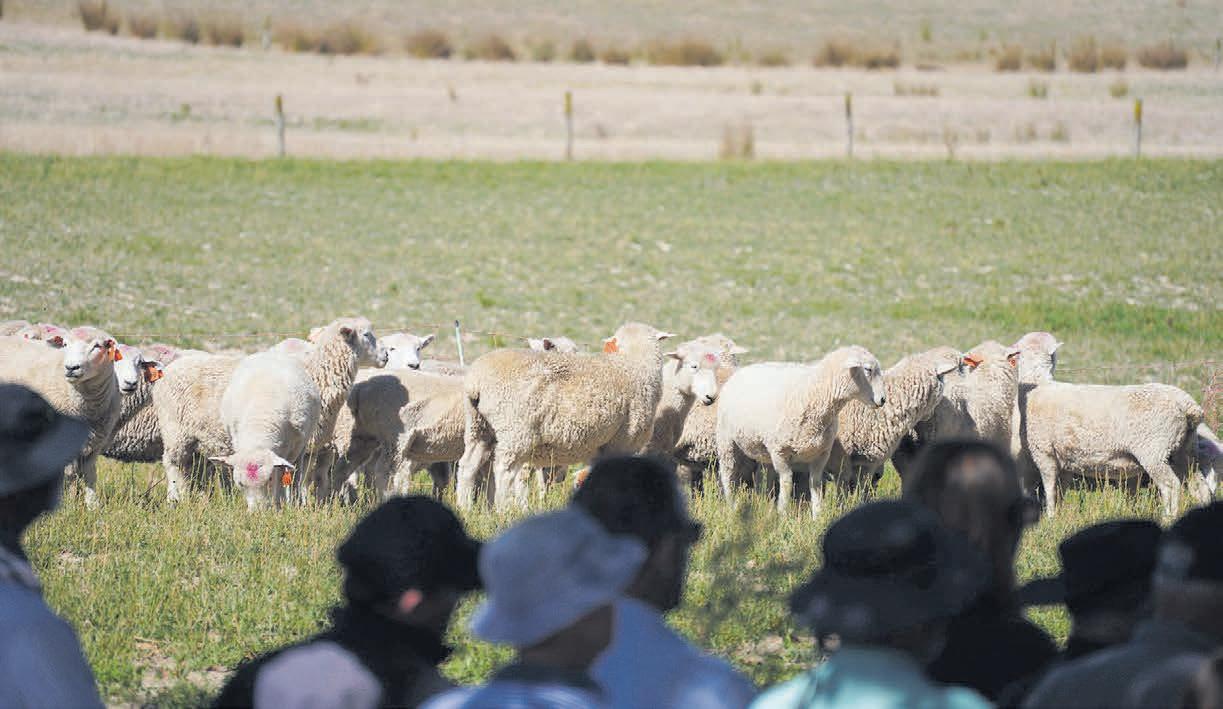
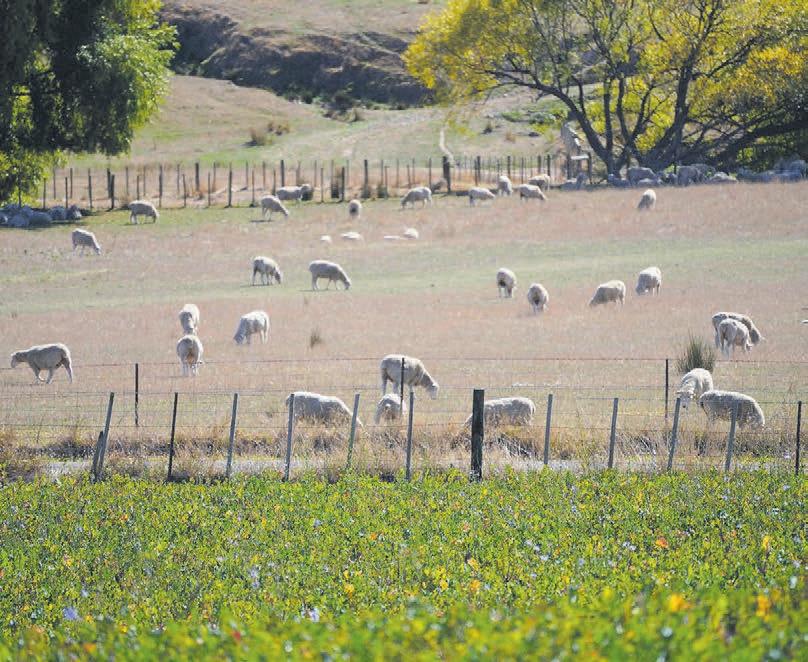
Weaned lambs are then grown out on lucerne and Raphno brassica and chicory forage crops and finished at 19kg carcase weight.
This year’s dry weather has made those targets unachievable. Prime lambs have averaged 16.8kg.
All 800 hoggets are mated and those certified as dry at scanning sold to a repeat buyer for breeding as two-tooths.
The family’s focus today is on the twin challenges of drought and low prices and expenses.
Moore said just 71mm of rain fell between December and March when normally they would record more than 300mm.
Once it rains, they will use nitrogen to boost feed ahead of winter but Moore said that could be hampered by falling ground temperatures.
This season they have applied only 20 tonnes of fertiliser, when normally they would have applied 150t, and they have had to buy 300 bales of baleage, which had not been budgeted for. It will last only about a month.
Similarly, ram-buying clients are
either buying fewer rams or, as in two cases, none at all.
“It’s a double-edged sword for everybody,” he said.
Recently he sold 480 lambs as store that would normally have been taken through and sold over winter.
Moore provided data that showed returns from ewes this year were about half what he received for the past two years, while lambs this year are $90 compared to $108 last year and $126 in 2022.
Interest and rent are 37% higher. In 2022 gross farm income per stock was $137.92 but that fell to $121.55 in 2023. This gave an economic farm surplus per stock unit of $53.42.
Farm working expenses per stock unit in 2022 were $79.40 but increased to $87.42 last year, meaning the economic farm surplus per stock unit had plummeted in 2023 to $29.25.
Financially, this is one of the toughest years Moore has endured, with the dry weather combining with low product prices and rising prices.
20 FARMERS WEEKLY – farmersweekly.co.nz – April 15, 2024 Sheep & Beef 20
Neal Wallace ON FARM Genetics
PADDOCK: Reuben and Peter Moore in a paddock of Raphno brassica and chicory.
RESISTANCE: Those attending a Beef + Lamb NZ field day at the Moore family’s Nelson farm view stud sheep.
DRY AS CHIPS: Like many farmers at the top of the South Island, the Moore family from Nelson are dealing with the triple challenges of drought, low product prices and rising costs.


Helping commercial beef breeders make informed bull buying decisions
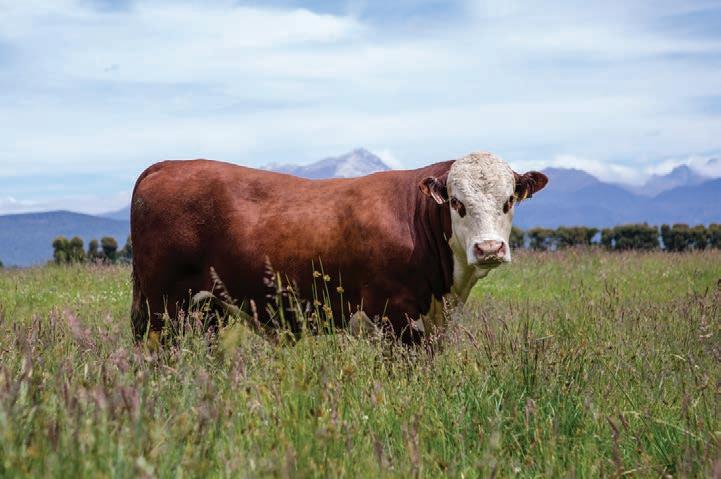

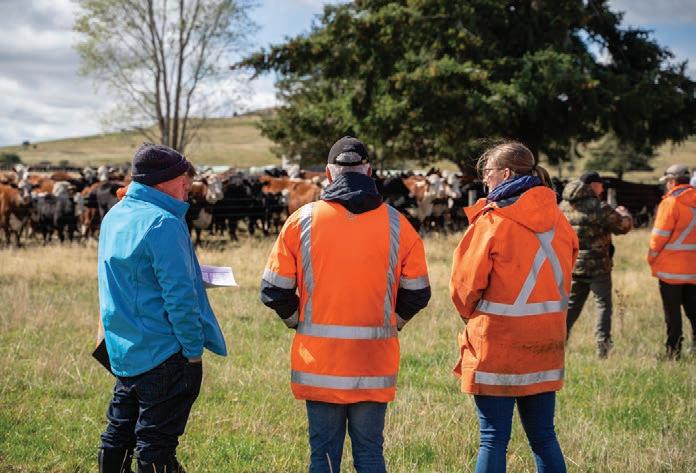
In the lead up to bull-selling season, Beef + Lamb New Zealand is running 22 Better Beef Breeding workshops throughout the country to help farmers select the best bulls for their business.
Part of the Informing New Zealand Beef programme, these hands-on, on-farm workshops will help farmers understand the information presented in bull catalogues and learn which structural traits are important when selecting a bull.
This will help ensure commercial beef breeders are getting the best return on their genetic investment.
Steps covered include setting breeding objectives, selecting a bull breeder that matches those objectives and using genetic and structural information to assess sale bulls.

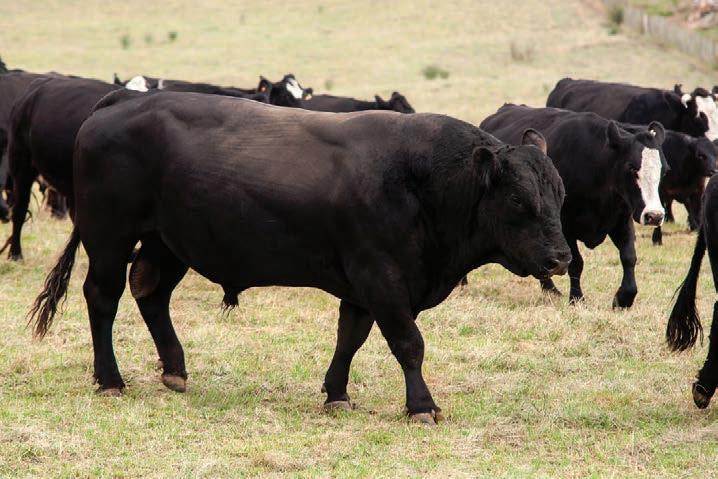
Visit beeflambnz.com/events to find dates and locations of a Better Beef Breeding workshop near you.

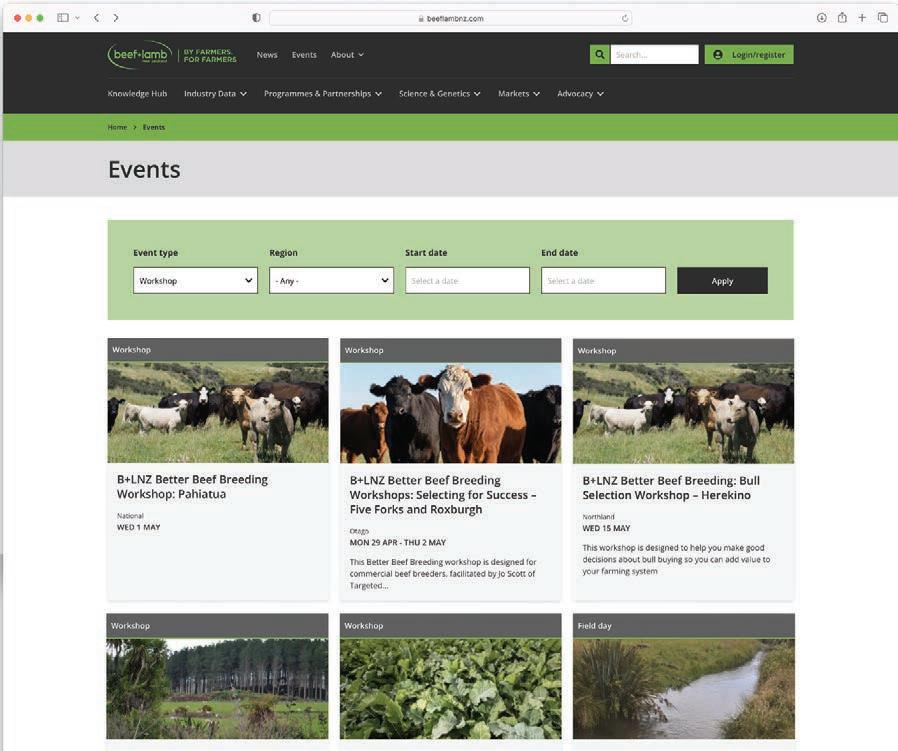
21
A silent majority well worth hearing from
Farmers have a lot on their plate right now, but don’t let that – or the social media circus – drown out voices of reason and hope.
Sector perspective
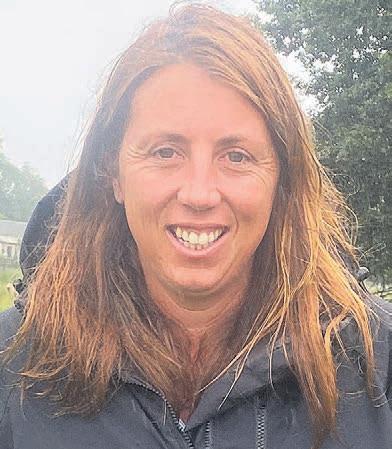
WITH many farmers facing incredibly tough conditions on farm due to drought and financial pressures, no one can be blamed for wanting to put their head down and get on with things.
Every so often I dip into Facebook and I’m more and more disheartened at the noise – the shouting, the targeted attacks, the tendency for some to talk past each other and the politicking. It’s making us more divided when we need to be united, and inevitably it’s making a whole lot of people tune out and turn off.
My feeling, backed by the farmers I talk to every day, is that this is a vocal minority and that the bulk of the farmers out there have just got their head down, trying to work out how they will pay their wages/contractor/bank next month.
These are the farmers who, after
putting in 10-12 hours on farm, get home and can’t face a mountain of paperwork, can’t face the politics in the rural papers and certainly haven’t got the spare headspace to sit down and read six pages of Beef + Lamb NZ farmer remits and voting information.
They simply want to focus on farming and do the right thing by their families, businesses and rural communities.
We’ve just seen disappointingly low voter turnout (12%) for our most recent annual general meeting and farmer remits. Is this a case of apathy and a lack of interest in our organisation, or lack of interest in the remit topics?
Or is this just a timing thing and a case of farmers with a lot of other things on their plate? Are there farmers out there who are a little perplexed about all the noise?
Strong voter turnout is important; it gives us a strong mandate to speak and act on behalf of farmers. I certainly don’t believe that 88% of our farmers don’t care – I just worry they don’t have the headspace and time to speak up.
All voices matter, so how do we make sure they are given even weighting? How do we make sure the silent majority can be heard?
This year most of the remits were focused on climate change. I know many farmers are worried about this, but does the number of remits mean this is the top issue for farmers right now? As a farmer, I think what is top of mind for many at the moment are lamb prices and costs of production.
As a board, we need to consider how we interpret the remit results when we get a low turnout. Do the results represent the majority view, or those who have a particularly strong view on the topic?
What’s clear to me is that although we take remit results seriously, we need to hear from more farmers.
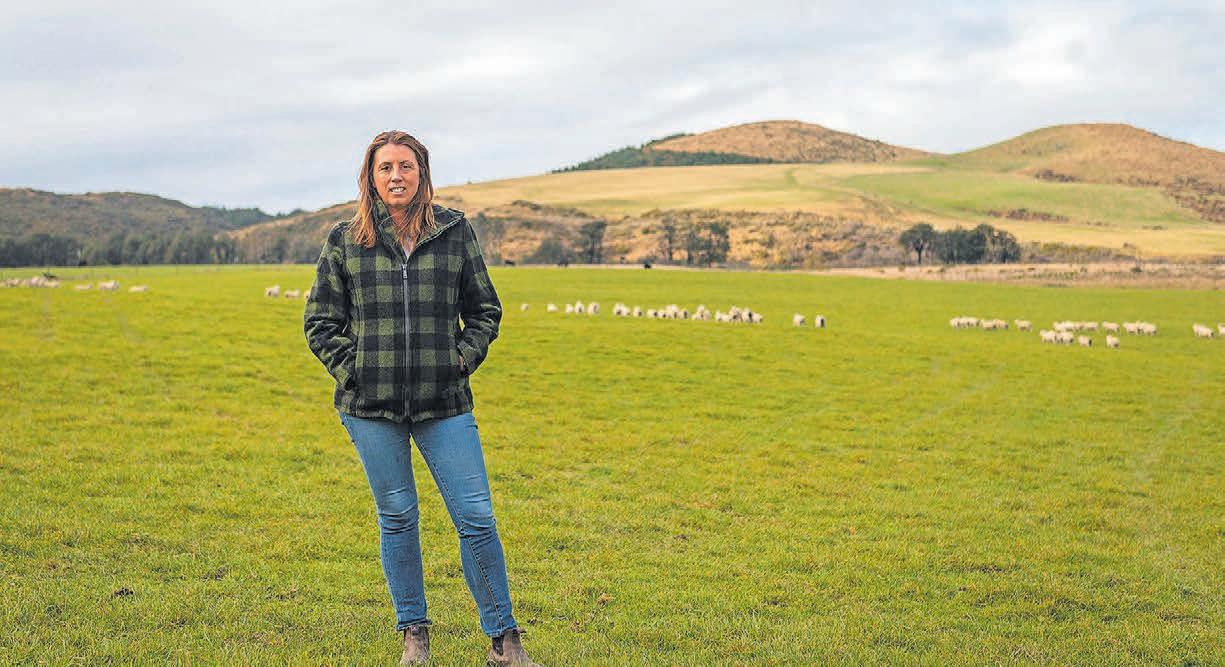
HEADSPACE: BLNZ chair Kate Acland says of the 12% voter turnout at the recent AGM that ‘I certainly don’t believe 88% of our farmers don’t care – I
Twelve percent isn’t enough.
We hear from our exporters, our global markets and from our New Zealand trade representatives that environmental and climate credentials will become increasingly important and that NZ is well placed to take advantage of these opportunities.
We hear from respected climate scientists who state that although methane is part of a cycle, it does have a warming impact, particularly if it is going up. They tell us the current methane targets are too high, but also tell us the targets should not be zero –agriculture has a role to play.
BLNZ’s position is clear – the current methane targets are too high and they have to be revised down and there is currently no justification for a tax on on-farm emissions.
Implementing emissions pricing without readily available technological solutions would be detrimental to both the agricultural sector and the wider NZ economy. We won’t budge on this.
Social media is increasingly becoming an unpleasant space to be in.
I’ve deleted Twitter/X, I’m almost done with Facebook, and Instagram is not far behind. I’m sure I’m not alone in feeling the shouting is becoming overwhelming.
What’s clear to me is that although we take remit results seriously, we need to hear from more farmers. Twelve percent isn’t enough.
Where do the bulk of our NZ farmers sit? Where do they get their information and what do they need to know?
How do we ensure all farmers have the confidence to speak up and engage? How do we focus on what we all DO agree on? This is how we have the best chance of succeeding and landing enduring solutions.
I don’t have all the answers to
these questions, but what I do know is that it’s important that we give space for everyone so we hear all sides of the story and take an informed view of how we best position our sector to succeed into the future.
Yes, it’s hard to be thinking about the future right now when the day to day reality is a grind for many of us – but we know as farmers we deal in cycles, weather, finance and markets. Unfortunately we’re in the perfect storm right now where they are all hitting us at once – but the good thing about cycles is they will turn.
We absolutely must continue to look to the future, we must make sure that the voices we’re hearing today are the ones guiding our sector to the place our children will need it to be, which almost certainly will be different to where farming was in our parents’ time.
MORE:
Hear a full interview with Kate Acland on Farmers Weekly In Focus, wherever you nd your podcasts.
Muka Tangata to freshen qualifications

TWO projects led by Muka Tangata are reviewing food and fibre career pathways focused on building fit-for-purpose qualifications with increased support for skillsbased training across the primary industries sector.
Beef + Lamb New Zealand is working with Muka Tangata to ensure outcomes are tailored to the sheep and beef sector.
The agriculture qualifications development projects, launched in March, will be supported by the New Approach to Learner Pathways project which is designing a multi-level food and fibre skills framework to bridge the formal/non-formal learning divide.
Alongside the agriculture project, the Entry Level

project will ensure ease of transition between different levels of training and qualifications and improve transferability of skills for
the agricultural workforce. The entry level project is reviewing all Level 2 and Level 3 food and fibre qualifications,
aimed at making new qualifications for people just starting out in farming, ensuring they are equipped to work on farm.
Through the agriculture project, Muka Tangata will review and develop qualifications, standards and micro-credentials from Level 3 to Level 5 for agriculture industries including arable, dairy, sheep, beef, deer, pork, and poultry farming.
The aim at this level is to improve qualifications for people who are already working in the industry.
BLNZ’s national extension programme manager, Olivia Weatherburn, said the industry organisation is supportive of Muka Tangata’s approach and what it is trying to achieve in equipping farmers with qualifications that formally validate their skills.
“It is important to get these qualifications right to give farmers the confidence that prospective
employees have the necessary skills for the job.
“We’re big advocates for continual learning to foster a skilled and confident workforce within the food and fibre sector, supporting its growth,” Weatherburn said.
Muka Tangata is also working in collaboration with other industry partners, iwi Māori, schools, Kura Māori, trades academies, employers, and providers across the regions to ensure that a broad view of the needs of the industry are met.
Interested parties can share in discussion at wānanga around the country to learn more about the projects, provide general feedback on the existing qualifications and standards, and share aspirations of future industry training. These will be held in Hamilton on April 30; Wellington May 2; Christchurch May 7 and online May 9.
22 FARMERS WEEKLY – farmersweekly.co.nz – April 15, 2024 Sheep & Beef 22
Kate Acland Acland is chair of Beef + Lamb New Zealand
just worry they don’t have the headspace and time to speak up’.
Photo: Clare Toia-Bailey
Annette Scott NEWS Education
LIFELONG LEARNING: BLNZ national extension programme manager Olivia Weatherburn says ‘we’re big advocates for continual learning to foster a skilled and con dent workforce’.
FARMERS
Methane review a major win for farmers
Federated Farmers secured another major advocacy win last week, with the Government announcing an independent review of our national methane reduction target.
This review is a really positive step forward for farmers, rural communities and the New Zealand economy – but it hasn’t just fallen into our lap or happened by chance. It’s taken a lot of hard work and sustained pressure over a number of years to ensure our politicians and policymakers properly understand methane’s di erent warming impact.
Our current methane reduction target of 24-47% has been deeply unpopular with farmers since it was introduced in 2019 because we all knew it wasn’t realistic, a ordable or fair.
It also went much further than what was needed to stop farmers contributing to further warming, despite the huge costs this would put on farmers, rural communities and our national economy.
Those numbers weren’t speci c to New Zealand. They were plucked from an Intergovernmental Panel on Climate Change report and applied out of context, even when the report said they shouldn’t be used for that purpose.
The Government of the day knew the targets were driven by political convenience rather than scienti c evidence, but happily threw farmers under the bus and portrayed us as the villain anyway.
That’s why Federated Farmers are proud to say we we’ve opposed these targets from day one.
It’s also why we’ve pushed so hard for this independent review and made it one of our 12 policy priorities for restoring farmer con dence during the election.
Last year Federated Farmers joined forces with DairyNZ and Beef + Lamb NZ to commission a report that measured the warming impact of New Zealand’s current methane targets.
The study was carried out by the universities of Oxford and Cran eld and led by an internationally respected and highly credible
If other countries meet their existing emissions reduction commitments, then a 15% reduction in methane would see New Zealand methane contribute no additional warming from 2020 levels.
climate scientist, Professor Myles Allen.
Allen is a Professor of Geosystem Science at the University of Oxford, Director of the Oxford Net Zero Initiative, and has been described by the BBC as ‘the physicist behind net zero’.
The report found the current targets could see methane reductions o set all of the expected additional warming from carbon dioxide and nitrous oxide from the entire New Zealand economy.
If other countries meet their existing emissions reduction commitments, then a 15% reduction in methane would see New Zealand methane contribute no additional warming from 2020 levels.
It was also noted that if countries signi cantly increased their current levels of ambition, a reduction of up to 27% may be required.
This is signi cantly lower than the current methane reduction range of 24-47% and demonstrates the importance of taking a warmingcentred approach to emissions reduction.
We can’t lose sight of what we’re trying to achieve here: we’re trying to prevent further warming. That’s why the Paris Agreement set a temperature target of limiting warming to below 2 degrees.
Reducing emissions is how we prevent warming, but it’s important to remember not all emissions have






















the same warming impact. Methane behaves very di erently in the atmosphere than CO2.
We need to be taking a scienti c approach to target setting that considers those di erent warming impacts when setting our climate policy.
For too long farmers have been told we’re responsible for half of New Zealand’s emissions, but looking at emissions alone simply doesn’t paint an accurate picture.
Kiwi farmers already lead the world when it comes to producing lowcarbon meat and milk. We’ve made huge progress and our methane emissions have been stable or declining for over a decade.
This means we don’t have a hell of a lot of low-hanging fruit left to help us reduce our emissions without new technologies.
Without those new technologies, the only way to achieve large
FAIR: Revisiting methane targets isn’t about letting farmers o the hook, it’s about making sure we aren’t being asked to do more than our fair share of the heavy lifting, Federated Farmers president Wayne Langford says.
reductions would be through having less cows, sheep and food production in New Zealand.
That would be devastating for our economy and rural communities, with our food and bre sector accounting for 82% of our country’s total exports.
Other parts of the economy are being asked to reach net zero and stop their contribution to further warming by 2050, but currently farmers are being asked to go much further.
It’s important this review is given a clear objective of aligning methane targets with what would be required to stop farmers’ contribution to further warming.
This isn’t about letting farmers o the hook; it’s about making sure we aren’t being asked to do more than our fair share of the heavy lifting or bear a disproportionate amount of the cost.


23 Feds FEDERATED
Vol 2 No 13, April 15, 2024 fedfarm.org.nz ARE YOU A MEMBER? Yes! I'm on the team. NO? Let's talk. Join the conversation. Become a member today. 0800 327 646 fedfarm.org.nz
Wayne Langford Federated Farmers national president
Wayne Langford Federated Farmers president
FAIR’S
Feed support for drought-hit farmers
With grass “burnt to toast” in some districts and winter crops struggling, Federated Farmers has relaunched the Feed Coordination Service.
Those who register for the service can list feed for sale, or their interest in buying feed.
“Last month we were thinking we’d only need to run it for the South Island,” coordinator Ben Moore says.
“But then on March 28 the medium-scale adverse event classification was extended to big chunks of the North Island.”
Federated Farmers leaders from Marlborough, Otago, ManawatuRangitikei and Wairarapa have
reported plenty of farmers have paddocks of dead or dying grass, and they’ve been forced to use winter feed.
“Winter crops in the ground in drought-hit areas are suffering. Yields are likely to be well back,” Moore says.
Winter crops in the ground in drought-hit areas are suffering. Yields are likely to be well back.
“There’s always going to be feed around but, for some farmers and lifestyle block owners, they’re going to have to buy it from out of area.
“The grass is burnt to toast in many places.”
There has been muted criticism in the past that the Feed Coordination Service becomes a ‘price setter’ but Moore rejects this.
“It’s just another option for farmers and contractors – another way for buyers and sellers to see what’s out there.
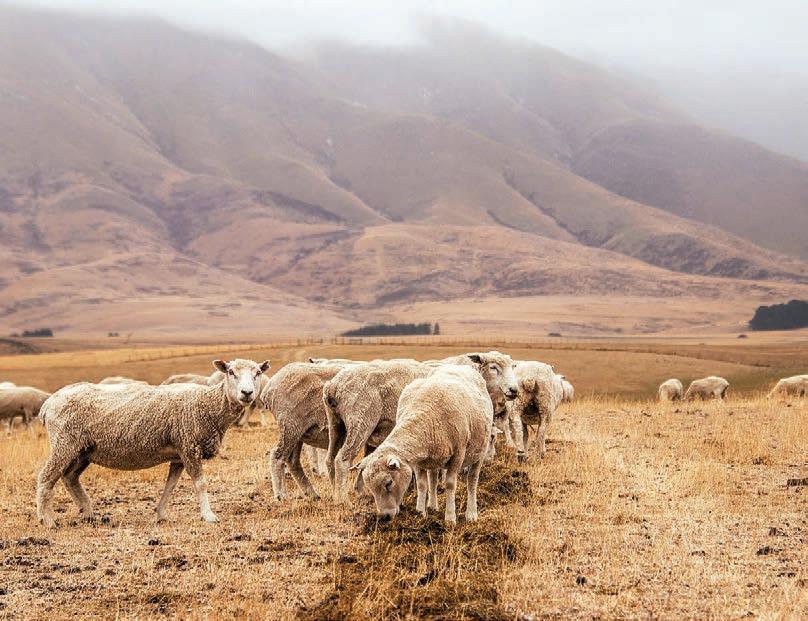
TINDER: Federated Farmers leaders from Marlborough, Otago, Manawatu-Rangitikei and Wairarapa have reported plenty of farmers have paddocks of dead or dying grass, and they’ve been forced to use winter feed.
“But it can save people from having to trawl the internet for an hour trying to find a contract or going through TradeMe listings and so on.” MORE:
Rural mums launch kids’ clothing line
Frustration at the lack of clothing options for their sports-mad kids was the spark for two rural women to step into the apparel game.
Waikato dairy farmer Tania Moss and good friend Nicole Kidd, each with three children, say the idea to start a children’s activewear brand came to them in 2022.
“All our kids are really active, but we noticed there wasn’t a lot of sports clothing out there for them,” Federated Farmers member Moss says.
“We’ve got so many friends also complaining that they can’t find the right activewear for their kids to wear to gymnastics, dancing, rugby and so on. So, we saw a gap in the New Zealand market and decided that’s what we wanted to do – fill it.”
Moss and Kidd have just launched their company Outplay (outplay. co.nz), selling their range of clothing online and primarily targeting other rural parents.
“A lot of our friends are farming community mums – rural people. Everyday families are who we want
FOR
to buy our clothing,” Moss says.
“Anything out there in New Zealand at the moment, apart from the
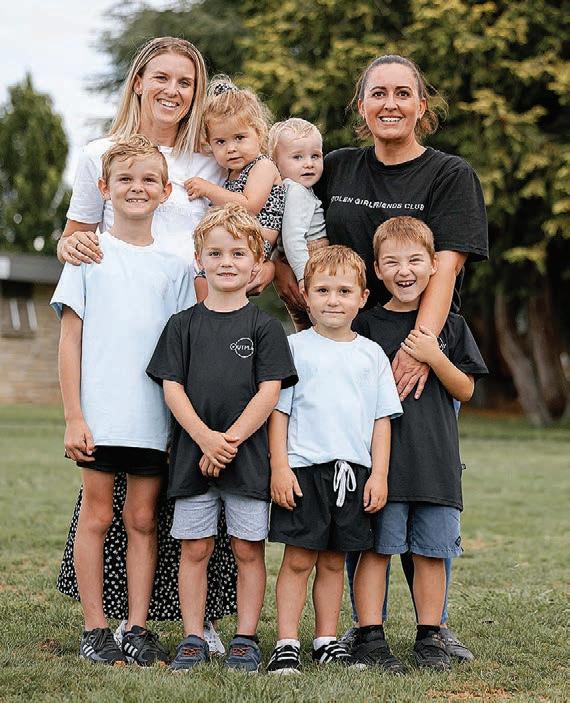
cheaper stuff, is all quite pricey.
“We want to provide high-quality clothing that’s affordable for farming families.”
For example, Outplay’s girls’ bike shorts are $44.90, and a matching crop top (“so they can look like mum”) comes in at $39.90.
The entrepreneurs say it’s taken a lot of work to develop their clothing range, which they describe as easy-wearing and durable, with style and comfort in mind. Support from Moss’s sister-in-law, who owns successful women’s clothing company Mi Moso, has been invaluable.
“Her experience and contacts have been a huge help,” Moss says. “She put us onto a clothing manufacturer who’s been amazing to work with.”
Both women are strongly rooted in farming, but also have legal and financial skills that have proved useful in starting a business.
Kidd, who grew up on a dairy farm in Matamata, worked in rural
banking before starting her family. She and husband Jeremy are among the directors of King Electrical, which services Matamata’s rural community.
Moss, a 50/50 sharemilker with husband Brent in Te Poi, near Matamata, manages the farm finances and used to work as a legal executive.
She says she’s grateful to be a farmer, as it’s afforded her the lifestyle to start another business.
“If we weren’t farming, I don’t think I’d be able to even look at doing anything like this.
“The dairy farm is our main source of income, and that’s allowed me the time and funds to pursue something else as a business.”
It’s early days, but the move from farm to fashion has been an exciting one so far for the friends.
“It’s been an awesome journey getting into business. We’re really looking forward to seeing where this could go,” Moss says.
Fostering producer confidence and harnessing innovation for a resilient primary sector






PRIMARY
NEW ZEALAND SUMMIT & AWARDS
JULY 2024, TĀKINA WELLINGTON
INDUSTRIES
2-3
24 April 15, 2024 – fedfarm.org.nz Federated Farmers 24
‘Feed Coordination’ button.
To register, go to www.fedfarm.org.nz and click the
Ben Moore Federated Farmers feed coordinator
FIT
PURPOSE: Rural entrepreneurs Nicole Kidd (left) and Tania Moss (right) started their kids’ activewear company after struggling to find sportwear for their own kids.
Understanding India is our first task
Getting to grips with India’s needs and motivations is the first step to opening trade doors, New Zealand’s Special Agricultural Trade Envoy (SATE) says.
Hamish Marr has just returned from a 14-day trade mission to India and says he was struck by the scale –and potential – of farming there.
“After such a short visit, I’m not going to pretend I know the answers on how we should go about lifting trade between our two countries. The issues are complicated,” he says.
“But I firmly believe our first task is to show some respect for India’s culture and achievements, and understand their motivations.”
India is the world’s largest producer of milk and pulses, and the second-largest producer of rice, wheat, sugarcane, groundnut, vegetables and fruit.
India doesn’t need us or our food output, he says, but we could look for ways to make ourselves valuable trading partners.
“Our scale versus theirs really struck me. Yes, we export a lot for the size of our country, but we’re a minnow in comparison,” Marr says.
“We have to be thinking about
what New Zealand can do for India, because if we don’t, India will just swallow us up.”
European Union nations, where Marr visited before Christmas, also heavily subsidise agricultural production but in many respects “couldn’t be more different”. His impression is that the EU’s subsidies are about holding back food production.
Farmers who still roll their eyes at Fonterra’s Scope 3 emissions or Silver Fern Farms’ low-carbon supply chain ambitions need a reality check.
Hamish Marr Special agricultural trade envoy
The reason usually given is food security, but Marr believes it’s really about avoiding market gluts and a sharp focus on the environment.
“The politics of the day are really front and centre there.”
While subsidies in the EU and India distort markets, India’s are about trying to lift local production.

“I see a country with a lot of mouths to feed, a country where 65% of the population lives in rural areas, and one that can’t afford to have those people moving to cities.
“Their ambition is to make the life of these often subsistence farmers better, by introducing more technology and co-operatives.”
Marr says that’s where New Zealand could help: we have technology and production practices to share.
“Showing respect, building relationships and looking for valueadds for both countries is the way forward.
“We have plenty to offer India. For example, we can put the case that we offer a different kind of milk based on pasture that will be sought-after for some things. Our horticulture sector has R&D and varieties that are attractive to the Indian market.”
Marr, a fifth generation Canterbury arable farmer, a Nuffield Scholar and former Canterbury representative on the Federated Farmers Herbage Seed Sub-Section, was appointed SATE last July.
Even though it’s a government appointment, he’s not there to advocate the government’s view.
“The agricultural envoy is the independent voice of New Zealand farmers to our Government, overseas governments and our trading partners.
“Too often the farmers’ voice is missing in the room when discussions on trade are happening.
“I can speak independently of the politics of the day and with the farmers’ point of view overseas. I work alongside trade officials and often see opportunities or pitfalls that otherwise might be missed.”
Marr says he’s loving the role and learning plenty, with plenty more to learn.
“I’ve come to realise there are a lot of people in MPI and Foreign Affairs doing great work on our behalf on market access, border restrictions and the like.

DIALOGUE: Among those Special Agricultural Trade
Envoy Hamish Marr discussed trade issues with was Dr Ashish Kumar Bhutani, Secretary of India’s Ministry of Co-Operation.
“We wouldn’t get our product to market without them.”
He’s also seen for himself the growing emphasis that buyers and consumers of our meat and milk put on environmental credentials.
“Farmers who still roll their eyes at Fonterra’s Scope 3 emissions or Silver Fern Farms’ low-carbon supply chain ambitions need a reality check,” he says.
“Fonterra’s key customers have made some demands. Do we just say ‘No’ and risk them walking away?”
Marr says we’re a small nation but food producers overseas are keen to hear the New Zealand farmer perspective from him.
“I think many of them feel a bit nervous by our perceived production horsepower and the theory we’d flood their market if it was truly free trade.
“When they start defending the reasons for subsidies, I point out we reached peak cow several years ago and peak sheep long before that.”
Nevertheless, the words ‘Made in NZ’ carry a lot of weight, he says.
“We have a very, very good reputation for the quality of our goods, our environmental footprint, and for ‘what’s written on the box being what’s in the box’.”
Is a New Zealand farmer/All Blacks analogy fair?
“Well, the All Blacks are respected, and other teams fear them taking the field and running rampant.
“I think they do feel a bit daunted by our food production capacity despite our size.”
So, the All Blacks comparison is there.
“It’s a better analogy than the cricket one at any rate,” he jokes.


25 fedfarm.org.nz – April 15, 2024 Federated Farmers 25 FARMSTRONG AND RURAL SUPPORT TRUST EVENTS More info: farmstrong.co.nz/events
Gisborne: 18–20 April
Wairarapa/Tararua: 9–10 May
Manawatu: 11 May
PRESSURE: Hamish Marr says he’s seen for himself the growing emphasis our customers overseas put on the environmental credentials of food products.
Otago charging ahead with rule changes
Otago Regional Council’s decision to plough on with its land and water plan is deeply disappointing, Federated Farmers say.
Late last month, ORC councillors voted 7-5 to move forward with notifying their controversial plan for managing the region’s land and water resources on October 31.
Federated Farmers Otago president Luke Kane says it’s gutting news for local farmers who are already battling with drought, high interest rates and low payouts.
“Once notified, these rules have legal effect and will seriously affect many people’s ability to even keep on farming.”
He says, in debating the need to move ahead or pause, many councillors seemed to think Otago farmers wouldn’t take action to improve the environment without new freshwater rules.
The perception that Otago farmers aren’t out there already looking after their environment is wrong, Kane says.
“Farmers have been making huge improvements on their properties to improve environmental outcomes for a long time now, and we’re seeing great progress.
“Most of us don’t make those changes because a rule or regulation told us we had to. We do it because we care about the environment and want to play our part.
“The Pomahaka, where my family and I farm, was one of the first catchment groups in the country.
“Just in the last three years our community have collectively completed 110km of fencing and put in 248,000 plants – and that doesn’t include what farmers have done on their own.
“I have just spent my last two weekends riparian-fencing creeks and flood channels.”
ORC has been preparing new freshwater farming rules under the previous government’s strict national bottom lines.
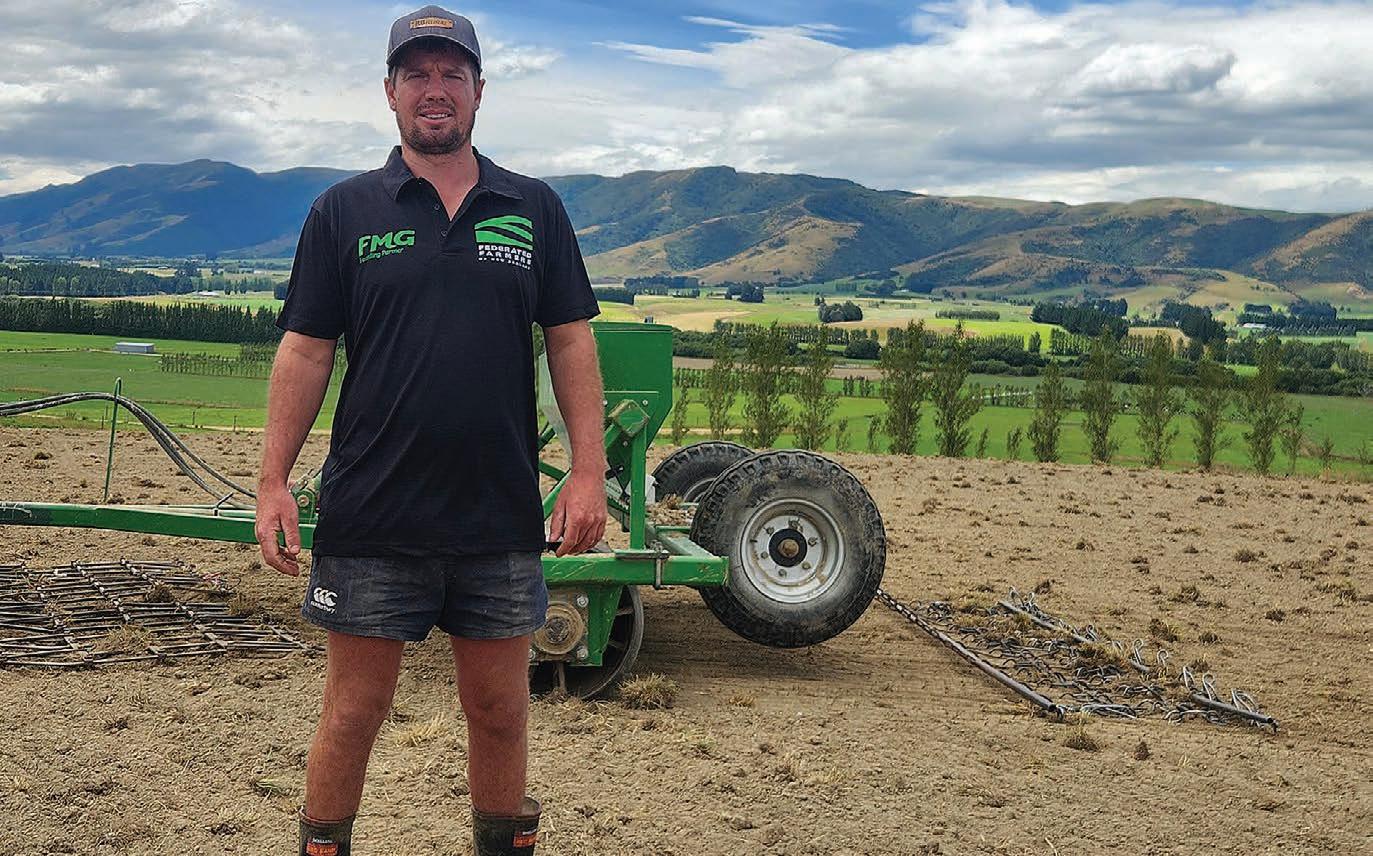
A draft released last year included new fencing requirements for sheep and beef farmers, stock rate limits of 2.5 cows per hectare, and a fertiliser cap of 100kg nitrogen per hectare for dairy farmers in many catchments through Otago.
Most of us don’t make those changes because a rule or regulation told us we had to. We do it because we care about the environment and want to play our part.
Luke Kane Federated Farmers Otago president
The new Government has since signalled an intention to review this strict national direction. In the meantime, it has delayed deadlines for councils to notify new rules by three years.
Kane says it’s obvious that councils around the country, including in Otago, should be stopping work on their land and water plans until they get clarity from the Government.
“If they don’t, they risk causing needless uncertainty and confusion for farmers who are just looking for clear direction so they can make long-term decisions for their businesses.
“It also seems like a real waste of ratepayers’ money to keep working on a new plan that’s going to need to change.
“That money is essentially getting poured down the drain, which is a real shocker at a time when the council is proposing huge rate rises for our community.”
He says ORC’s current framework is completely unworkable, and pushing ahead with rule changes now risks seriously undermining the social and economic fabric of rural Otago.
“The situation at the moment is
getting very messy. Not only is a new national direction due in a few years, but the Government has also signalled it wants to completely repeal and replace the RMA.
“Once the Government has reviewed the freshwater direction and Resource Management framework, we could see Otago needing to start again with this whole process.”
Federated Farmers national board member and environment spokesman Colin Hurst agrees ORC has completely ignored the Government’s direction in choosing to press ahead with notifying its plan in October.
“Cabinet has extended the deadline for councils to implement freshwater plans until the end of 2027, so why on earth would ORC or other councils choose to push on?
“It’s extremely disappointing that ORC is galloping ahead, wasting ratepayers’ money and heightening farmer anxiety, when changes mean
MISREPRESENTED: The perception that Otago farmers aren’t out there already looking after their environment is wrong, Federated Farmers Otago president Luke Kane says.
their plan will have a lifespan of barely two years.”
It’s a poor decision that will result in even more regulation being piled onto Otago farmers in the coming months, Hurst says.
He’s concerned other councils could also look to charge ahead in the same way as Otago.
“The Government has signalled it intends to amend the RMA later this year to, amongst other things, stop new Significant Natural Areas being developed and change the way Te Mana o Te Wai is being applied to resource consent decisions.
“In making these amendments, the Government also needs to consider options for how to draw a halt to councils continuing to implement David Parker’s legacy.
“Federated Farmers will continue to push back strongly on impractical regulations and wasteful spending from councils on behalf of our members.”
26 April 15, 2024 – fedfarm.org.nz Federated Farmers 26
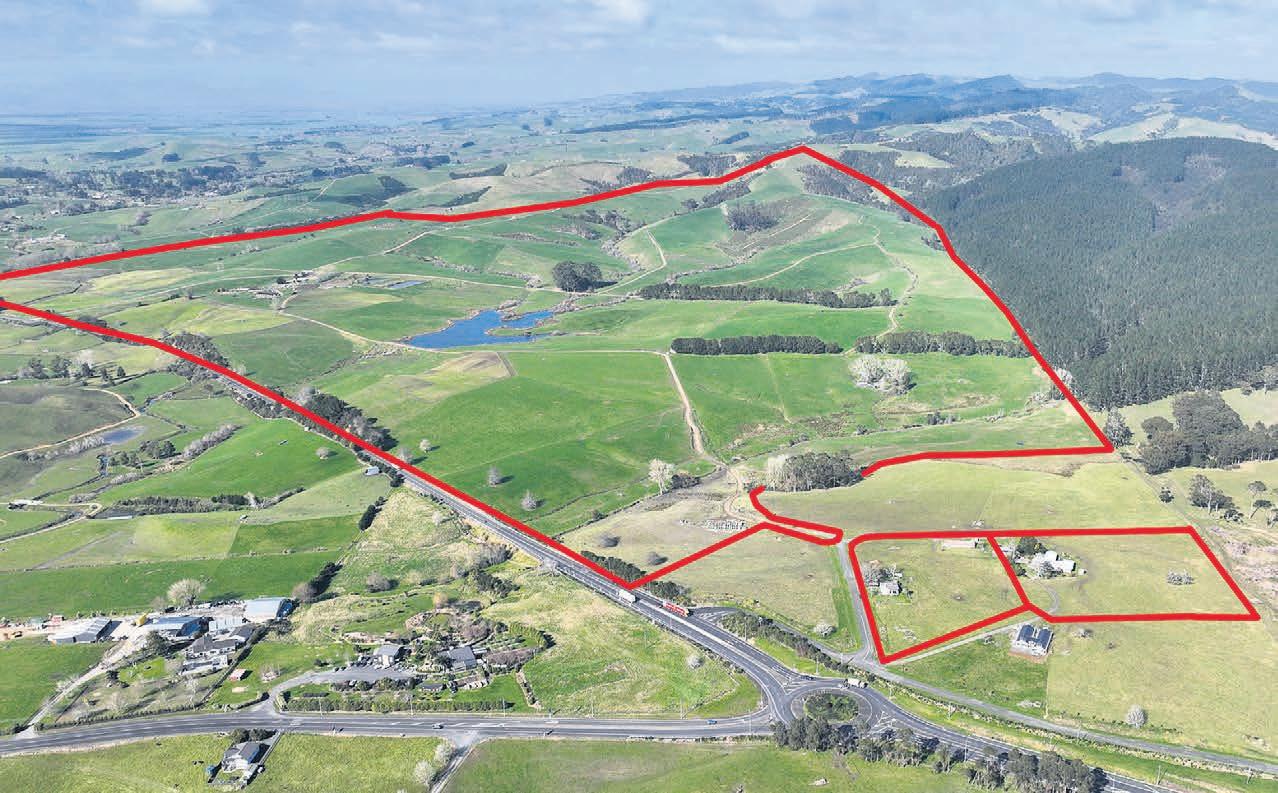
Boundary lines are indicative only
Mangatarata 3544 State Highway 2
Dairy with development for under $24,000/hectare
Calling all dairy, grazing or landbanking buyers! This large-scale 240 -hectare (more or less) dairy farm in Mangatarata is seriously for sale and our motivated vendors want to be off on the 1st of June. This farm comes fully equipped with everything you need for a successful dairy operation, featuring a 40-bail internal rotary cowshed, reliable bore water, and excellent support infrastructure. In the 22/23season, it supplied Fonterra with an impressive 168,825kgMS while milking 520 cows. Beyond its productivity, the property offers an extensive lifestyle component, with mature trees, wetlands, numerous ponds and dams. Accommodation is provided by two homes, each on their own separate title and three bedrooms. With the owners determined to move on after this season, there's no time to waste in securing this exceptional property. bayleys.co.nz/2314755
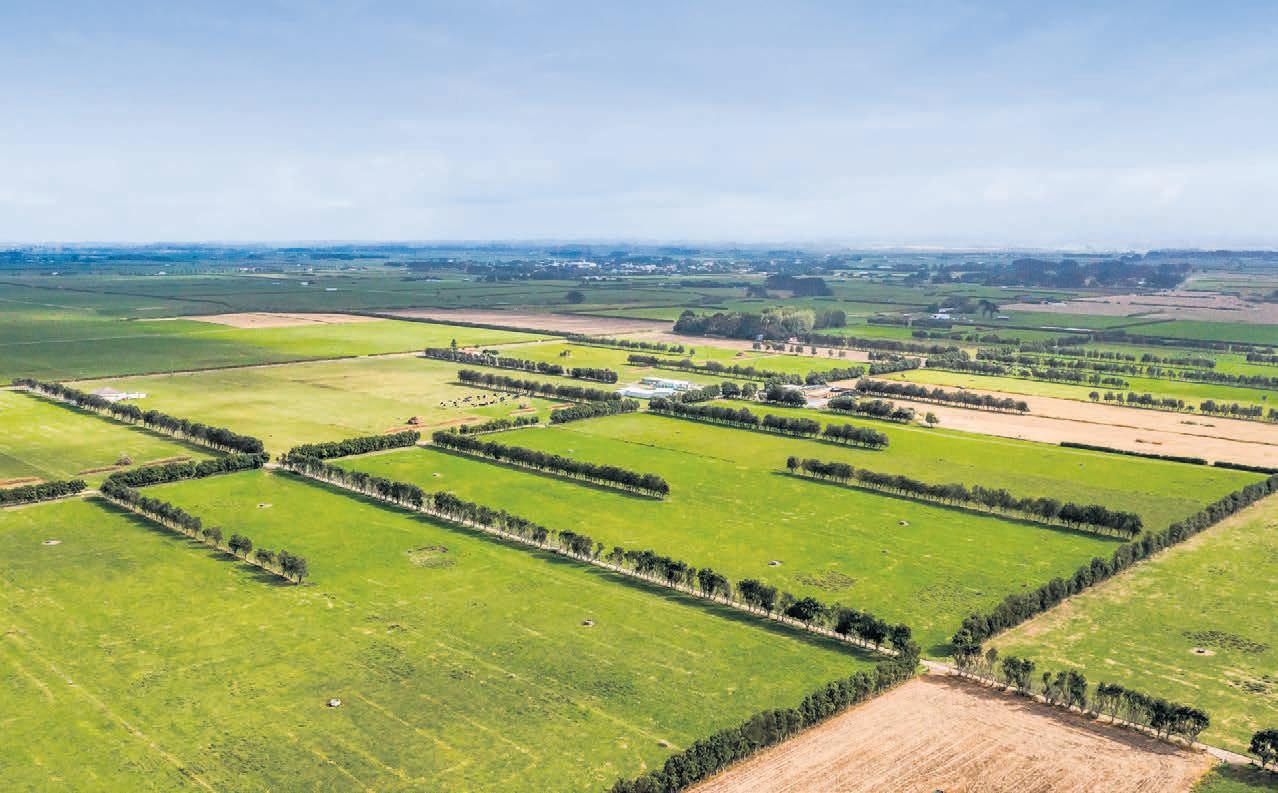
Winks is a proven winner
Located on Winks Road in Manaia, this exceptional dairy farm offers 100 hectares (more or less) of premium flat land in a strong dairy farming area, complete with a 36-aside herringbone cowshed, support sheds, two houses, a massive feedpad, and two maize bunkers. With the potential for high production in the hands of committed farmers, this well-set-up property boasts excellent fencing and is well raced, awaiting a passionate farmer to maximize its potential. Don't miss out on this opportunity to own a meticulously maintained dairy farm—call for further details.
Open day: 11.00 - 11.45am, Thursday 18th April, 2024
bayleys.co.nz/2601797


240 ha
Asking Price $5,650,000 + GST (if any)
View 1-2pm Wed 17 Apr or by appointment
Karl Davis 0508 83 83 83 karl.davis@bayleys.co.nz
Lee Carter 027 696 5781 lee.carter@bayleys.co.nz
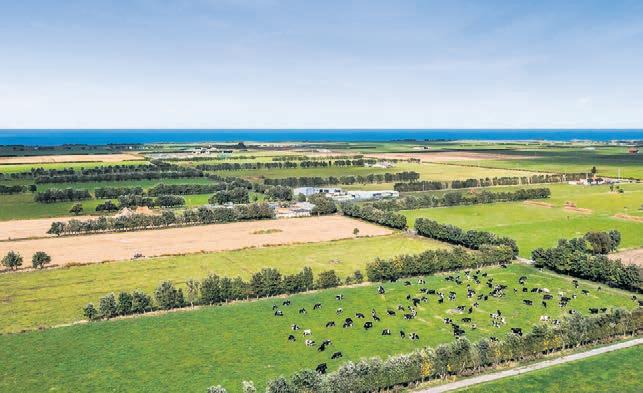
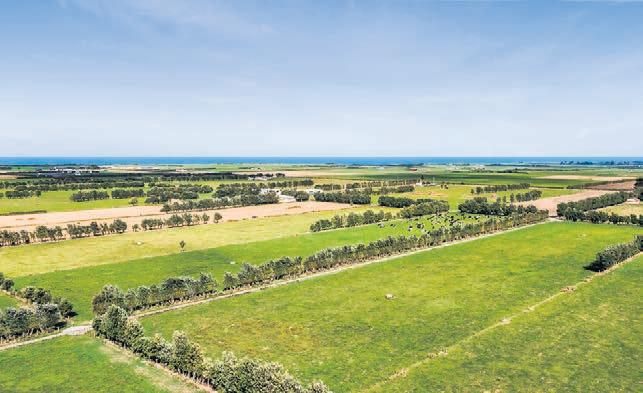
bayleys.co.nz
REALTY LIMITED, BAYLEYS, LICENSED UNDER THE REA ACT 2008
SUCCESS
Manaia 119 Winks Road
2024
SUCCESS
54.5466 ha Tender (will not be sold prior) Closing 1pm, Tue 30 Apr
15 Courtenay Street, New Plymouth Brendan Crowley 027 241 2817 brendan.crowley@bayleys.co.nz
REALTY TARANAKI LTD, BAYLEYS, LICENSED UNDER THE REA ACT 2008
27 Property
207 Rotowai Road, Central Hawke's Bay
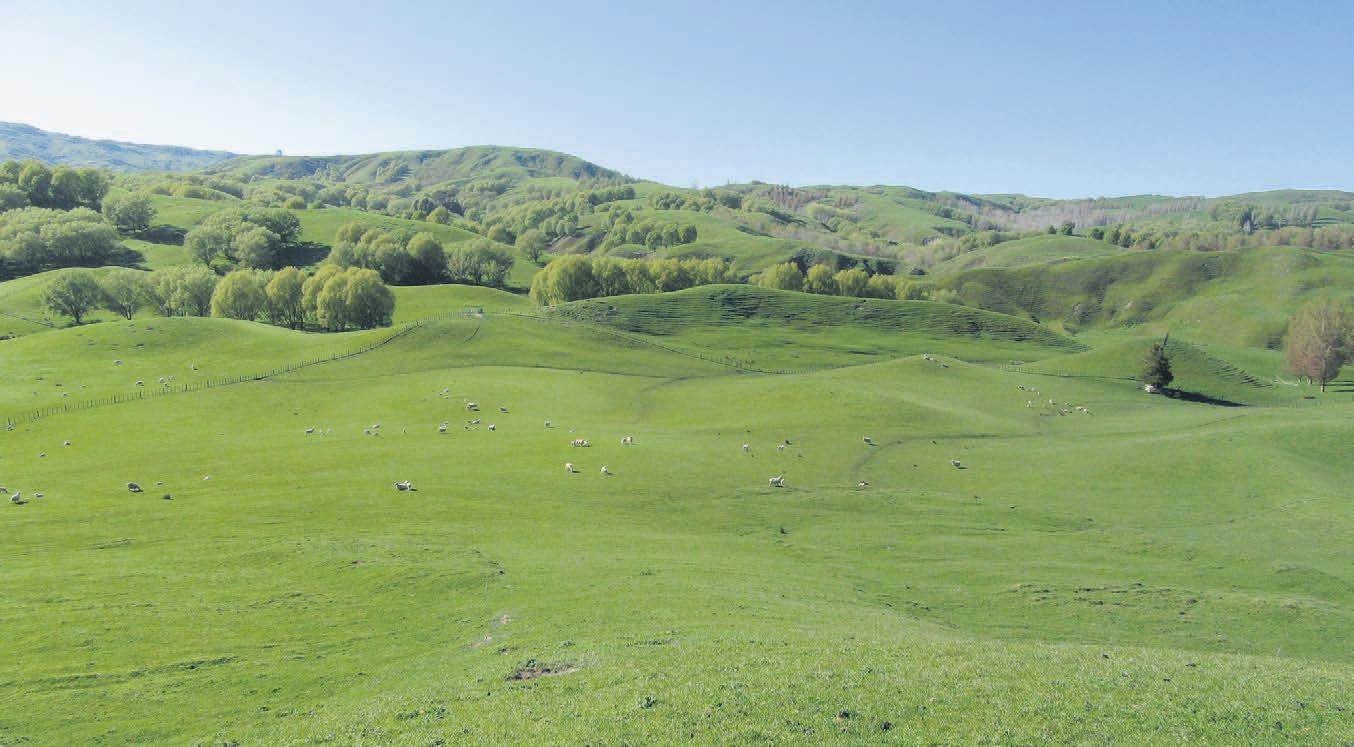
Tainui - 692 ha

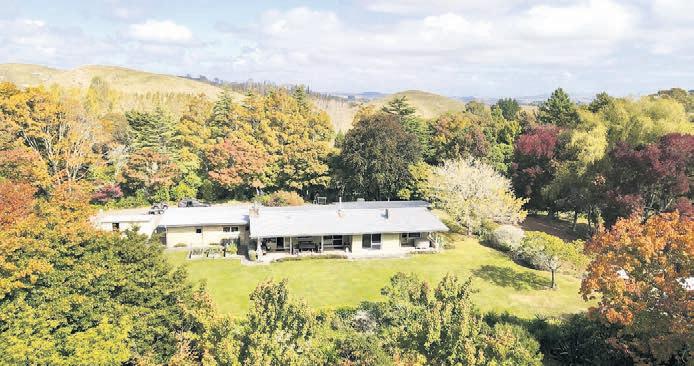
Situated at the end of Rotowai Rd, some 20 km east of Waipawa and 75 km south of Napier. Tainui is secluded and surrounded by farmland. Approx. 590 ha Class 6 land and 100 ha Class 4. A feature of Tainui is the fully reticulated water system to troughs in all paddocks with water sourced from a large dam/wetland area. Fenced into 71 paddocks with 10 km of new fencing completed in 2020-22. Presently utilized as a breeding and finishing block for sheep and cattle with excellent results achieved. Infrastructure is excellent with a four bedroom homestead featuring open plan living, four stand woolshed and covered yard and a full array of other farm improvements. An excellent lane system allows for good stock movement and access. The extensive plantings of Willows and Poplars make for an aesthetically appealing property while providing for a pleasant working environment. Tainui is genuinely on the market as the absentee vendors look to pursue other interests. 4
Tender closes 2.00pm, Fri 17th May, 2024, Property Brokers, 98 Ruataniwha Street, Waipukurau
View By appointment Web pb.co.nz/WR181094







Ashburton 286 Mitcham Road 4 2 3 Deadline Sale (unless sold prior) 12pm, Thu 2 May 2024 View by appointment Ben Turner 027 530 1400 ben.turner@bayleys.co.nz WHALAN AND PARTNERS LTD, BAYLEYS, LICENSED UNDER THE REA ACT 2008 Sought-after lifestyle with irrigation Escape to your own paradise with this meticulously maintained lifestyle property on 20.0050 hectares. The attractive brick home offers 264sqm of living space, high stud ceilings, open-plan areas, and a modern kitchen. Four bedrooms, including two with ensuites, provide ample space for the family. Outside, endless farming opportunities await, with fully irrigated land and shares in the Ashburton Lyndhurst Irrigation Scheme. Subdivided into seven paddocks with deer fencing, the property is well-equipped for stock. Farm buildings include a three-bay shed and a two-bay lockable shed with workshop. Located near Ashburton, schools, and amenities, this property combines rural tranquility with convenience. Don't miss this rare opportunity! bayleys.co.nz/5523785
Tender
2
2
Property Brokers Ltd Licensed REAA 2008 pb.co.nz
sam.mcnair@pb.co.nz
Scan for more Accelerating Success. Agri Realty Limited Colliers Licensed REAA 2008 280 Sowerby Road, Peel Forest, Geraldine For Sale by Deadline Private Treaty closing 4pm on 9 May 2024 (unless sold prior) colliers.co.nz/p-NZL67027217 Richard O’Sullivan 027 292 3921 For Sale Productive Peel Forest land with winter grazing consents Due to our vendors pending retirement, the decision has been made to sell down a productive farming operation of flat to undulating land offered in multiple titles. New winter dairy grazing consents have been issued to enable full use of these highly productive soils. Spring settlement and early access options available. Viewing by appointment only. Total of 542 hectares Productive foothill location Multiple purchase options Winter grazing consents in place 28 Property FARMERS WEEKLY – farmersweekly.co.nz/realestate – April 15, 2024 Real Estate 28
Sam McNair M 027 264 0002 E
Pat Portas M 027 447 0612 E patp@pb.co.nz
FARM LEASE OPPORTUNITY

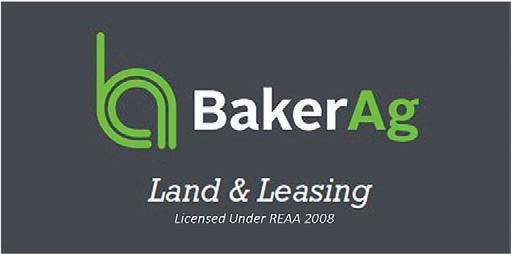
Rangedale Station
1335 Puketoi Rd, Pahiatua
BakerAg Land & Leasing Ltd seek expressions of interest for the lease of Rangedale Station.
The property comprises a total of circa 1576ha of medium to steep hill country situated on Puketoi and Pori Roads, some 40km south east of Pahiatua.
The property has a large character homestead, second dwelling, additional cottage plus two woolsheds, and a full range of farm buildings and other facilities.
The property has been run as a breeding operation with an assessed winter carrying capacity of around 11,500su.
Proposals for leasing of the farm are sought which will include desired lease terms and conditions including lease term.
Farm open days for inspection will be held in April and May 2024 with dates advised to prospective lessees.
The deadline for expressions of interest is 4pm on Friday 16th May 2024
For further information regarding the lease opportunity including property description, draft lease and details of inspection days please contact:
Fergus Rutherford – BakerAg Land & Leasing Ltd 0274 836 293 or fergus@bakerag.co.nz
FARM LEASE OPPORTUNITY


Wairio Station
1309 Kahutara Rd, South Wairarapa
BakerAg Land & Leasing Ltd seek expressions of interest for the lease of Wairio Station.
The property comprises a total of circa 1397ha of alluvial flat to undulating land situated on Kahutara Road, some 20km south west of Martinborough.
The property has a homestead, five other dwellings, woolshed, and a full range of farm buildings and other facilities.
The property has been run as a finishing and cropping operation with cattle and lambs finished each season.
Proposals for leasing of the farm are sought which will include desired lease terms and conditions including lease term.
Farm open days for inspection will be held in April and May 2024 with dates advised to prospective lessees.
For further information regarding the lease opportunity including property description, draft lease and details of inspection days please contact:
Fergus Rutherford – BakerAg Land & Leasing Ltd
0274 836 293 or fergus@bakerag.co.nz
The deadline for expressions of interest is 4pm on Friday 16th May 2024
LK0118299©
LK0118300© 29 FARMERS WEEKLY – farmersweekly.co.nz/realestate – April 15, 2024 Real
29
Estate
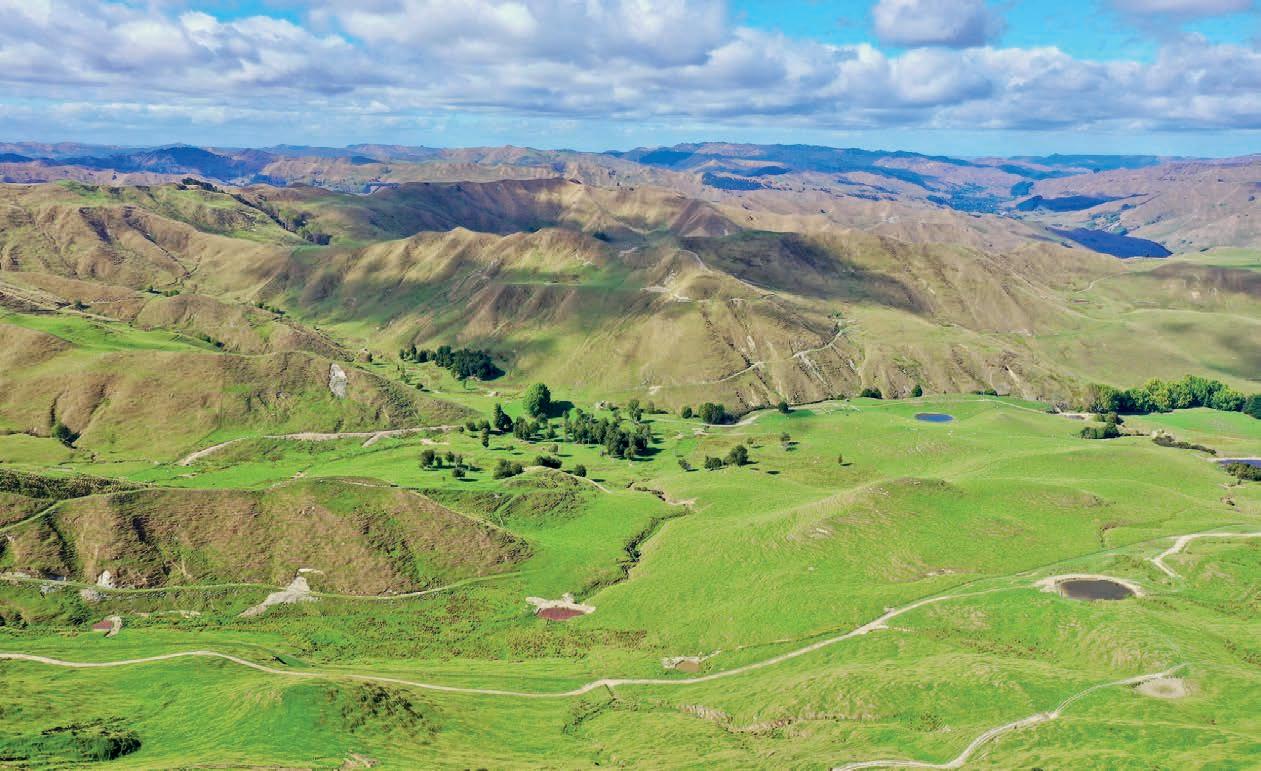
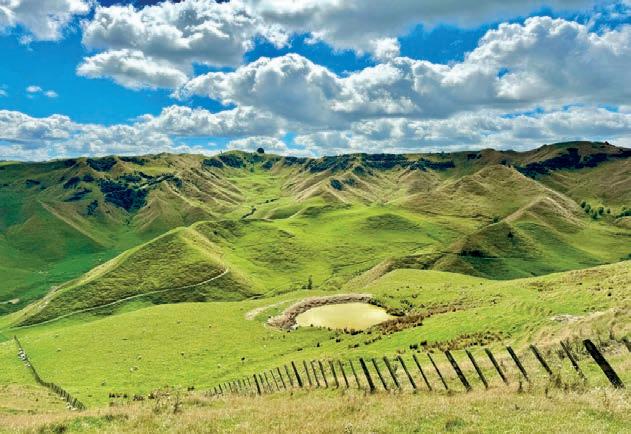

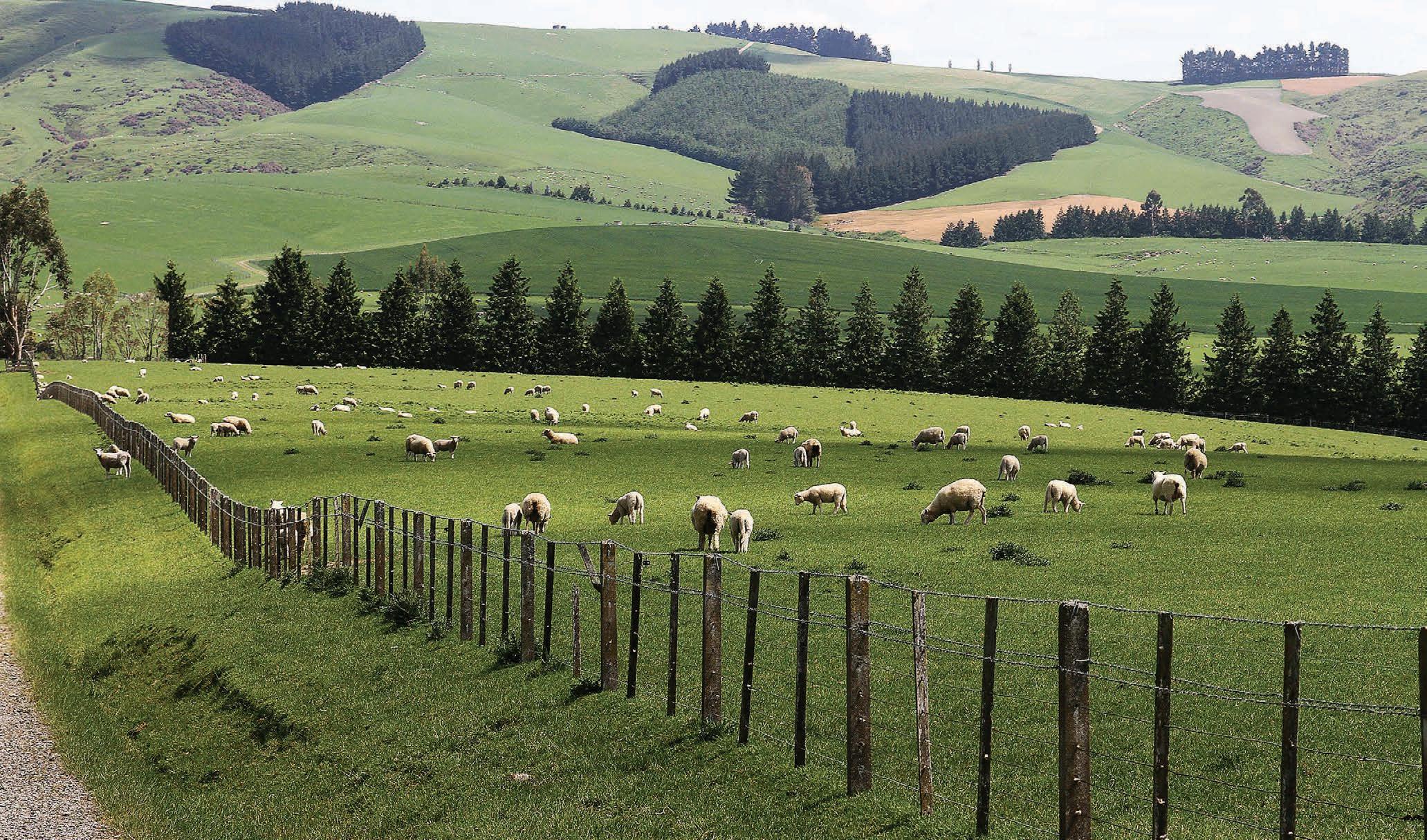
30 FARMERS WEEKLY – farmersweekly.co.nz/realestate – April 15, 2024 Real Estate 30 Advertise with us Reach every farmer in New Zealand every week Call 0800 85 25 80 Email realestate@agrihq.co.nz
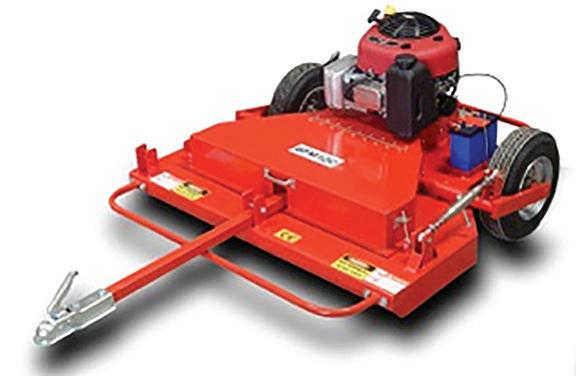
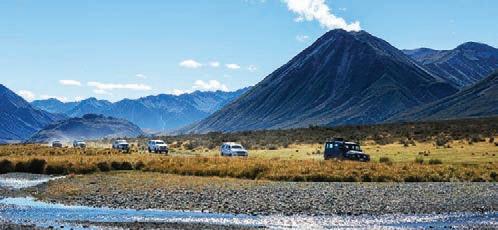


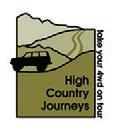






ATTRACTIVE LEASE OPPORTUNITY


CENTRAL NORTH ISLAND


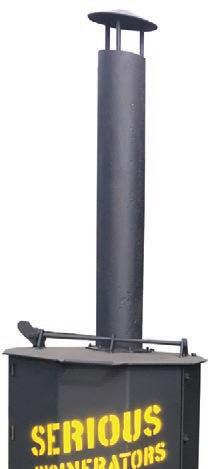
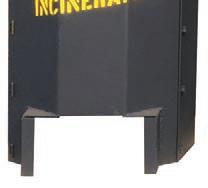





Oraukura Station (Oraukura No 3 Incorporation)
• Approx 998 effective hectares, 10,000+ stock units sheep, cattle and deer
• Flat to easy rolling ash and pumice approx 35km from Taumarunui and Turangi
Well developed with full facilities including two dwellings, 330ha deer fenced, approx 100 paddocks, reticulated water throughout
• 6 years from 1 July 2024 (flexible)
• First Right of Refusal offers potential for longer term relationship with compatible Tenant
• Possibility of 1200ha adjoining property becoming available for lease in 2025
• Joint inspections proposed 1pm Thursday 18 April and Thursday 2 May
We are looking for a passionate stock person that’s self-driven, with a keen eye for detail, to join our large-scale lamb finishing operation. Fairfield Farms is based 10 minutes north of Ashburton.
Job Description
Your role will be to work alongside our Farm Supervisor with a strong focus on efficiently finishing lambs to their full potential. Some seasonal tractor work will also be required outside of lamb season, predominantly around the summer harvest.
Qualifications
The successful candidate will have:
• A passion for everything livestock and a desire to learn and progress
• Attention to detail and take pride in completing tasks to a high standard
• Good stock and animal husbandry skills
• Own 2 – 3 working dogs under good command
Basic computer skills
Additional Information
In Return we can offer:
A challenging but rewarding work environment
Competitive starting remuneration rates depending on experience
• On farm housing available if required Ready to start?
Applicants must be legally entitled to work permanently in New Zealand. If this sounds like the opportunity you have been looking for please apply now via email to info@fairfieldfarms.co.nz and include a cover letter and a copy of your CV or alternatively contact Mike Carter on 027 353 7315 Experienced
Information pack with basic lease terms & conditions, proposal requirements and inspection details available from:
LK0118305©
Geoff Burton Farm Business Management
Taumarunui
Phone 07 895 8052
gtb@xtra.co.nz
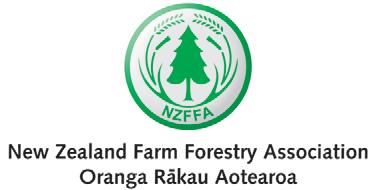
















OFFERING: 140 fully recorded stud

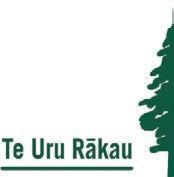


Alternatives to Pine on your farm
Free eld days
Want to grow some trees on your farm, but not pines? Come and see some great examples at free eld days starting in March.
Learn about the bene ts of planting alternative species.
NZ Farm Forestry members will share their experiences of what grows well and where, success and failure, costs and returns. They are showcasing farm forestry in 20 locations across the country.
Hosted by the NZFFA, with support from Te Uru Rākau – NZ Forest Service, the rst 3-hour eld days will be held on:
14 March Balclutha
16 March Greymouth
21 March Gisborne
21 March Whanganui
21 March Waikanae
23 March Bulls
23 March Rangiora
23 March Winton
24 March Taupō
27 March Te Puke
28 March Masterton
5 May Otorohanga
1 June Kerikeri
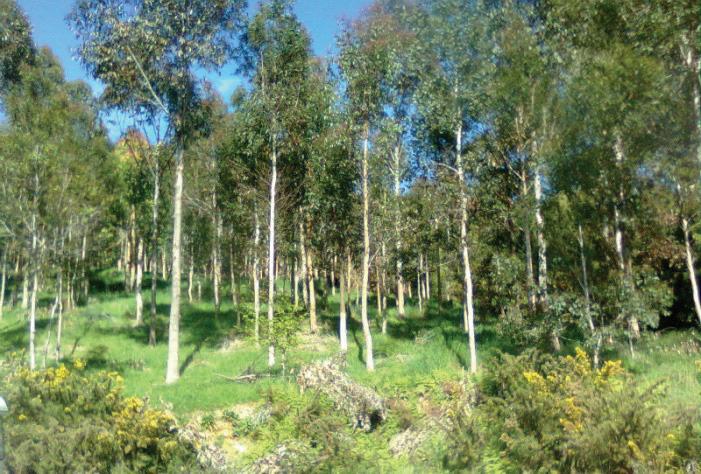
Enrol on the website (https://www.nz a.org.nz/events/) or scan this QR code if you want to attend a eld day in your area, or learn more about them. It will take you to more information and the registration form. Everyone is welcome. Tea and co ee will be provided.

LK0118115©
Stock
farmersweeklyjobs.co.nz To advertise phone Julie 027 705 7181 LK0117420©
High Country Grand Slam Self drive your own 4WD from Blenheim to Cardrona in Central Otago through a network of high country tracks including Molesworth on this 7 day 8 night tour.
The
Explorer Self drive from Lake Ohau to Cardrona through the majestic high country of the Mackenzie Basin, Central Otago and Northern Southland with this 5 day 6 night tour. For further information contact: John Mulholland RD1, RANFURLY Phone 03 444 9703 • Mobile 027 228 8152 lnfo@highcountryjourneys.co.nz www.highcountryjourneys.co.nz LK0118089© HIGH COUNTRY JOURNEYS Drive from station to station and experience the majestic South Island High Country Limited spaces available for 2024 These Tours are; Fully guided with radio contact; Fully catered and stay in very comfortable lodge and farmstays; Made up of smaller tour groups (6-9 vehicles) and travel at a quieter pace. NOW TAKING BOOKINGS FOR 2025 Heavy duty, long lasting incinerators Three sizes available Phone 021 047 9299 irontreeproducts.co.nz LK0118228© To find out more visit www.mowermaster.co Phone 028 461 5112 Email: mowermasterltd@gmail.com Topper / Finishing Mower Genuine 11.5HP Briggs & Stratton Motor. Electric start. Belt driven. Cutting Height 30mm - 300mm LK0118355© $4200 $3900 GST INCLUSIVE MOWER MASTER TOWABLE MOWERS APRIL SPECIAL 31 Marketplace FARMERS WEEKLY – farmersweekly.co.nz – April 15, 2024 Marketplace 31 Before After Phone: 027 430 8209 | email: o ce@surfatex.co.nz | www.surfatex.co.nz Surfatex specialise in ‘Acra ex’ Dairy Wall Coatings, Pit, Milk room and Yard repairs. Industrial coatings including anti-slip solutions and protective ooring. Our skilled team is based in the Manawatu and mobile across the lower North Island. LK0118392©
Person/ General Farm Hand Find primary sector vacancies at:
• South Island
•
Great

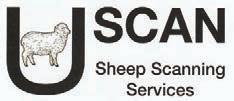

Man: Hello? Woman: Hi honey, it’s me. Are you at the club?
Man: Yes.
Woman: I’m out shopping and found a beautiful leather coat. It’s only $2,000 – is it OK if I buy it?
Man: Sure, go ahead if you like it that much.
2000

• This is your chance to gain some pure breed Angus genetics. Size of mob can be tailored to suit.
• Very quiet temperament, foothill bred, with consistent calf growth rates.
• Calving starts 6th September.

• As owners we will provide sire bulls, transport, a proportion of animal health costs, and share of labour. These girls have become available due to farm sale and change of farming practice. All we are asking is a chance to retain these girls and share the reason they are worth holding on to. This is your opportunity to build some breeding stock or retain fattening cattle as you desire, without any cash outlays.
A suitable tailored agreement to meet the specific needs of both parties can be discussed further, confidentiality assured. If you have a lease possibility, then we would very much like to hear from you.
Available to share farm, graze, or wanting a lease property in the South Island LK0118340©
Any enquiry of interest would be appreciated sooner rather than later.
Please phone/txt Tim 022 077 0040 Email di.tim@farmside.co.nz
STRAIGHT TO AUCTION QUALITY MIXED BREED HERD & REPLACEMENTS
A/c Jaydee Farm Limited – 130 Scotsman Valley Road, Tauwhare, Hamilton – Dairy # 76640
TUESDAY 23rd April @ 10.30 am On Farm
AND LIVESTREAMED ON

AUCTION CONSISTING OF:
262 x mixed breed (Fres, XBred, Jersey plus small numbers Montebelliard, Vik Red & Ayrshire
Herd BW 171 PW 217 99% RA, TB C10 Calving from 15th July 60 DAY CALVING SPREAD (ALL AB)
First 5 weeks NOM Fres, Jersey & small number Norweg. Red
Next 4 weeks, short Gest Jersey (heifers suitable for replacements)
68 x R2 I/C Heifers (CRL) BW 180, PW 208, calving from 14th July to owner bred Jersey Bulls (bulls out 1st Dec)
74 x R1 Heifers (CRL) BW 198, PW 220 (will be sold in 3 x breed splits/ separate profiles available on auction day)
PRODUCTION: Last year 400kgms/cow (all feed grown on dairy platform). SCC average last year 110, 000 current year 114000 Meticulous attention paid to mastitis prevention & treatment, suspect cows culled immediately.
REPLACEMENTS: All managed by our vendors on lease blocks
In calf heifers outstanding for size & type
R1 heifers well grown & healthy
BREEDING HISTORY: LIC history with CRV & Samen used in recent years
AUCTIONEERS NOTE
Never offered for sale in the paddock, this is A MUST
ATTEND Auction for anyone looking to purchase quality stock.
DELIVERY TERMS In-milk cows & In-Calf heifers immediate delivery. 1st June delivery available to purchasers without immediate access to farm
R1 Heifers Immediate delivery
PAYMENT 14 days from auction date
INSPECTION PRIOR TO AUCTION WELCOME, BY APPOINTMENT WITH VENDOR AGENT.
ALL ENQUIRIES TO Stewart Cruickshank Ph 027 2705288

Woman: I also stopped by the Lexus dealership and saw a car I really like and it’s only $90,000.
Man: Wow! OK, but for that price I want it with all the options.
Woman: Great! Oh, and one more thing … I was just talking to Jamie and the house we wanted to buy last year is back on the market … they’re asking $980,000 for it. Remember it was well over a million when we looked at it?
Man: I dunno. Make an o er for $900,000 and they’ll probably take it.
Woman: OK. I’ll see you later! I love you so much!
Man : I love you too.
The man hangs up. The other men in the locker room were staring at him in astonishment. The man turns around and says, “Anyone know whose phone this is?”

for all yarding and handling costs.
Enquiries to Sean Daly 027 332 3462
sda@donaghys.co.nz
Tuesday 23 April | 10.30am Vendors to include - Mt Aspiring Station Limited, Matukituki Station, West Wanaka Station, Alpha Burn Station, JIT Hillend Limited, The Larches and Avalon Station. The sale starts at Mt Aspiring Station and progresses on farm to the various properties concluding at JIT Hillend where the remaining vendors will offer their calves.
Approx:
• 120 Angus & Angus X 2yr Heifers (guaranteed empty)
1000 Angus & Angus X Steer Calves
• 200 Hereford & Angus X Heifer Calves
On farm grazing available by arrangement.
Craig Knight (PGW) 027 590 1331
John

WAITARA STATION ON-FARM LAMB SALE

the country
C/- Lloyd & Sonia Holloway & Family, 348 Brooks Road, Te Pohue
Thursday 18th April 2024
11am viewing 12pm start
Comprising of:
• 2500 Perendale Wether lambs
• 1000 Perendale Ewe lambs
Auctioneers note:
Quality line of late September born hill country lambs. Brickell’s bred (Otoi) selected for growth, structural soundness and survival. All lambs are undrafted, with excellent stock health. Renowned for shifting ability. Lambs have been recently tested and have very low worm resistance. Anti-Biotic free. Data available on request.
HINEURU PROPERTY LTD
C/- Anaru & Winnie Harmer Te Pohue
Comprising of:
• 600 M/S Romdale-Texel x lambs
Auctioneers note: Quality hill country bred lambs born late October. Antibiotic free. FAP Property.
Contact:
Sam Wright PGG Wrightson 027 247 9035


LK0117871©
www.linklivestock.co.nz
grow
LK0115275© Helping
Duffy (PGW) 027 240 3841 UPPER CLUTHA (WANAKA) ON FARM CALF Rural Livestock will offer of behalf of Highlandburn Ltd (at JIT Hillend yards) Approx: • 90 Angus & Angus X Steer Calves • 50 Angus & Angus X Heifer Calves Paul Mavor (RLL) 027 473 0100 Sheep Wanted for Lice Testing Replacement Ewe Hoggets – not in lamb Mobs of >300 On farm study All animals treated for lice This study would be at no cost to you with compensation
LK0118353© FOR SALE
R2YR & MA Red Hinds RW Stag 25/02 –
R3&4YR
Sim Bull
Sim Bull
STOCK REQUIRED
R2YR
or
330
Male
30-32kg Phone
Dyer 0274 333 381 www.dyerlivestock.co.nz A Financing Solution For Your Farm www.rdlfinance.co.nz WE
01/03
Fries Cows VIC
17/01 200 MA Ang Cows VIC
17/01 40 days
250 Pere or Pere X MA Ewes
Fries
Beef Bulls
-400kg
Entire Lambs
Ross
OFFER 100 ANGUS BREEDING COWS of four age groups
32 Mplace/Lstock Marketplace 32 FARMERS WEEKLY – farmersweekly.co.nz – April 15, 2024
DOLOMITE For a delivered price call .... NZ’s finest BioGro certified Mg fertiliser 0800 436 566 ATTENTION FARMERS ZON BIRDSCARER electro-tek@xtra.co.nz Phone: 06 357 2454 ELECTRO-TEK ENGINEERING FLY OR LICE problem? Electrodip – the magic eye sheepjetter since 1989 with unique self adjusting sides. Incredible chemical and time savings with proven e ectiveness. Phone 07 573 8512 www.electrodip.com ANIMAL HANDLING BALAGE FOR SALE ROUND BALES - Baled December 2022. Excellent quality. $90/bale excl GST. Located Maraekako SH50 Hawke’s Bay. Phone 027 4863 906. MARK KIRYAKOS CPEng Geotechnical Engineer, general, earthworks, ponds, buildings, irrigation, tanks, Phone 021 262 2892, mdkiryakos@gmail.com ENGINEERING SERVICES WANTED NATIVE FOREST FOR MILLING also Macrocarpa and Red Gum New Zealand wide. We can arrange permits and plans. Also after milled timber to purchase. NEW ZEALAND NATIVE TIMBER SUPPLIERS (WGTN) LIMITED 027 688 2954 Richard. FORESTRY GOATS WANTED GOATS WANTED. All weights. All breeds. Prompt service. Payment on pick up. My on farm prices will not be beaten. Phone David Hutchings 07 895 8845 or 0274 519 249. Feral goats mustered on a 50/50 share basis. GRAZING AVAILABLE FROM 1st May for around 100 head of cattle. Hawke’s Bay area. Phone 021 0918 7680 for more information. TOP GRAZING AVAILABLE. All at farm, Hauraki Plains West. Experienced in grazing top heifers. Inspection welcome. Phone 027 244 7939. GRAZING AVAILABLE HAY/BALAGE FOR SALE HAY SQUARE AT $75, Rounds at $85 plus GST. Wheat and barley straw available now. BALAGE EXCELLENT QUALITY, $75 per bale plus GST. Unit loads available for hay and balage. Phone 021 455 787. HEIFER GRAZING AVAILABLE 100 R2 HEIFERS. May to May. Options for other classes of stock. Waikite Valley, Rotorua. Phone 021 162 9237. Based King Country, South Waikato Ph 027 775 7621 or email s.turner942@outlook.com NZ KELP. FRESH, wild ocean harvested giant kelp. The world’s richest source of natural iodine. Dried and milled for use in agriculture and horticulture. Growth promotant / stock health food. As seen on Country Calendar. Orders to: 03 322 6115 or info@nzkelp.co.nz HORTICULTURE LEASE LAND WANTED 2000-4000SU SHEEP AND beef lease block. Anywhere in New Zealand considered. Mid 40’s couple, approximately 30 years experience. References available. Phone Karyn 027 246 9668. WILTSHIRES-ARVIDSON. Self shearing sheep. No1 for Facial Eczema. David 027 2771 556. RAMS FOR SALE SHEEP SCANNING AVAILABLE SERVICING SOUTH WAIKATO. King Country, Ruapehu, Taihape areas. Experienced operator. EID and Foetal Ageing. Phone 027 479 4918. STOCK FEED SILAGE BALES for sale. 10 bale equivalent, Otorahanga based. Enquiries please phone 027 471 3856. TRACTORS AND MACHINERY FIAT 55/65 TRACTOR or close to, with 2WD. Older, without shuttle shift. On 28 or 32 inch tyres. Phone Paul 021 20 40 702. HAY FOR SALE. 150 round bales, $90 each, Bombay. Phone 021 027 21269 or 021 830 953. ALONE IS NO FUN! Join our community of people seeking friendship/love! Connect via personal phone calls not a computer. City/ Rural and Outback members of all ages (seniors welcome). Call 0800 315 311 to make contact today! www. newbeginningsnetwork. co.nz 30+ years experience in helping genuine people nd love! PERSONAL WORD ONLY ADVERTISING. Phone 0800 85 25 80. Advertise with us Call 0800 85 25 80 wordads@agrihq.co.nz SALE TALK A man in the locker room of an upscale gym in NYC answers a cell phone and puts it on speaker while he dresses.
Livestock
Livestock
FERDON GENETICS 75TH YEARS CELEBRATION SALE
Monday 22 April | 12.30pm
On Farm: 333 Ouruwhero Road, RD4, Otorohanga
A/C Ferdon Genetics, Ferguson Family
Comprising of 75 Elite Lots:
55 Jersey Incalf Cows, Incalf Heifers and R1yr Heifers
• 16 Holstein Friesian Incalf Cows, Incalf Heifers and R1yr Heifers
• 4 Ayrshire Incalf Cows, Incalf Heifers and R1yr Heifers
Outstanding Conformation, Top Production, and Reproduction.
International genetics of all breeds, Show championship winners of all breeds.
Sale vendors also includes Waipiri Holsteins (Fullerton Family), Okawa Holsteins (Rob & Brett Barclay), Jerome & Holly Ferguson and Andrew Ferguson.
Catalogues available on www.agonline.co.nz and all other breed societies and BIDR.
Online Bidding available via BIDR. To register please visit www.bidr.co.nz
Andrew Reyland 027 223 7092
Brian Robinson (BRL) 027 241 0051
CAPTIAL STOCK IN CALF ANGUS COW
Tuesday 23 April
Commencing 1pm
Dispersal sale on account of
PG & NA Gallagher
343 Ashwick Flat Road, RD 17, Fairlie For sale due to lease of property.
Comprising:
• 130 R2 year Angus Heifers PTIC to Twin Oaks Bulls 3/11/23 (3 Paratrooper Sons)
• 70 R3 year In Calf Angus Heifers
80 R4 & R5 year In Calf Angus Cows
• 170 Mixed Age In Calf Angus Cows
• All cows PTIC to Twin Oaks Angus Bulls
• 12 Mixed Age Twin Oaks Angus Bulls (2yr to 6yr)
Auctioneers note:
These are all well bred cows and genetically proven with heifers scanned (Via scanned) for their EMA and IMF. Full details and figures available for all sires that went to each mob. All calves wean consistently 290-300kgs.
Sale will be conducted Purchase Price plus 15% GST.
Cash or EFTPOS on day of sale unless you have a PGG Wrightson account.
Signposted from Mt Michael, Fairlie.
Enquiries:
Paul & Ngaire Gallagher (Vendor) 027 685 4809
Cameron Gray (PGW) 027 494 0572
NZ’s Virtual Saleyard bidr.co.nz
QUALITY FRIESIAN/FRIESIAN X REDUCTION SALE
Wednesday 24 April 11.00am | Morrinsville Saleyards
A/C Tanglewood Farms, M & N Hawkings, Matamata
56 Friesian & Friesian X MA Incalf Cows, BW 338, PW 350, RA 100%
This is a great opportunity to buy from one of the top herds in the country due to the loss of a lease block.
Murray has sold what he considers the bottom 30% of his herd annually for the last 20 years and these have performed wherever they gone.
The herd is milked on a challenging farm above Matamata and this season supplied 5 bulls to LIC.
- Calving from the 11/7/24 (all AI)
- Herd G3 Profiled
- Currently OAD
- Deferred payment 20th June 2024
Outside buyers cows can go home after the sale at purchase’s expense, if prearranged with agents.
Catalogues available on Agonline:
Dean Cook 027 243 1429
Andrew Reyland 027 223 7092
Murray Hawkings (Vendor) 027 220 1376
NZ’s Virtual Saleyard bidr.co.nz
A/C Finner Farms
• 50 Friesian & Friesian X MA Incalf Cows, BW 294, PW 275, RA 96%
- G3 Profiled
- Production 480MS/cow, 1500 MS/Ha
- Calving from 8/7/24
STRONG SOUTH WAIKATO FRIESIAN/FRIESAN X HERD AUCTION
Tuesday 23 April | 11.30am
Morrinsville Saleyards
A/C Syberg Co Ltd.
Comprising:
• 175 Friesian / Friesian X Incalf Inmilk Cows, BW 255, PW 303, RA 100% BW up to 413, PW up to 649
Excellent age structure, with 47 years of breeding.
These hard-working cows are milked on hard contour on a system 2-3.
Historically doing 400 – 420MS per cow on System 2/3, Average SCC 145,000.
These cows have potential to shift well.
Calving 24 July - 15 September. 3 ½ weeks of AI to LIC Friesian, then tailed with Black white face and Hereford bulls and finished with short gestation AI dairy Bull.
TB Status C10, BVD Negative, EBL Free, Rotovirus Vacc, Herringbone Shed
Enquiries:
Alex Stuart 027 494 2544
NZ’s Virtual Saleyard bidr.co.nz
MASTERTON COW FAIR
Wednesday 24 April | 11.30am
Masterton Saleyards
Total yarding: 800 Cows
Glenburn
• 55 R3 Angus Heifers VIC Angus Bull 22/11
35 R3 Angus Heifers VIC Angus Bull 22/10
McFadzean Cattle Company
• 50 M/A Angus Cows VIC Meat Maker Bull 20/11
Little Tora - Capital Stock Coastal Cows, property sold.
• 130 M/A Ang, Ang/Here & Here Cows.
VIC Angus & Hereford Bull 15/11
Tarewa - Capital Stock, property sold.
150 M/A Hereford & Angus X Cows. VIC
Hereford & Angus Bull 10/11
• 40 R3 Angus/Angus X Heifers VIC Angus Bull 01/11
Herrick Land Co
• 30 R4 Angus Heifers VIC Angus Bull
White Rock Station
40 M/A Angus Cows VIC Angus Bull
Further enquiries:
Andrew Jennings 027 594 6820
Brian Diamond 027 238 9600
Wayne Stewart 027 438 4963
www.mastertonsaleyards.com
NZ’s Virtual Saleyard bidr.co.nz
The herd originates from the above advertised herd at Tanglewood - Matamata
Because of a very high in calf rate and a big number of heifers entering the herd this year these cows are up for sale.
Cows can go home after the sale at the purchaser’s expense, please arrange with agents before the sale.
Catalogues available on Agonline.
Dean Cook 027 243 1429
Andrew Reyland 027 223 7092
FEILDING WEANER FAIR - SUE BROTHERS
Wednesday 17 April - 11.30am | Feilding Saleyard Complex
We will be offering on: A/C Sue Brothers, Ohakune
Approx:
450 Wnr Steers TBD
450 Wnr Heifers TBD
Enquiries to:
Gareth Williams 0275 264 613
Monday 29 April | 10.00am Machinery | 11.00am Livestock On Farm – 747 Puketarata Road, Otorohanga Dairy # - 74376
A/C Grant & Karen Brierley
Comprising:
• 250 Friesian/Friesian X Incalf Cows, BW 245, PW 272 RA 100% (Inc 10 Incalf Carryover Cows)
• 11 Friesian/Friesian X Inmilk MT Cows, BW 208, PW 234
81 Friesian/Friesian X R2yr Incalf Heifers, BW 303, PW 310
• 58 Friesian/Friesian X R1yr Heifers, BW 314, PW 304
Our vendors have instructed us to offer at auction, their outstanding Friesian/Friesian X herd, Carryovers, and all heifer replacements. They have not been offered for sale in the paddock.
BW’s up to 435, PW up to 926.
Grant & Karen have used nominated semen for the last 10 years focusing on type, udders, and production. This herd consistently produces 450
MS/Cow and 1240 MS/HA on a system 3. Calving from 15 July to 20 September using 100% AI Friesian, and some Hereford and Short Gestation. Cows scanned to dates.
Ave SCC 140,000, TB Status C10, BVD Negative, EBL Free, Herringbone shed.
Incalf Heifers very well grown and are calving from 15 July to Jersey bulls, Bulls out 15 December.
R1yr Heifers are extremely well grown and outstanding for size.
If you want a commercial cow with the quality of a pedigree, then this sale is not to be missed.
Machinery | 10.00am.
Visit www.agonline.co.nz/upcomingsales for full machinery details.
Freephone 0800 10 22 76 | www.pggwrightson.co.nz Helping grow the country
Key: Dairy Cattle Sheep Other
AI Friesian &
Tailed
Angus
- Cows scanned to dates
Deferred
2024
to
Xbred,
with
Bulls
-
payment 20th June
These cows are very smart on the eye and come forward in great condition.
For more information contact: Shay Egan 027 473 5856 Andrew Reyland 027 223 7092 OUTSTANDING FRIESIAN/FRIESAN X COMPLETE DISPERSAL AUCTION NZ’s Virtual Saleyard bidr.co.nz
Livestock
WEEKLY – farmersweekly.co.nz – April 15, 2024
33
FARMERS
33
Markets
Promising dynamics shift US beef market
Low cold storage stocks and sliding slaughter rates leave beef production exposed after years of drought-induced herd liquidation.

Mel Croad MARKETS
Exports
THE United States beef market is delivering some interesting dynamics that we haven’t seen for several years. After a few false starts, beef production is finally feeling the impact of years of droughtinduced herd liquidation.
Not only are cattle slaughter and therefore production volumes sliding, but US stocks of beef in cold storage – usually a useful backup – are the lowest they have been in years.
For those in the game long enough, the current dynamics playing out in the US beef market should spark some optimism. Not since 2014 have we seen a combination of these factors driving the market.
US beef production is on a slippery slide and there is no immediate fix. Admittedly, external volatility has shaped the global markets in recent years, making it somewhat challenging to align current fundamentals with previous years.
But there is no reason New Zealand beef producers shouldn’t
benefit from this firming demand period.
AgriHQ’s latest outlook points to pricing upside in the months ahead for beef, based on these fundamentals. But as we have seen with any pricing lift, it’s not always about how long they last, it’s about being prepared for when they happen so the benefits can be enjoyed for longer. And that means early on-farm decisions are key.
In 2014, US beef production was heading to a 20-year low amid favourable feed conditions that were the catalyst for herd rebuilding. The gap in US production made way for higher supplies from overseas, while still supporting a strong run-up of both domestic and imported beef prices.
This occurred even though consumers were beginning to find beef pricey. In 2014 and 2015 Australia shipped record volumes of beef into the US, lifting to either side of 400,000 tonnes. NZ also managed to ship 230,000t in the 2014-15 season, far above anything shipped there in recent years.
This year, the sudden fall in US cow slaughter and production rates has resulted in a remarkable
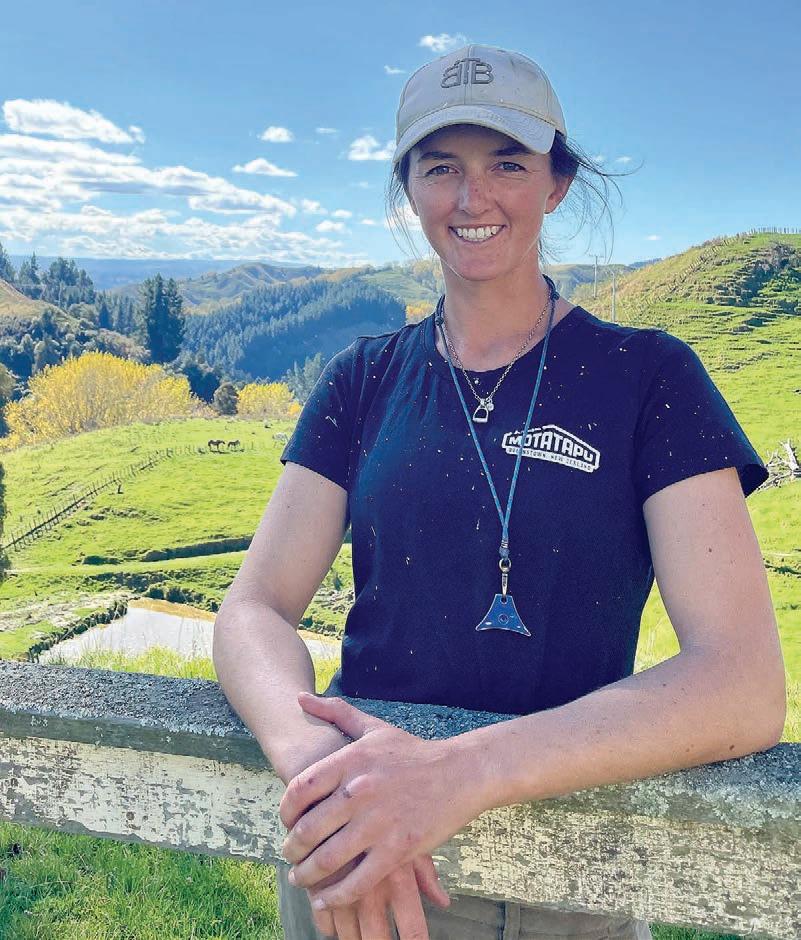
Proudly sponsored by

A further demand boost leading into peak grilling season in the US should ensure a good run to spring, price-wise.
lift in US domestic 90CL cow prices, surging by US90c/lb since January. Typically, the upside is more like 16c/lb.
US imported beef prices have lifted by US 42-48c/lb since January, which is similar to this time last year. Farmgate bull prices are currently the same as a year ago.
The fast-paced changes in US beef production have caught some
US end users on the hop. The need to secure supplies of beef has pushed prices higher. A further demand boost leading into peak grilling season in the US should ensure a good run to spring, price-wise.
A year ago, the market was driven higher by the expectation that US lean beef supplies would topple over. That didn’t eventuate to the extent expected and demand failed to fire – a hangover of the economic implications of covid.
This resulted in an early peak in US demand and a subsequent drop in imported beef prices and farmgate returns here. This year those factors appear to have changed. US domestic cow
supplies are indeed tanking and will continue throughout 2024. There will be no last-ditch surge in US beef production, rather a greater reliance on imported beef to fill the gaps.
US economic data suggests a settled outlook with the possibility of some subtle growth, which should lead to improved consumer confidence. There are always risks involved when prices lift so quickly and as we have seen in recent years demand is very quick to react to outside influences.
This raised awareness does bring a level of caution in creating an overheated market but there is little to indicate the market has reached that point yet.
“ I read Farmers Weekly every week. The day it gets delivered it’s customary for us to check the mailbox and we read it during smoko. It’s how I get 90% of my intel on the sector.”
Heather Gee-Taylor
Apiti sheep and beef farmer and Federated Farmers meat and wool chair – Manawatu/Rangitikei
LK0118206© 34 Markets
OPTIMISM: For those in the game long enough, the current dynamics playing out in the US beef market should spark some optimism, says Mel Croad.
Markets
Weekly saleyards
It has been another jam-packed week of sales across the country. Autumn is progressing and the Taranaki cattle fair offered close to 1000-head. The bulk were R2 steers and dairy-beef had a steady result at $3.13/kg on average. Dairy-beef heifers had a tougher time and eased to $2.77/kg. Down south, the dry conditions continue to hamper the atmosphere at calf sales. Temuka’s Western Section resulted in several unit-loads heading to the Waikato while most others stayed local. Traditional steers averaged 200kg, $715 per head and $3.58/kg. Traditional heifer calves were 20kg lighter and $535 per head on average.
35
Wellsford | April 8 | 589 cattle $/kg or $/hd R2 Angus-Friesian steers, 416-430kg 3.20-3.25 R2 Hereford-Friesian steers, 430-443kg 3.18-3.28 R2 Hereford-dairy steers, 377-463kg 2.85-2.96 R2 Friesian heifers, 336-385kg 2.05-2.10 Weaner dairy-beef heifers, 146-215kg 435-640 Pukekohe | April 6 $/kg or $/hd R2 steers 2.85-3.10 R2 heifers 2.77-2.90 Weaner steers 655-945 Weaner heifers 450-970 Prime steers 2.87-2.92 Prime heifers 2.74-2.80 Tuakau | April 4 | 390 cattle $/kg or $/hd R2 dairy-beef steers, 450-510kg 3.00-3.17 R2 dairy-beef heifers, 360-410kg 2.90-3.12 Weaner dairy-beef steers, 250-340kg 3.43-3.63 Weaner dairy-beef heifers, 250-310kg 3.25-3.38 Tuakau | April 9 | 560 sheep $/kg or $/hd Store lambs, all 60-84 Prime ewes, all 50-70 Prime lambs, all 115-131 Tuakau | April 10 | 480 cattle $/kg or $/hd Prime beef cows, 600-700kg 2.14-2.29 Prime steers, 550-700kg 2.89-3.00 Prime heifers, 460-550kg 2.70-2.90 Boner cows, 500-650kg 1.80-2.14 Rangiuru | April 9 | 340 cattle, 291 sheep $/kg or $/hd R2 dairy-beef steers, 405-450kg 2.80-2.94 R2 traditional steers, 415-431kg 3.11-3.28 Prime beef, dairy-beef steers, 606-660kg 2.95-3.02 Boner Friesian, Friesian-cross cows, 430-560kg 1.79-1.98 Store lambs, all 62-75.50 Frankton | April 9 | 810 cattle $/kg or $/hd R2 Angus steers, 341-362kg 3.55-3.75 R2 Hereford-Friesian steers, 365-445kg 2.93-3.19 R2 beef, beef-cross bulls, 360-445kg 2.81-3.03 R2 dairy-beef heifers, 361-399kg 2.81-3.03 Weaner Angus, Hereford-Friesian steers, 176-183kg 680-710 Weaner Angus heifers, 200-219kg 580-720 Prime dairy-beef heifers, 460-537kg 2.84-2.92 Boner Friesian, Friesian-cross cows, 426-496kg 1.67-1.90 Frankton | April 10 | 293 cattle $/kg or $/hd R2 beef, dairy-beef steers, 380-492kg 2.95-3.21 R2 beef-cross heifers, 401-433kg 2.77-2.81 Weaner Hereford-dairy steers, 122-172kg 580-690 Weaner Hereford-Friesian, Angus-cross steers, 260-264kg 890-920 Prime Hereford-Friesian steers, 568-625kg 2.96-2.98 Prime dairy-beef heifers, 486-528kg 2.92-2.98 Te Kuiti | April 5 | 499 cattle $/kg or $/hd Mixed-age Angus, dairy-beef cows, 510-650kg 1.94-2.08 R2 traditional steers, 320-498kg 3.11-3.26 R2 dairy-beef steers, 371-428kg 2.82-2.95 R2 Angus heifers, 323-445kg 2.80-2.95 R2 Hereford-Friesian heifers, 323-453kg 2.79-2.88 Weaner dairy-beef heifers, 150-277kg 510-800 Matawhero | April 5 | 2095 sheep $/kg or $/hd Store male lambs, medium to good 64-81 Store ewe lambs, medium to good 51-76.50 Store mixed-sex lambs, good 56-85 Prime lambs, heavy 100-115 Taupo | April 8 | 233 cattle $/kg or $/hd R2 heifers, 336-472kg 860-1230 Boner Friesian, Friesian-cross cows, 408-566kg 1.66-1.81 Taranaki | April 10 | 938 cattle $/kg or $/hd R3 Hereford-Friesian steers, 563-583kg 3.02-3.10 R2 Angus steers, 393-412kg 2.80-2.86 R2 Hereford-Friesian steers, 381-427kg 3.20-3.29 R2 Hereford-Friesian heifers, 388-441kg 2.73-1.86 Weaner dairy-beef steers, 170-224kg 750-840 Weaner dairy-beef heifers, 128-190kg 480-565 Stortford Lodge | April 8 | 1436 sheep $/kg or $/hd Prime ewes, very good 79-82 Prime ewes, medium to good 55-70 Prime lambs, very heavy 140 Prime lambs, good to heavy 125-137 Stortford Lodge | April 10 | 311 cattle, 3697 sheep $/kg or $/hd Mixed-age Angus, South Devon cows, 570-661kg 2.13-2.15 R3 traditional steers, 515-538kg 3.16-3.28 R2 Angus steers, 353-397kg 3.02-3.07 Weaner South Devon steers & heifers, 260-265kg 790-920 Weaner Angus heifers, 151-192kg 490-560 Store male, ewe lambs, heavy 86-102 Store male lambs, medium to good 68-83 Store ewe lambs, medium to good 60.50-80 Dannevirke | April 4 | 1282 sheep $/kg or $/hd Store male lambs 64-113 Store ewe lambs 47-59 Prime ewes, all 35-65 Prime lambs, all 90-133 FARMERS WEEKLY – farmersweekly.co.nz – April 15, 2024
35
36 FARMERS WEEKLY – farmersweekly.co.nz – April 15, 2024 Markets 36 Feilding | April 5 | 1140 cattle, 6860 sheep $/kg or $/hd R3 traditional steers, 563-675kg 3.11-3.27 R2 traditional steers, 452-516kg 3.12-3.21 R2 Hereford-Friesian steers, 347-418kg 3.15-3.30 R2 Hereford-Friesian, Angus-Friesian steers, 373-485kg 2.95-3.06 R2 traditional, Hereford-Friesian heifers, 352-516kg 2.75-2.89 Store cryptorchid lambs, good to heavy 78-113 Store cryptorchid lambs, small to medium 55-77 Store ewe lambs, good to heavy 73-89 Store ewe lambs, small to medium 41-65 Feilding | April 8 | 222 cattle, 2273 sheep $/kg or $/hd Prime dairy-beef cows, 552-642kg 1.81-1.84 Boner dairy cows, 425-615kg 1.57-1.66 Prime cryptorchid, mixed-sex lambs, heavy to very heavy 121-147 Prime mixed-sex lambs, medium 81-115 Prime ewes, heavy 77-87 Prime ewes, medium to good 50-65 Coalgate | April 4 | 442 cattle, 3715 sheep $/kg or $/hd Mixed-age Wagyu cows, RW Wagyu, 454-558kg 600-850 R2 dairy-beef steers, 402-445kg 2.31-2.60 Prime beef, dairy-beef steers, 490-673kg 2.61-2.88 Store lambs, shorn, good 76-85 Store lambs, woolly, medium 54-68 Prime lambs, very good to heavy 127-145 Canterbury Park | April 9 | 374 cattle, 2897 sheep $/kg or $/hd R2 Hereford-Friesian steers, 373-428kg 2.50-2.57 Prime beef steers, 600-745kg 2.70-2.88 Prime dairy-beef heifers, 505-640kg 2.51-2.66 Store lambs, good 78-91 Store lambs, medium 40-80 Prime ewes, good 69-75 Prime lambs, heavy 127-135 Temuka | April 8 | 1325 cattle, 4437 sheep $/kg or $/hd Prime Angus cows, 478-749kg 1.61-1.69 Prime Hereford-Friesian steers, 505-650kg 2.68-2.86 Prime Hereford heifers, 422-479kg 2.44-2.60 Boner Friesian, Friesian-cross cows, 423-620kg 1.29-1.46 Store male lambs, heavy 120-131 Store mixed-sex lambs, good-heavy 74-91 Prime ewes, most 50-70 Prime mixed-sex lambs, most 115-135 Balclutha | April 10 | 1243 sheep $/kg or $/hd Store lambs, all 40-89 Prime ewes, all 40-91 Prime lambs, all 105-151 Charlton | April 4 | 516 sheep $/kg or $/hd Store lambs, all 58-65 Prime ewes, all 40-77 Prime lambs, all 95-130 Lorneville | April 9 $/kg or $/hd Boner dairy heifers, 330-380kg 1.60-1.90 Store lambs, all 20-90 Prime ewes, all 10-80 Prime lambs, all 88-134 Beef Weaner Fairs | April 4 - April 10 Feilding | April 4 | 3228 cattle $/kg or $/hd Weaner Angus steers, 257-280kg 1010-1090 Weaner Angus & Angus-Hereford steers, 206-262kg 820-1010 Weaner exotic steers, 256-276kg 1020-1200 Weaner Angus heifers, 195-217kg 590-685 Weaner Simmental-beef heifers, 306-339kg 940-1010 Masterton/Martinborough | April 9 | 1800 cattle $/kg or $/hd Weaner Angus, Angus-Hereford steers, good 900-1050 Weaner Angus, Angus-Hereford steers, small to medium 500-900 Weaner Hereford steers, medium to good 800-960 SHEEP & BEEF REPORT Subscribe from only $100* per month agrihq.co.nz/our-industry-reports Track supply demand& Every month, receive in-depth analysis of key trade data, important nancial markets, and critical market trends here and around the world. * Prices are GST exclusive

















LONG LIVE THE KING KING T&Cs: Offer is available on new Suzuki KingQuad financed between 1/2/24 and 30/4/24 at participating Suzuki dealers. Finance offer is based on no deposit, 5.99% p.a. interest rate, and is fixed for 36 months. A PPSR fee of $10.35, a monthly maintenance fee of $2, a UDC loan fee of $130 and a dealer origination fee of $250 will apply. The loan is provided by UDC Finance Limited. UDC’s lending criteria and standard terms and conditions apply. Offer not available in conjunction with any other promotion, while stock lasts. TRACTA23091_CF We get it, forking out for a new 4x4 right now is a royal pain in the … well, you know! So you want to know it’ll see you right for the next few years without costing you more. With prices from just $13,522 + GST, its 3-year Factory Warranty and this awesome finance offer, the cost of owning a Suzuki KingQuad has never been better. So get yourself down to your local Suzuki dealer today or visit suzuki.co.nz PLUS NO DEPOSIT 36 MONTHS TO PAY CLASS-LEADING 3 YEAR FACTORY WARRANTY 37 FARMERS WEEKLY – farmersweekly.co.nz – April 15, 2024 Markets 37 Masterton/Martinborough | April 10 | 800 cattle $/kg or $/hd Weaner Angus, Angus-Hereford heifers, good 700-805 Weaner Angus, Angus-Hereford heifers, small to medium 400-680 Weaner Hereford heifers, good 700-825 Weaner Meatmaker heifers, good 800-825 Blenheim | April 10 | 1764 cattle $/kg or $/hd Weaner Angus steers, 212-267kg 800-995 Weaner Angus steers, 141-211kg 520-780 Weaner Hereford steers, 163-270kg 590-890 Weaner Angus-Hereford steers, 157-278kg 560-1000 Weaner Angus, Angus-Hereford heifers, 126-259kg 320-640 Cheviot | April 5 | 1150 cattle $/kg or $/hd Weaner traditional steers, 213-287kg 780-1100 Weaner traditional steers, 152-208kg 550-760 Weaner traditional heifers, 140-260kg 400-760 Canterbury Park | April 4 | 1671 cattle $/kg or $/hd Weaner Angus steers, 233-265kg 900-970 Weaner Simmental-beef steers, 355-391kg 1000-1080 Weaner Angus heifers, 218-268kg 650-790 Weaner Angus-Hereford heifers, 218-233kg 590-720 Temuka | April 5 | 2497 cattle $/kg or $/hd Weaner Angus steers, 244-310kg 950-1090 Weaner Hereford steers, 188-242kg 655-755 Weaner Angus heifers, 200-256kg 570-745 Weaner Murray Grey heifers, 153-200kg 400-550 Temuka | April 10 | 1638 cattle $/kg or $/hd Weaner Angus steers, 178-223kg 635-780 Weaner traditional steers, 198-221kg 680-770 Weaner Angus heifers, 187-225kg 585-645 Weaner Simmental-beef heifers, 171-223kg 520-660 Haast | April 8 $/kg or $/hd Weaner beef steers 585-1070 Weaner beef heifers 490-735 Hakataramea/Omarama | April 4 $/kg or $/hd Weaner beef steers 450-960 Weaner beef heifers 310-765 Castlerock | April 5 | 1352 cattle $/kg or $/hd Weaner traditional steers, 221-293kg 855-1060 Weaner traditional steers, 175-220kg 625-800 Weaner exotic-beef steers, 216-330kg 670-1120 Weaner traditional heifers, 189-258kg 530-760 Weaner exotic, exotic-beef heifers, 178-313kg 535-915 Balclutha/Owaka | April 5 | 930 cattle $/kg or $/hd Weaner Angus, Angus-Hereford steers, 198-276kg 660-945 Weaner exotic-beef steers, 229-335kg 775-1180 Weaner Angus, Angus-Hereford heifers, 182-262kg 530-800 Weaner exotic-beef heifers, 220-300kg 600-885 Feeder calves | April 8 - April 9 Frankton | April 9 | 1231 cattle $/kg or $/hd Friesian bulls, small to good 170-310 Hereford-Friesian (black) bulls, small to good 180-390 Hereford-Friesian (red) bulls, small to good 150-240 Exotic-Friesian bulls, small to good 235-330 Hereford-Friesian (black) heifers, small to good 180-265 Hereford-Friesian (red) heifers, small to good 100-198 Exotic-Friesian heifers, small to good 160-240 Feilding | April 8 | 137 cattle $/kg or $/hd Friesian bulls, small to good 150-260 Hereford-Friesian (black) bulls, good 300-310 Hereford-Friesian (black) heifers, medium to good 50-150
AgriHQ market trends
Sheep
38 FARMERS WEEKLY – farmersweekly.co.nz – April 15, 2024 Markets 38
Meat Slaughter price (NZ$/kgCW) Last week Last year North Island lamb (18kg) 6.15 7.30 North Island mutton (25kg) 2.70 4.25 South Island lamb (18kg) 5.90 7.20 South Island mutton (25kg) 2.50 4.15 Export markets (NZ$/kg) China lamb aps 8.68 11.51 Wool (NZ$/kg clean) 05-Apr Last year Crossbred eece 3.10 2.75 Crossbred lamb 2.68 2.71 Courtesy of www.fusca.co.nz Beef Slaughter price (NZ$/kgCW) Last week Last year North Island P2 steer (300kg) 5.90 6.00 North Island M2 bull (300kg) 5.90 5.85 North Island M cow (190kg) 4.05 4.05 South Island P2 steer (300kg) 5.35 5.40 South Island M2 bull (300kg) 5.35 5.25 South Island M cow (190kg) 3.45 3.40 Export markets (NZ$/kg) US imported 95CL bull 10.67 9.98 US domestic 90CL cow 12.63 9.76 Venison Slaughter price (NZ$/kgCW) Last week Last year North Island AP stag (60kg) 8.60 8.80 South Island AP stag (60kg) 8.50 8.80 Fertiliser NZ average (NZ$/tonne) Last week Last year DAP 1187 1594 Super 474 442 Urea 897 1135 Urea (Coated) 946 1184 Exports NZ Log Exports (tonnes) Feb Last year China 2,080,903 1,501,228 Rest of world 132,863 193,790 Carbon price (NZ$/tonne) Last week Last year NZU 54.3 62.5
Steer slaughter price ($/kgCW) Lamb slaughter price ($/kgCW) NZ lamb average export value (NZ$/kg) Stag Slaughter price ($/kgCW) NZ beef average export value (NZ$/kg) Data provided by NOTE: Slaughter values are weighted average gross operating prices
premiums
excluding breed premiums for cattle. See what sold today REPORTS EYE LIVESTOCK Results from the saleyards, including per kilo prices for store lambs, delivered straight to your inbox. Subscribe from only $35* per month agrihq.co.nz/livestock-reports * Prices are GST exclusive 5.0 5.5 6.0 6.5 Apr Jun Aug Oct Dec Feb North Island South Island 5.5 6.0 6.5 7.0 7.5 8.0 Apr Jun Aug Oct Dec Feb North Island South Island 8.0 8.5 9.0 9.5 10.0 Apr Jun Aug Oct Dec Feb North Island South Island 6.0 7.0 8.0 9.0 10.0 11.0 Sep Nov Jan Mar May Jul 5-yr ave Last year This year 8.0 10.0 12.0 14.0 Sep Nov Jan Mar May Jul 5-yr ave Last year This year
Cattle Sheep Deer Fertiliser Forestry
including
but











https://bit.ly/4arv1Ez 39 FARMERS WEEKLY – farmersweekly.co.nz – April 15, 2024 Markets 39 NZX
Company Close YTD HighYTD Low ArborGen Holdings Limited 0.160.1730.147 The a2 Milk Company Limited 6.266.784.25 Comvita Limited 2.212.661.71 Delegat Group Limited 6.656.95.68 Fonterra Shareholders' Fund (NS) 3.683.73.34 Foley Wines Limited 1.021.20.98 Greenfern Industries Limited 0.0340.0580.034 Livestock Improvement Corporation Ltd (NS) 1.171.170.98 Marlborough Wine Estates Group Limited 0.1450.180.145 NZ King Salmon Investments Limited 0.2650.3050.225 PGG Wrightson Limited 2.13.442.04 Rua Bioscience Limited 0.070.1210.069 Sanford Limited (NS) 4.054.143.72 Scales Corporation Limited 3.263.49 3 Seeka Limited 2.912.922.42 Synlait Milk Limited (NS) 0.62 1 0.59 T&G Global Limited 1.85 2 1.73 S&P/NZX Primary Sector Equity Index 10611108089961 S&P/NZX 50 Index 119721210511571 S&P/NZX 10 Index 121341225411672 Close of market Listed Agri shares Grain Dairy Dairy Futures (US$/t) Nearest contract Last price* Prior week4 weeks prior WMP 328031503110 SMP 256025402670 AMF 685067006500 Butter 655063355895 Milk Price 7.847.817.80 * price as at close of business on Wednesday Data provided by Canterbury feed wheat ($/tonne) 5pm, Wednesday Milk price futures ($/kgMS) Canterbury feed barley ($/tonne) Waikato palm kernel ($/tonne) WMP futures - vs four weeks ago (US$/tonne) S&P/NZX 10 INDEX 12134 S&P/NZX PRIMARY SECTOR EQUITY 10611 S&P/NZX 50 INDEX 11972 6.5 7.5 8.5 9.5 MarMay JulSep Nov Jan Mar Sep-2024 Sep-2025 400 450 500 550 Mar May Jul Sep Nov Jan Mar 400 450 500 550 600 MarMay JulSep Nov Jan Mar 2800 2900 3000 3100 3200 3300 3400 Apr May JunJulAug Latest price 4 weeks ago 300 350 400 450 MarMay JulSep Nov Jan Mar
market trends
Weather
High pressure meets political pressure

RAIN has fallen across New Zealand and, coupled with warm air, it was a positive way to kick off the first half of April. Regions that have been desperate for rain got it – or at least the catchments did.
The westerly and northern lean to the recent rain event means that some in the east have missed out on the totals they would’ve preferred, but overall this was a net gain for the country.
High pressure isn’t done with NZ yet, though. When we zoom out and look at weather systems around the planet, we can see a huge belt of high-pressure zones linking up around the southern hemisphere – in particular the Roaring Forties.
These highs look to continue feeding into the country from the west, keeping our weather mostly dry and also limiting how many cold southerlies we can get.
WeatherWatch is still forecasting the weather to be cooler than normal.
When WeatherWatch says “normal” we mean generally over the past 20 to 40 years. NIWA sometimes uses a very short-term scale – for example, “coldest weather in five years”. We don’t do that as it’s such a short time frame. We’re forecasting this April to be milder than usual.
NZ’s record keeping for weather data is abysmal. Both NIWA and MetService have taken public data and commercialised it. That means that, unlike in Australia, the United Kingdom, the United States, Canada, Japan etcetera etcetera, in NZ private outlets like WeatherWatch or AgriHQ can’t openly use this public data to help people.
The government is currently in a second independent formal review about this – after ignoring the last independent formal review by the Ministry of Business, Innovation and Employment (called Weather Permitting), which said the NZ Government is the most prohibitive in the modern world when it comes to public access to weather data the public has collectively funded.
It’s ludicrous that no political party has been able to fix this in
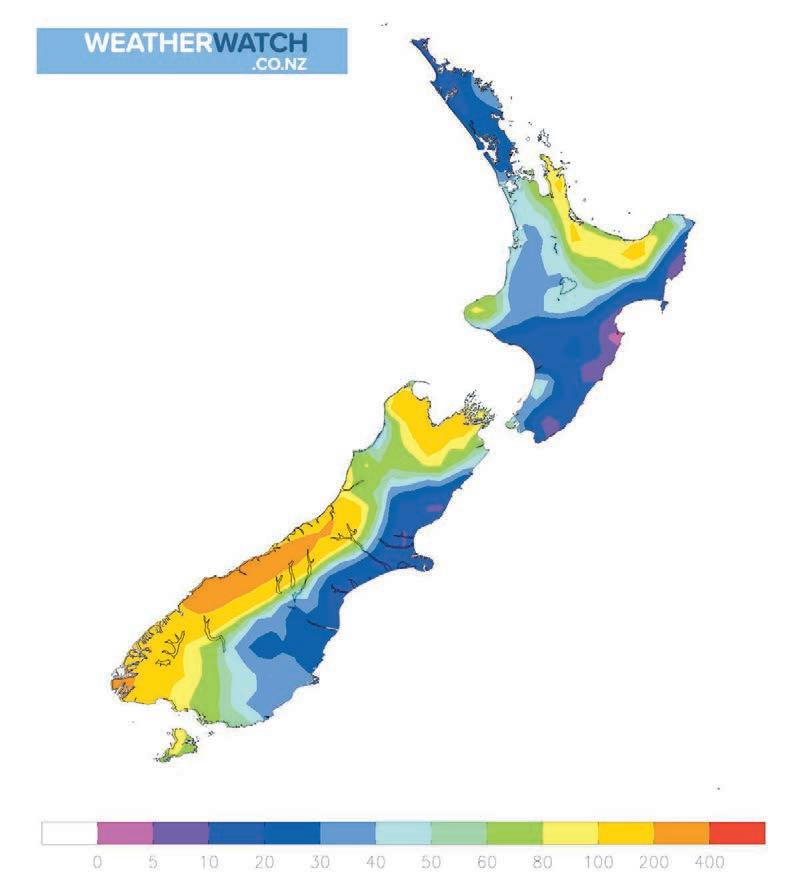
12 years and counting, despite none of them supporting this
current set-up – especially when one review (which was ignored
by Labour) already said change should happen.
In fact, that first review was created by the previous National Government and then ignored by the recent Labour Government. But in Labour’s last month in power it launched a SECOND weather review ... which is now with the coalition government to do something with.
I’m definitely not holding my breath for change because, as you can see, no political party in NZ understands what is broken and why it matters so much to the rural sector. Results of the second independent review have already been stalled three months and counting.
You know that when the weather column gets political we may not have a lot of “weather” to talk about! But, as uncomfortable as it is for me to bang on about this, I feel it’s critical this issue gets sunlight.
While high pressure is dominating NZ at the moment, the tropics are looking more active, so too is the Southern Ocean. It will be the battle of the pressure systems ahead – but in the shortterm high pressure will likely win.
Minimum investment of $100,000 Wholesale investors only
No costs or fees deducted Returns are pre-tax
Finbase provides private investors, family offices and high net worth individuals who meet relevant wholesale investor criteria an investment backed by First Mortgage Security.
Investor security: Funds are utilised to provide First ranking mortgages to commercial borrowers for the purposes of short term property projects, maximum 12 month term of any loan.
Maximum lending of 60% of property value.
We will cover your legal and accounting fees of up to $2,500 to discuss this investment opportunity with your professional advisors, with no obligation for you to invest after doing so.* Finbase is proud to have never missed an investor interest payment nor suffered a single loss of investor capital. Earn a fixed return of 11-12% p.a. with interest paid monthly secured by first mortgage.
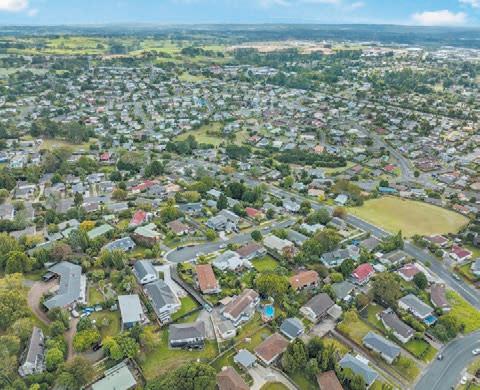
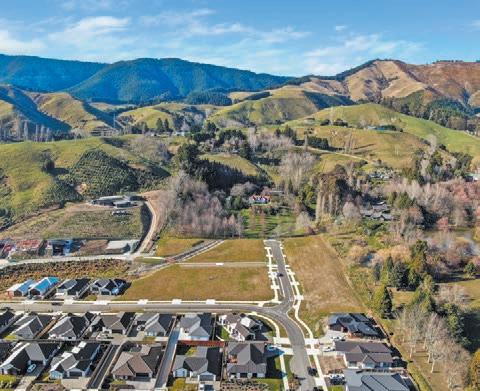


ADVERTISEMENT
Recently funded investments:
For
opportunities contact our portfolio managers
021 143 4291 pernell@finbase.nz 021 253 7816 hayden@finbase.nz 021 375 636 jordan@finbase.nz Pernell Callaghan Hayden Thompson Jordan Evans Finbase is registered as a Financial Services Provider under the Financial Service Providers (Registration and Dispute Resolution) Act 2008 of New Zealand. Its registered number is FSP1003560. *Terms and conditions apply. For marketing purposes the images are of suburb locations, not the specific property. Westgate, Auckland First mortgage security Security description: Freehold section with a land area of circa 200m2 (Land only) CV: $565,000 Loan request: $162,600 Loan to value ratio (LVR): 29% Term: 12 months Interest rate: 11%p.a. paid monthly in arrears Purpose of funds: Equity release for business purposes Exit strategy: Sale of the security asset to repay the debt Takaka, Tasman First mortgage security Security description: Large residential home, on circa 1,240m2 of freehold land Purchase price: $365,000 Loan request: $100,000 Loan to value ratio (LVR): 27% Term: 12 months Interest rate: 12%p.a. paid monthly in arrears Purpose of funds: Funds are being used to build an additional tiny home on the security property Exit strategy: Refinance to main bank to repay the debt upon completion of the tiny home Flat Bush, Auckland First mortgage security Security description: Circa 120m2 residential home, on circa 640m2 of freehold land CV: $1,100,000 Loan request: $596,800 Loan to value ratio (LVR): 54% Term: 12 months Interest rate: 11%p.a. paid monthly in arrears Purpose of funds: Refinance the current lender Exit strategy: Refinance to the main bank to repay the debt once borrower’s accounts are ready 40
investment
For more information visit our website at www.finbase.nz
ruralweather.co.nz
Philip Duncan NEWS Weather
WELCOME RAIN: Rainfall accumulation over seven days starting from 6am Sunday April 14 through to 6am Sunday April 21.


















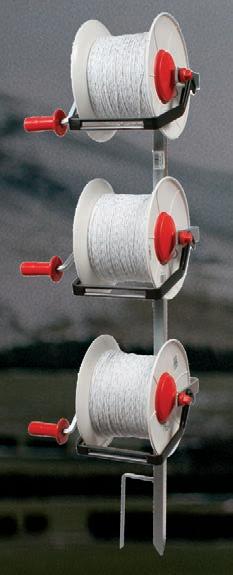










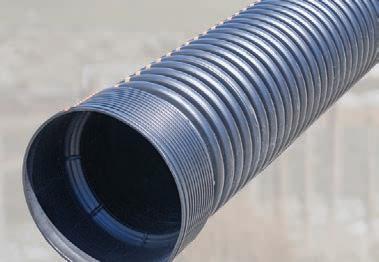

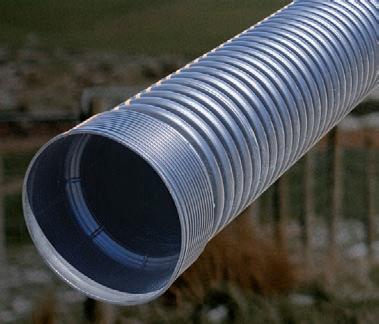




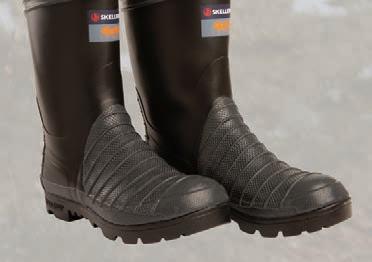






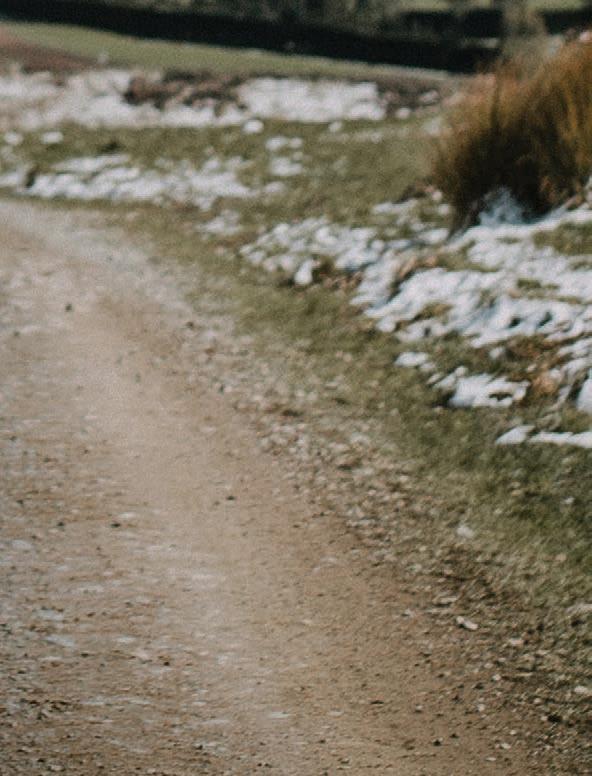

1 FARMLANDS Winter Way your 3 OFPAGES INSIDEDEALS Skellerup Power 4x4 Gumboots $109.99 1024232 OBriens Geared Triple Reel Prewound Polywire 500m $299.95 1003842 Iplex Nexusflo Pipe Punched 25% OFF SAVE $25.00 SAVE $200.00 Page 1 inside Vol 22 No 14, April 15, 2024 View online at farmersweekly.co.nz $4.95 Incl GST



































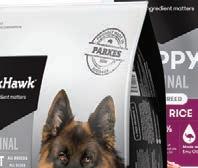
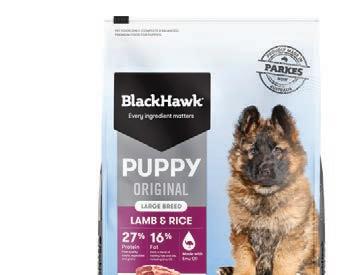
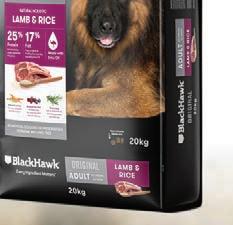








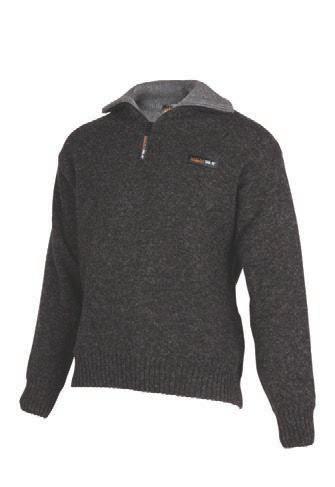


















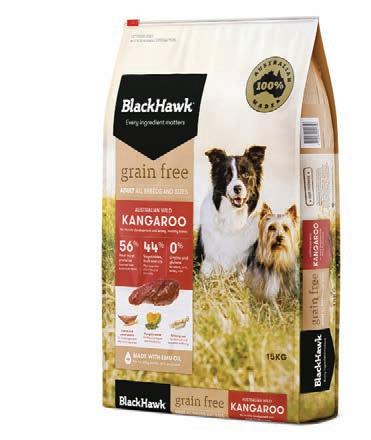








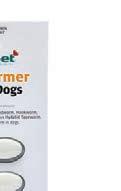

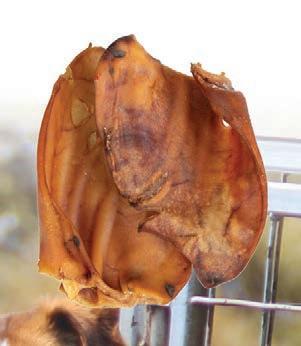

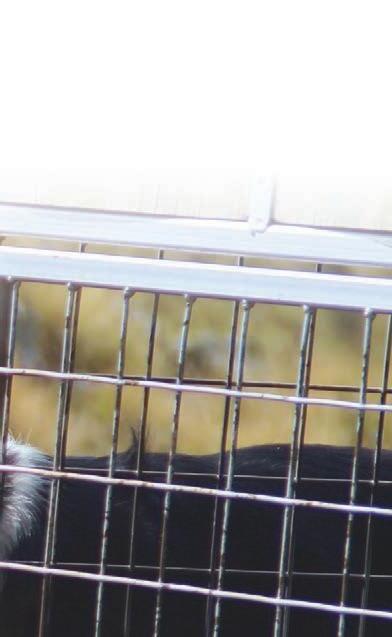

EVERYONE ' S WELCOME For healthier this winter animals For the right this winter layers Grisport Kaweka Moss Boots $329.99 SAVE $50.00 1025164 MKM Tasman Half Zip Pullover $144.95 SAVE $40.00 1024650 Skellerup Power 4x4 Gumboots $109.99 SAVE $25.00 1024232 Betacraft Tuffviz Hi Viz Safety Vest $9.99 SAVE $4.96 1025119 For better protection this winter Showa 330 Re-Grip Glove $13.25 SAVE $4.00 Black Hawk Adult & Puppy 20kg Range $186.89 $9.35 per KG 1023302, 1056414 Black Hawk Grain Free Range 15kg $186 $12.45 per KG 1023288, 1023294 Ari AllWormer Dog Large 50pk $142.00 SAVE $25.95 1049064 Aristopet All Wormer Large Dog 4 pack $22.50 SAVE $4.00 1022758 Pigs Ears Buy 5 for $15.00 SAVE $9.95 1017370 BUY 2 SAVE 20% Swanndri Hoodies & Accessories Drover Brushed Cotton Shirt 2 Pack $46.99 SAVE $10.00 1024223 Betacraft Tuffviz Two Tone Polo $24.99 SAVE $4.96 1032443 Swanndri Barn Shirt Men’s & Women’s 2 FOR $100.00 SAVE $20.00 1024749 1024768 VALUE EVERYDAY VALUE EVERYDAY










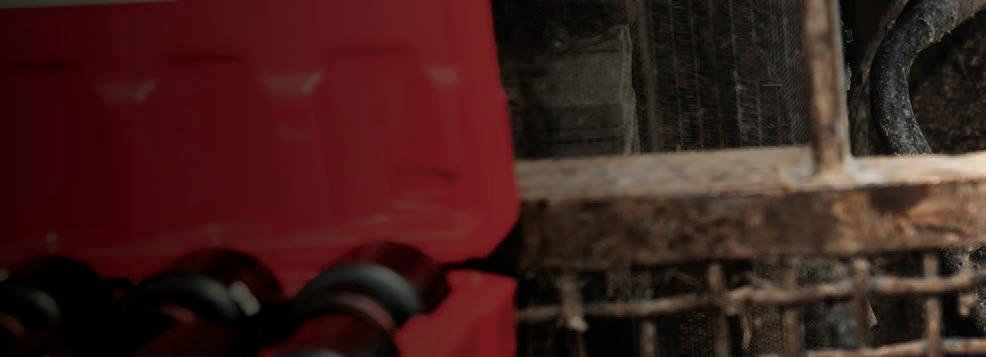










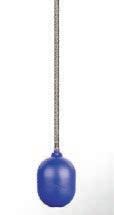


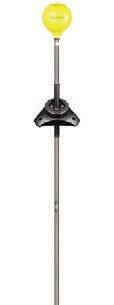












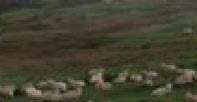



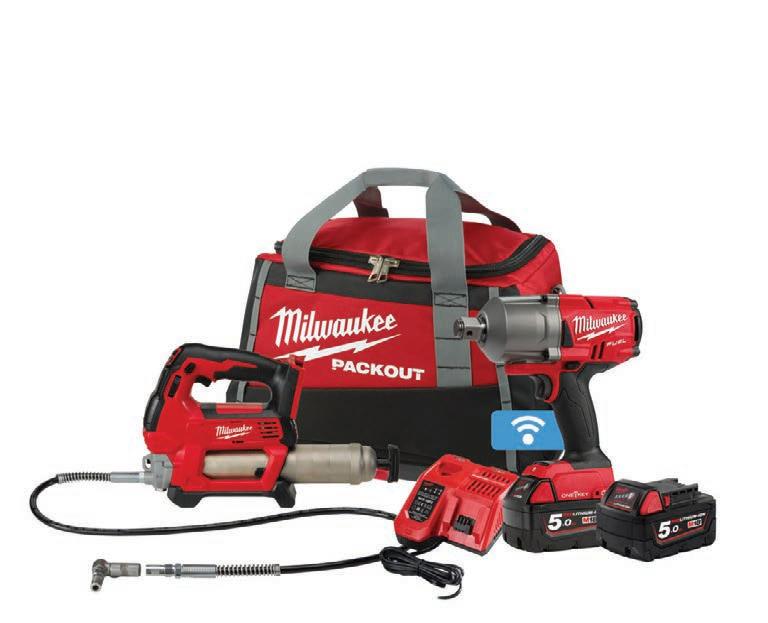
























Hansen Tank Level Alert Indicator $234.95 SAVE $51.00 Hynds Trough Round Protected 1100L $669.99 Plus freight SAVE $224.51 Alkathene Pipe Range Iplex Effluent Pipe PN6 Iplex Nexusflo Pipe Punched M18 FUELTM Hammer Drill/Driver 13mm $499.95 SAVE $53.99 1060605 M18 FUEL Driver 1/4in $379 SAVE $76.00 1060604 FUELTM One Key Hex Utility Drill 7/16in 719.95 SAVE $115.00 the M18 FUELTM Outdoor Powerhead + 1 attachment and get a FREE M18 5.0Ah Redlithium-ION Starter Pack Attachments available: M18 FUEL™ Pole Saw 10 inch 254mm - 1060439 M18 FUEL™ Articulating Hedge Trimmer - 1060428 M18 FUEL™ Edger - 1060482 M18 FUEL™ Line Trimmer - 1060469 M18 FUEL™ Bristle Brush - 1061623 M18 FUEL™ Rubber Broom - 1061624 Order-in only attachments M18 FUEL™ Brushcutter For FOPH System - 1064398 M18 FUEL™ Blower For M18FOPH - 1065315 M18 FUEL™ Cultivator For M18FOPH - 1065316 M18 FUEL™ Bed Redefiner For M18FOPH - 1065317 M18 FUEL™ Reciprocator For M18FOPH - 1065318 M18 FUEL™ Short Hedge Trimmer For M18FOPH - 1065319 buy While stock lasts. Terms and Conditions Apply 30% 25% OFF 20% OFF WE 're BOOK A FARM VISIT WITH A MILWAUKEE SPECIALIST milwaukeetool.co.nz/jss 0800 645 928 FUELTM Hole Hawg Right Angle Drill 604.95 SAVE $60.99 1060615 VALUED AT $529 M18 FUEL™ 2 PIECE POWER PACK 2F2 $1,449.99 SAVE $217.96 1060617 IN-STORE ONLY LIMITED STOCK AVAILABLE GET AN INSTANT BONUS M18™ TRANSFER PUMP M18TP-0 (1060474) KIT INCLUDES • M18 FUEL™ ONE-KEY™ 3/4” High Torque Impact Wrench with Friction Ring • M18™ Cordless 2-Speed Grease Gun • (2) M18™ REDLITHIUM™-ION 5.0Ah Battery • M12™ & M18™ Rapid Charger buy SHAREHOLDER For better use of resources this winter 1004485 For heavy-duty solutions this winter FUELTM Hex Impact $379.95 TM FUEL FUEL FUEL FUEL FUEL OFF M18 $604.95 FUEL $1,449 WHILE STOCK LASTS EXCLUSIVE OFFER 1060475














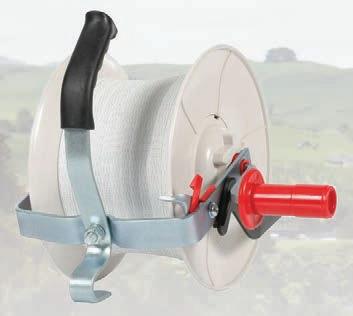

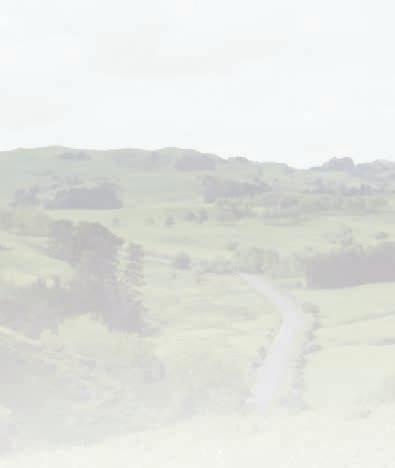







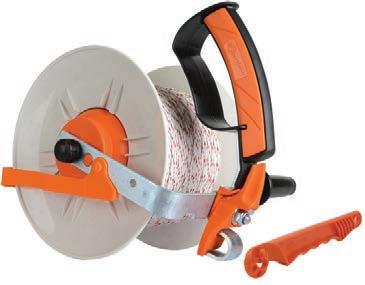

























OBriens Geared Triple Reel Prewound Polywire 500m 299 SAVE $200.00 1003842 For this winter smarter Fencing WE 're OUT HERE TOO Gallagher Geared Reel Prewound Striped Turbo Braid 400m $229.95 SAVE $84.00 1000349 Summit Tite Grip Netting 8/80/30 or 8/90/30 200m $439.00 SAVE $132 1004005 & 1042041 SAVE $2.00 1001727 Summit Tite Grip Netting 8/80/30 or 8/90/30 400m $877.00 SAVE $265.00 1052741 & 1052742 Gallagher Geared Reel Turbo Tape Shield Handle 200m $179.95 SAVE $42.00 1001081 OBriens Geared Reel Prewound Polywire 500m or Polytape 200m $89.95 SAVE $61.00 1004451 & 1001984 Gallagher Geared Reel Prewound Polywire 500m or Pollytape 200m $124.95 SAVE $41.55 1003930 & 1003929 Spend $5,000 incl GST or more on any Summit Steel & Iplex products in a single transaction from 1 April – 31 May and receive a Top Brands, Outstanding Deals: Available at Farmlands Today! $500 Gift Card! *Terms and conditions apply. Offer exclusive to Farmlands. THE SEASON Embrace
















































































































































































 Bryan Gibson Managing editor
Bryan Gibson Managing editor





















































































































































































































































































































































































